Comparative Essay Writing: Methods and Examples
| Danielle McLeod
Danielle McLeod
Danielle McLeod is a highly qualified secondary English Language Arts Instructor who brings a diverse educational background to her classroom. With degrees in science, English, and literacy, she has worked to create cross-curricular materials to bridge learning gaps and help students focus on effective writing and speech techniques. Currently working as a dual credit technical writing instructor at a Career and Technical Education Center, her curriculum development surrounds student focus on effective communication for future career choices.
Writing effective comparative essays requires strategic techniques and thoughtful consideration of common pitfalls. A comparative essay explores the similarities and differences between subjects, allowing the writer to draw conclusions related to the topics of the material.
This article outlines key strategies, such as using transitions, incorporating evidence, and maintaining a formal tone. It also identifies mistakes to avoid, like failing to establish a clear basis for comparison or providing a superficial analysis.
The article emphasizes the importance of revising your comparative essay. This process enables you to refine your analysis, strengthen your arguments, and enhance the overall quality of your work. Incorporating feedback from peers or instructors can elevate your comparative essay and communicate your unique insights more effectively.
Whether you are a student or a professional writer, this guidance can help you craft comparative essays that captivate and inform your audience. Let’s explore the essentials of comparative analysis to enhance your writing prowess.

What is a Comparative Essay?

A comparative essay is a form of academic writing that examines and analyzes two or more subjects, identifying their similarities and differences. This type of essay allows students to develop critical thinking skills by evaluating and contrasting various topic elements.
For example, a comparative analysis of the Roman Empire and the Aztec Empire might make a good history class topic. In contrast, a comparative study of the Harlem Renaissance and the Chicano Art Movement would make a good art class focus.
Types of Comparative Methods
There are two main methods of structuring a comparative essay: the block method and the point-by-point method.
Block Method
- In the block method , you discuss each subject separately.
- You spend one or more paragraphs focusing on the first subject, then move on to the second subject.
- This allows you to go into more detail about each subject before comparing.
- The block method is good when the subjects you’re comparing have many differences or when you want to establish a strong foundation for your comparison.
Point-by-Point Method
- The point-by-point method jumps back and forth between the two subjects.
- In each paragraph, you address a specific point of comparison or contrast between the subjects.
- This structure encourages you to compare the subjects directly, clearly highlighting their similarities and differences.
- The point-by-point method works well when the subjects share clear, significant points of comparison, allowing you to explore their differences and similarities efficiently.
Why are Comparative Essays Important?
Comparative essays are an important part of academic writing because they encourage students to engage in deeper analysis, identify meaningful connections, and better understand the subjects being explored.

By comparing and contrasting different concepts, ideas, or phenomena, students can develop a well-rounded perspective and strengthen their ability to think critically.
What Should You Consider When Selecting Topics for Comparison?
When choosing topics for a comparative essay, it’s important to select subjects with some common ground but distinct differences. This will allow you to conduct a meaningful analysis and draw insightful conclusions. Consider factors such as the subjects’ historical context, cultural influences, or underlying themes to ensure a productive comparison.
For example, using the Block Method, you might do the following;
- Comparing the education systems in the United States and Canada
- Analyzing the differences between classic literature and modern young adult novels
- Contrasting the architectural styles of Gothic cathedrals and Renaissance palaces
In a block method essay on these topics, the writer would devote one or more paragraphs to thoroughly describing and analyzing the first subject (e.g., the US education system, classic literature, Gothic cathedrals) before moving on to discuss the second subject (e.g., the Canadian education system, young adult novels, Renaissance palaces). This would allow the reader to fully understand each topic before the comparative analysis is presented.
Using the Point-by-Point Method might be best used with these topics:
- Comparing the use of symbolism in Ernest Hemingway’s “The Old Man and the Sea” and F. Scott Fitzgerald’s “The Great Gatsby.”
- Contrasting the political ideologies of Abraham Lincoln and Theodore Roosevelt
- Analyzing the similarities and differences in the marketing strategies of Coca-Cola and Pepsi
In a point-by-point comparative essay, the writer would alternate between the two subjects in each paragraph, directly comparing and contrasting specific elements (e.g., how symbolism is used, political views, and marketing tactics). This would encourage a more integrated analysis of the similarities and differences between the subjects.
How Can You Brainstorm for a Comparative Essay?
To begin brainstorming for a comparative essay, start by creating a Venn diagram to visually organize the similarities and differences between your chosen topics. This can help you identify key points of comparison and contrast, which will form the foundation of your essay.

Additionally, consider writing down any questions or observations that arise during this process, as they may guide your subsequent research and analysis.
How Should You Formulate a Thesis Statement for a Comparative Essay?
A thesis statement is a one- or two-sentence summary that conveys a comparative essay’s main argument, focus, or purpose. It provides the reader with an overview of the essay’s central claim, which the rest of the paper will work to develop and support.
Your comparative essay’s thesis statement should clearly explain the central argument or insight that your analysis will explore. This statement should go beyond simply identifying the subjects being compared and instead make a substantive claim about the relationship between them. A strong comparative essay thesis will establish the basis for your comparative analysis and provide a roadmap for the rest of your essay.
For example, using the examples mentioned above, consider these options:
- “Classic literature and modern young adult novels differ greatly in their thematic depth, complexity of characterization, and use of literary devices, though both genres can provide valuable insights into the human experience.”
- “Gothic cathedrals and Renaissance palaces represent vastly contrasting architectural styles, with Gothic structures emphasizing verticality, pointed arches, and religious symbolism, while Renaissance palaces showcase classical proportions, ornate facades, and secular grandeur.”
- “Ernest Hemingway’s ‘The Old Man and the Sea’ and F. Scott Fitzgerald’s ‘The Great Gatsby’ both employ symbolic imagery to explore themes of the human condition, but they do so in strikingly different ways that reflect the author’s distinct writing styles and philosophical perspectives.”
- “Though Abraham Lincoln and Theodore Roosevelt held vastly different political ideologies, with Lincoln championing a strong federal government and Roosevelt advocating for a more progressive, regulatory approach, both presidents played pivotal roles in shaping the course of American history.”
What Strategies Should You Employ When Writing Comparative Essays?

When writing a comparative essay, it’s important to employ various strategies to effectively communicate your analysis. This may include using transition words and phrases to establish connections between ideas, incorporating relevant examples or evidence to support your claims, and maintaining a formal, academic tone throughout your writing.
Additionally, consider incorporating a Venn diagram or other visual aids to enhance your comparative analysis.
Strategies for Comparative Essays
To recap, use the following strategies in your work to help organize and structure your essay:
Use Effective Transitions
- Words/phrases like “in contrast,” “on the other hand,” “similarly,” “conversely,” etc.
- Help establish clear connections between ideas and comparisons.
Provide Relevant Examples and Evidence
- Draw from the subjects being compared to support your claims
- Use specific details, quotes, or data to strengthen your analysis
Maintain a Formal, Academic Tone
- Avoid casual or conversational language
- Focus on objective, analytical writing
Incorporate Visual Aids (if appropriate)
- Venn diagrams, tables, or other graphics can effectively illustrate comparisons
- Help the reader visualize the relationships between the subjects
Structure Logically
- Use either the block method or point-by-point organization
- Ensure a clear, coherent flow of ideas
Address Counterarguments or Limitations
- Acknowledge and respond to potential objections or alternative perspectives.
- Demonstrates depth of understanding
Which Mistakes Should You Be Careful of in Comparative Essay Writing?
Here are some examples to illustrate the common mistakes to avoid when writing comparative essays:
Failing to establish a clear basis for comparison
- Attempting to compare the plot of a novel to the musical score of an opera without explaining the relevance of that comparison
- Contrasting two political ideologies without defining the key criteria being used to evaluate them
Neglecting to address significant differences or similarities
- Comparing the leadership styles of two presidents but failing to discuss their differing approaches to domestic or foreign policy
- Analyzing the architectural features of Gothic cathedrals and Renaissance palaces without acknowledging their shared use of symmetry and classical proportions
Providing a superficial or unbalanced analysis
- Dedicating a single paragraph to analyzing the complex socioeconomic factors that shaped the development of two education systems
- The majority of the essay focused on the differences between the two subjects while only briefly mentioning their similarities.
Relying too heavily on plot summary or description
- Retelling the narratives of two novels in detail without delving into a comparative analysis of their themes, character development, or stylistic elements
- Extensively describing the physical attributes of two historical buildings without explaining how those features reflect the broader architectural movements.
Lacking a cohesive and logical organizational structure
- Jumping back and forth between discussing the two subjects without a clear basis for the order or flow of ideas
- Using the block method but failing to create a smooth transition between the sections devoted to each subject
Incorporating specific, relevant examples for each of these potential pitfalls can help illustrate the importance of avoiding them in comparative essay writing. These tips can help you when you just wish you could ask something to “ write my essay for me .”
Why is Revising Your Comparative Essay Crucial?

Revising your comparative essay is always considered an important step in the writing process, as it allows you to refine your analysis, strengthen your arguments, and ensure the overall explanation of connections and effectiveness of your essay.
During the revision stage, consider seeking feedback from peers or instructors. Their perspectives can help you identify areas for improvement and enhance the quality of your comparative essay.
Reasons to Revise Comparative Essays
Refine Your Analysis
- Example: Upon revision, you realize your comparison of two political ideologies lacks nuance and fails to acknowledge the complexities within each position. You then expand your analysis to provide a more nuanced and balanced perspective.
Strengthen Your Arguments
- Example: During revision, you identify gaps in your supporting evidence for a key point contrasting the marketing strategies of two rival companies. You then incorporate additional data and examples to bolster your comparative claims.
Ensure Coherence and Organization
- Example: In reviewing your essay, you recognize that your use of the point-by-point method is causing your comparisons to feel disjointed. You then reorganize your essay to follow a more cohesive block structure, improving the overall flow of ideas.
Incorporate Peer/Instructor Feedback
- Example: After receiving feedback from your instructor, you realize your comparison of two literary works does not adequately address a significant thematic similarity. You then revise the essay to incorporate this overlooked element into your analysis.
Enhance the Overall Quality
- Example: During the revision process, you identify opportunities to improve the clarity and precision of your language, ensuring your comparative essay communicates your insights effectively to the reader.
A comparative essay is a valuable academic writing exercise that encourages critical thinking, in-depth analysis, and the development of essential written communication skills. By mastering the structure, thesis formulation, and writing strategies associated with comparative essays, students can enhance their ability to engage in thoughtful, well-reasoned comparisons and effectively convey their research, discoveries, and opinions to their audience.
Grammarist is a participant in the Amazon Services LLC Associates Program, an affiliate advertising program designed to provide a means for sites to earn advertising fees by advertising and linking to Amazon.com. When you buy via the links on our site, we may earn an affiliate commission at no cost to you.
2024 © Grammarist, a Found First Marketing company. All rights reserved.
5 Compare and Contrast Essay Examples (Full Text)

Chris Drew (PhD)
Dr. Chris Drew is the founder of the Helpful Professor. He holds a PhD in education and has published over 20 articles in scholarly journals. He is the former editor of the Journal of Learning Development in Higher Education. [Image Descriptor: Photo of Chris]
Learn about our Editorial Process
A compare and contrast essay selects two or more items that are critically analyzed to demonstrate their differences and similarities. Here is a template for you that provides the general structure:

A range of example essays is presented below.
Compare and Contrast Essay Examples
#1 jean piaget vs lev vygotsky essay.
1480 Words | 5 Pages | 10 References
(Level: University Undergraduate)

Thesis Statement: “This essay will critically examine and compare the developmental theories of Jean Piaget and Lev Vygotsky, focusing on their differing views on cognitive development in children and their influence on educational psychology, through an exploration of key concepts such as the role of culture and environment, scaffolding, equilibration, and their overall implications for educational practices..”
#2 Democracy vs Authoritarianism Essay

Thesis Statement: “The thesis of this analysis is that, despite the efficiency and control offered by authoritarian regimes, democratic systems, with their emphasis on individual freedoms, participatory governance, and social welfare, present a more balanced and ethically sound approach to governance, better aligned with the ideals of a just and progressive society.”
#3 Apples vs Oranges Essay
1190 Words | 5 Pages | 0 References
(Level: 4th Grade, 5th Grade, 6th Grade)

Thesis Statement: “While apples and oranges are both popular and nutritious fruits, they differ significantly in their taste profiles, nutritional benefits, cultural symbolism, and culinary applications.”
#4 Nature vs Nurture Essay
1525 Words | 5 Pages | 11 References
(Level: High School and College)

Thesis Statement: “The purpose of this essay is to examine and elucidate the complex and interconnected roles of genetic inheritance (nature) and environmental influences (nurture) in shaping human development across various domains such as physical traits, personality, behavior, intelligence, and abilities.”
#5 Dogs vs Cats Essay
1095 Words | 5 Pages | 7 Bibliographic Sources
(Level: 6th Grade, 7th Grade, 8th Grade)
Thesis Statement: “This essay explores the distinctive characteristics, emotional connections, and lifestyle considerations associated with owning dogs and cats, aiming to illuminate the unique joys and benefits each pet brings to their human companions.”
How to Write a Compare and Contrast Essay
I’ve recorded a full video for you on how to write a compare and contrast essay:
Get the Compare and Contrast Templates with AI Prompts Here
In the video, I outline the steps to writing your essay. Here they are explained below:
1. Essay Planning
First, I recommend using my compare and contrast worksheet, which acts like a Venn Diagram, walking you through the steps of comparing the similarities and differences of the concepts or items you’re comparing.
I recommend selecting 3-5 features that can be compared, as shown in the worksheet:

Grab the Worksheet as Part of the Compare and Contrast Essay Writing Pack
2. Writing the Essay
Once you’ve completed the worksheet, you’re ready to start writing. Go systematically through each feature you are comparing and discuss the similarities and differences, then make an evaluative statement after showing your depth of knowledge:

Get the Rest of the Premium Compare and Contrast Essay Writing Pack (With AI Prompts) Here
How to Write a Compare and Contrast Thesis Statement
Compare and contrast thesis statements can either:
- Remain neutral in an expository tone.
- Prosecute an argument about which of the items you’re comparing is overall best.
To write an argumentative thesis statement for a compare and contrast essay, try this AI Prompts:
💡 AI Prompt to Generate Ideas I am writing a compare and contrast essay that compares [Concept 1] and [Concept2]. Give me 5 potential single-sentence thesis statements that pass a reasonable judgement.
Ready to Write your Essay?

Take action! Choose one of the following options to start writing your compare and contrast essay now:
Read Next: Process Essay Examples

- Chris Drew (PhD) https://helpfulprofessor.com/author/chris-drew-phd-2/ 10 Reasons you’re Perpetually Single
- Chris Drew (PhD) https://helpfulprofessor.com/author/chris-drew-phd-2/ 20 Montessori Toddler Bedrooms (Design Inspiration)
- Chris Drew (PhD) https://helpfulprofessor.com/author/chris-drew-phd-2/ 21 Montessori Homeschool Setups
- Chris Drew (PhD) https://helpfulprofessor.com/author/chris-drew-phd-2/ 101 Hidden Talents Examples
Leave a Comment Cancel Reply
Your email address will not be published. Required fields are marked *
- College Essay
- Argumentative Essay
- Expository Essay
- Narrative Essay
- Descriptive Essay
- Scholarship Essay
- Admission Essay
- Reflective Essay
- Nursing Essay
- Economics Essay
Assignments
- Term Papers
- Research Papers
- Case Studies
- Dissertation
- Presentation
- Editing Help
- Cheap Essay Writing
- How to Order
Comparative Essay
How to Write a Comparative Essay – A Complete Guide
10 min read
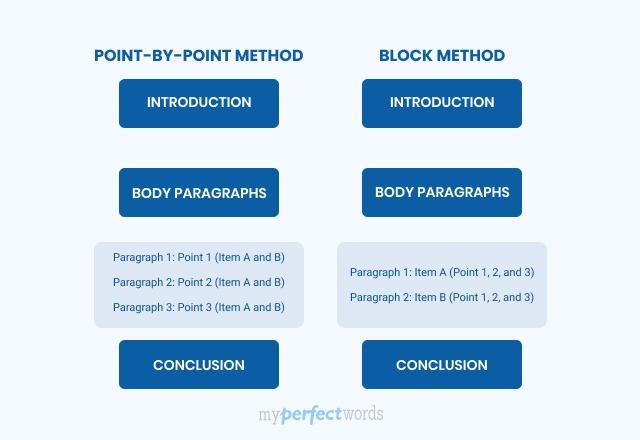
People also read
Learn How to Write an Editorial on Any Topic
Best Tips on How to Avoid Plagiarism
How to Write a Movie Review - Guide & Examples
A Complete Guide on How to Write a Summary for Students
Write Opinion Essay Like a Pro: A Detailed Guide
Evaluation Essay - Definition, Examples, and Writing Tips
How to Write a Thematic Statement - Tips & Examples
How to Write a Bio - Quick Tips, Structure & Examples
How to Write a Synopsis – A Simple Format & Guide
Visual Analysis Essay - A Writing Guide with Format & Sample
List of Common Social Issues Around the World
Writing Character Analysis - Outline, Steps, and Examples
11 Common Types of Plagiarism Explained Through Examples
Article Review Writing: A Complete Step-by-Step Guide with Examples
A Detailed Guide on How to Write a Poem Step by Step
Detailed Guide on Appendix Writing: With Tips and Examples
Comparative essay is a common assignment for school and college students. Many students are not aware of the complexities of crafting a strong comparative essay.
If you too are struggling with this, don't worry!
In this blog, you will get a complete writing guide for comparative essay writing. From structuring formats to creative topics, this guide has it all.
So, keep reading!
- 1. What is a Comparative Essay?
- 2. Comparative Essay Structure
- 3. How to Start a Comparative Essay?
- 4. How to Write a Comparative Essay?
- 5. Comparative Essay Examples
- 6. Comparative Essay Topics
- 7. Tips for Writing A Good Comparative Essay
- 8. Transition Words For Comparative Essays
What is a Comparative Essay?
A comparative essay is a type of essay in which an essay writer compares at least two or more items. The author compares two subjects with the same relation in terms of similarities and differences depending on the assignment.
The main purpose of the comparative essay is to:
- Highlight the similarities and differences in a systematic manner.
- Provide great clarity of the subject to the readers.
- Analyze two things and describe their advantages and drawbacks.
A comparative essay is also known as compare and contrast essay or a comparison essay. It analyzes two subjects by either comparing them, contrasting them, or both. The Venn diagram is the best tool for writing a paper about the comparison between two subjects.
Moreover, a comparative analysis essay discusses the similarities and differences of themes, items, events, views, places, concepts, etc. For example, you can compare two different novels (e.g., The Adventures of Huckleberry Finn and The Red Badge of Courage).
However, a comparative essay is not limited to specific topics. It covers almost every topic or subject with some relation.
Comparative Essay Structure
A good comparative essay is based on how well you structure your essay. It helps the reader to understand your essay better.
The structure is more important than what you write. This is because it is necessary to organize your essay so that the reader can easily go through the comparisons made in an essay.
The following are the two main methods in which you can organize your comparative essay.
Point-by-Point Method
The point-by-point or alternating method provides a detailed overview of the items that you are comparing. In this method, organize items in terms of similarities and differences.
This method makes the writing phase easy for the writer to handle two completely different essay subjects. It is highly recommended where some depth and detail are required.
Below given is the structure of the point-by-point method.
|
Block Method
The block method is the easiest as compared to the point-by-point method. In this method, you divide the information in terms of parameters. It means that the first paragraph compares the first subject and all their items, then the second one compares the second, and so on.
However, make sure that you write the subject in the same order. This method is best for lengthy essays and complicated subjects.
Here is the structure of the block method.
Therefore, keep these methods in mind and choose the one according to the chosen subject.
Mixed Paragraphs Method
In this method, one paragraph explains one aspect of the subject. As a writer, you will handle one point at a time and one by one. This method is quite beneficial as it allows you to give equal weightage to each subject and help the readers identify the point of comparison easily.
How to Start a Comparative Essay?
Here, we have gathered some steps that you should follow to start a well-written comparative essay.
Choose a Topic
The foremost step in writing a comparative essay is to choose a suitable topic.
Choose a topic or theme that is interesting to write about and appeals to the reader.
An interesting essay topic motivates the reader to know about the subject. Also, try to avoid complicated topics for your comparative essay.
Develop a List of Similarities and Differences
Create a list of similarities and differences between two subjects that you want to include in the essay. Moreover, this list helps you decide the basis of your comparison by constructing your initial plan.
Evaluate the list and establish your argument and thesis statement .
Establish the Basis for Comparison
The basis for comparison is the ground for you to compare the subjects. In most cases, it is assigned to you, so check your assignment or prompt.
Furthermore, the main goal of the comparison essay is to inform the reader of something interesting. It means that your subject must be unique to make your argument interesting.
Do the Research
In this step, you have to gather information for your subject. If your comparative essay is about social issues, historical events, or science-related topics, you must do in-depth research.
However, make sure that you gather data from credible sources and cite them properly in the essay.
Create an Outline
An essay outline serves as a roadmap for your essay, organizing key elements into a structured format.
With your topic, list of comparisons, basis for comparison, and research in hand, the next step is to create a comprehensive outline.
Here is a standard comparative essay outline:
Subject B Analysis Subject B Analysis
|
How to Write a Comparative Essay?
Now that you have the basic information organized in an outline, you can get started on the writing process.
Here are the essential parts of a comparative essay:
Comparative Essay Introduction
Start off by grabbing your reader's attention in the introduction . Use something catchy, like a quote, question, or interesting fact about your subjects.
Then, give a quick background so your reader knows what's going on.
The most important part is your thesis statement, where you state the main argument , the basis for comparison, and why the comparison is significant.
This is what a typical thesis statement for a comparative essay looks like:
Comparative Essay Body Paragraphs
The body paragraphs are where you really get into the details of your subjects. Each paragraph should focus on one thing you're comparing.
Start by talking about the first point of comparison. Then, go on to the next points. Make sure to talk about two to three differences to give a good picture.
After that, switch gears and talk about the things they have in common. Just like you discussed three differences, try to cover three similarities.
This way, your essay stays balanced and fair. This approach helps your reader understand both the ways your subjects are different and the ways they are similar. Keep it simple and clear for a strong essay.
Comparative Essay Conclusion
In your conclusion , bring together the key insights from your analysis to create a strong and impactful closing.
Consider the broader context or implications of the subjects' differences and similarities. What do these insights reveal about the broader themes or ideas you're exploring?
Discuss the broader implications of these findings and restate your thesis. Avoid introducing new information and end with a thought-provoking statement that leaves a lasting impression.
Below is the detailed comparative essay template format for you to understand better.
Comparative Essay Format
Comparative Essay Examples
Have a look at these comparative essay examples pdf to get an idea of the perfect essay.
Comparative Essay on Summer and Winter
Comparative Essay on Books vs. Movies
Comparative Essay Sample
Comparative Essay Thesis Example
Comparative Essay on Football vs Cricket
Comparative Essay on Pet and Wild Animals
Comparative Essay Topics
Comparative essay topics are not very difficult or complex. Check this list of essay topics and pick the one that you want to write about.
- How do education and employment compare?
- Living in a big city or staying in a village.
- The school principal or college dean.
- New Year vs. Christmas celebration.
- Dried Fruit vs. Fresh. Which is better?
- Similarities between philosophy and religion.
- British colonization and Spanish colonization.
- Nuclear power for peace or war?
- Bacteria or viruses.
- Fast food vs. homemade food.
Tips for Writing A Good Comparative Essay
Writing a compelling comparative essay requires thoughtful consideration and strategic planning. Here are some valuable tips to enhance the quality of your comparative essay:
- Clearly define what you're comparing, like themes or characters.
- Plan your essay structure using methods like point-by-point or block paragraphs.
- Craft an introduction that introduces subjects and states your purpose.
- Ensure an equal discussion of both similarities and differences.
- Use linking words for seamless transitions between paragraphs.
- Gather credible information for depth and authenticity.
- Use clear and simple language, avoiding unnecessary jargon.
- Dedicate each paragraph to a specific point of comparison.
- Summarize key points, restate the thesis, and emphasize significance.
- Thoroughly check for clarity, coherence, and correct any errors.
Transition Words For Comparative Essays
Transition words are crucial for guiding your reader through the comparative analysis. They help establish connections between ideas and ensure a smooth flow in your essay.
Here are some transition words and phrases to improve the flow of your comparative essay:
Transition Words for Similarities
- Correspondingly
- In the same vein
- In like manner
- In a similar fashion
- In tandem with
Transition Words for Differences
- On the contrary
- In contrast
- Nevertheless
- In spite of
- Notwithstanding
- On the flip side
- In contradistinction
Check out this blog listing more transition words that you can use to enhance your essay’s coherence!
In conclusion, now that you have the important steps and helpful tips to write a good comparative essay, you can start working on your own essay.
However, if you find it tough to begin, all you have to do is say ' just do my essay ' and we'll get started.
Our skilled writers can handle any type of essay or assignment you need. So, don't wait—place your order now and make your academic journey easier!
Frequently Asked Question
How long is a comparative essay.
A comparative essay is 4-5 pages long, but it depends on your chosen idea and topic.
How do you end a comparative essay?
Here are some tips that will help you to end the comparative essay.
- Restate the thesis statement
- Wrap up the entire essay
- Highlight the main points

Write Essay Within 60 Seconds!

Dr. Barbara is a highly experienced writer and author who holds a Ph.D. degree in public health from an Ivy League school. She has worked in the medical field for many years, conducting extensive research on various health topics. Her writing has been featured in several top-tier publications.

Paper Due? Why Suffer? That’s our Job!
Keep reading
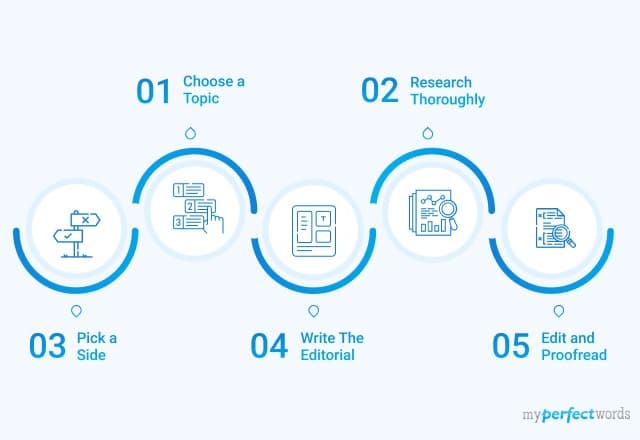
Have a language expert improve your writing
Run a free plagiarism check in 10 minutes, generate accurate citations for free.
- Knowledge Base
- Comparing and contrasting in an essay | Tips & examples
Comparing and Contrasting in an Essay | Tips & Examples
Published on August 6, 2020 by Jack Caulfield . Revised on July 23, 2023.
Comparing and contrasting is an important skill in academic writing . It involves taking two or more subjects and analyzing the differences and similarities between them.
Instantly correct all language mistakes in your text
Upload your document to correct all your mistakes in minutes

Table of contents
When should i compare and contrast, making effective comparisons, comparing and contrasting as a brainstorming tool, structuring your comparisons, other interesting articles, frequently asked questions about comparing and contrasting.
Many assignments will invite you to make comparisons quite explicitly, as in these prompts.
- Compare the treatment of the theme of beauty in the poetry of William Wordsworth and John Keats.
- Compare and contrast in-class and distance learning. What are the advantages and disadvantages of each approach?
Some other prompts may not directly ask you to compare and contrast, but present you with a topic where comparing and contrasting could be a good approach.
One way to approach this essay might be to contrast the situation before the Great Depression with the situation during it, to highlight how large a difference it made.
Comparing and contrasting is also used in all kinds of academic contexts where it’s not explicitly prompted. For example, a literature review involves comparing and contrasting different studies on your topic, and an argumentative essay may involve weighing up the pros and cons of different arguments.
Here's why students love Scribbr's proofreading services
Discover proofreading & editing
As the name suggests, comparing and contrasting is about identifying both similarities and differences. You might focus on contrasting quite different subjects or comparing subjects with a lot in common—but there must be some grounds for comparison in the first place.
For example, you might contrast French society before and after the French Revolution; you’d likely find many differences, but there would be a valid basis for comparison. However, if you contrasted pre-revolutionary France with Han-dynasty China, your reader might wonder why you chose to compare these two societies.
This is why it’s important to clarify the point of your comparisons by writing a focused thesis statement . Every element of an essay should serve your central argument in some way. Consider what you’re trying to accomplish with any comparisons you make, and be sure to make this clear to the reader.
Comparing and contrasting can be a useful tool to help organize your thoughts before you begin writing any type of academic text. You might use it to compare different theories and approaches you’ve encountered in your preliminary research, for example.
Let’s say your research involves the competing psychological approaches of behaviorism and cognitive psychology. You might make a table to summarize the key differences between them.
| Behaviorism | Cognitive psychology |
|---|---|
| Dominant from the 1920s to the 1950s | Rose to prominence in the 1960s |
| Mental processes cannot be empirically studied | Mental processes as focus of study |
| Focuses on how thinking is affected by conditioning and environment | Focuses on the cognitive processes themselves |
Or say you’re writing about the major global conflicts of the twentieth century. You might visualize the key similarities and differences in a Venn diagram.

These visualizations wouldn’t make it into your actual writing, so they don’t have to be very formal in terms of phrasing or presentation. The point of comparing and contrasting at this stage is to help you organize and shape your ideas to aid you in structuring your arguments.
When comparing and contrasting in an essay, there are two main ways to structure your comparisons: the alternating method and the block method.
The alternating method
In the alternating method, you structure your text according to what aspect you’re comparing. You cover both your subjects side by side in terms of a specific point of comparison. Your text is structured like this:
Mouse over the example paragraph below to see how this approach works.
One challenge teachers face is identifying and assisting students who are struggling without disrupting the rest of the class. In a traditional classroom environment, the teacher can easily identify when a student is struggling based on their demeanor in class or simply by regularly checking on students during exercises. They can then offer assistance quietly during the exercise or discuss it further after class. Meanwhile, in a Zoom-based class, the lack of physical presence makes it more difficult to pay attention to individual students’ responses and notice frustrations, and there is less flexibility to speak with students privately to offer assistance. In this case, therefore, the traditional classroom environment holds the advantage, although it appears likely that aiding students in a virtual classroom environment will become easier as the technology, and teachers’ familiarity with it, improves.
The block method
In the block method, you cover each of the overall subjects you’re comparing in a block. You say everything you have to say about your first subject, then discuss your second subject, making comparisons and contrasts back to the things you’ve already said about the first. Your text is structured like this:
- Point of comparison A
- Point of comparison B
The most commonly cited advantage of distance learning is the flexibility and accessibility it offers. Rather than being required to travel to a specific location every week (and to live near enough to feasibly do so), students can participate from anywhere with an internet connection. This allows not only for a wider geographical spread of students but for the possibility of studying while travelling. However, distance learning presents its own accessibility challenges; not all students have a stable internet connection and a computer or other device with which to participate in online classes, and less technologically literate students and teachers may struggle with the technical aspects of class participation. Furthermore, discomfort and distractions can hinder an individual student’s ability to engage with the class from home, creating divergent learning experiences for different students. Distance learning, then, seems to improve accessibility in some ways while representing a step backwards in others.
Note that these two methods can be combined; these two example paragraphs could both be part of the same essay, but it’s wise to use an essay outline to plan out which approach you’re taking in each paragraph.
Prevent plagiarism. Run a free check.
If you want to know more about AI tools , college essays , or fallacies make sure to check out some of our other articles with explanations and examples or go directly to our tools!
- Ad hominem fallacy
- Post hoc fallacy
- Appeal to authority fallacy
- False cause fallacy
- Sunk cost fallacy
College essays
- Choosing Essay Topic
- Write a College Essay
- Write a Diversity Essay
- College Essay Format & Structure
- Comparing and Contrasting in an Essay
(AI) Tools
- Grammar Checker
- Paraphrasing Tool
- Text Summarizer
- AI Detector
- Plagiarism Checker
- Citation Generator
Some essay prompts include the keywords “compare” and/or “contrast.” In these cases, an essay structured around comparing and contrasting is the appropriate response.
Comparing and contrasting is also a useful approach in all kinds of academic writing : You might compare different studies in a literature review , weigh up different arguments in an argumentative essay , or consider different theoretical approaches in a theoretical framework .
Your subjects might be very different or quite similar, but it’s important that there be meaningful grounds for comparison . You can probably describe many differences between a cat and a bicycle, but there isn’t really any connection between them to justify the comparison.
You’ll have to write a thesis statement explaining the central point you want to make in your essay , so be sure to know in advance what connects your subjects and makes them worth comparing.
Comparisons in essays are generally structured in one of two ways:
- The alternating method, where you compare your subjects side by side according to one specific aspect at a time.
- The block method, where you cover each subject separately in its entirety.
It’s also possible to combine both methods, for example by writing a full paragraph on each of your topics and then a final paragraph contrasting the two according to a specific metric.
Cite this Scribbr article
If you want to cite this source, you can copy and paste the citation or click the “Cite this Scribbr article” button to automatically add the citation to our free Citation Generator.
Caulfield, J. (2023, July 23). Comparing and Contrasting in an Essay | Tips & Examples. Scribbr. Retrieved October 12, 2024, from https://www.scribbr.com/academic-essay/compare-and-contrast/
Is this article helpful?

Jack Caulfield
Other students also liked, how to write an expository essay, how to write an argumentative essay | examples & tips, academic paragraph structure | step-by-step guide & examples, get unlimited documents corrected.
✔ Free APA citation check included ✔ Unlimited document corrections ✔ Specialized in correcting academic texts
- Writing Home
- Writing Advice Home
The Comparative Essay
- Printable PDF Version
- Fair-Use Policy
What is a comparative essay?
A comparative essay asks that you compare at least two (possibly more) items. These items will differ depending on the assignment. You might be asked to compare
- positions on an issue (e.g., responses to midwifery in Canada and the United States)
- theories (e.g., capitalism and communism)
- figures (e.g., GDP in the United States and Britain)
- texts (e.g., Shakespeare’s Hamlet and Macbeth )
- events (e.g., the Great Depression and the global financial crisis of 2008–9)
Although the assignment may say “compare,” the assumption is that you will consider both the similarities and differences; in other words, you will compare and contrast.
Make sure you know the basis for comparison
The assignment sheet may say exactly what you need to compare, or it may ask you to come up with a basis for comparison yourself.
- Provided by the essay question: The essay question may ask that you consider the figure of the gentleman in Charles Dickens’s Great Expectations and Anne Brontë’s The Tenant of Wildfell Hall . The basis for comparison will be the figure of the gentleman.
- Developed by you: The question may simply ask that you compare the two novels. If so, you will need to develop a basis for comparison, that is, a theme, concern, or device common to both works from which you can draw similarities and differences.
Develop a list of similarities and differences
Once you know your basis for comparison, think critically about the similarities and differences between the items you are comparing, and compile a list of them.
For example, you might decide that in Great Expectations , being a true gentleman is not a matter of manners or position but morality, whereas in The Tenant of Wildfell Hall , being a true gentleman is not about luxury and self-indulgence but hard work and productivity.
The list you have generated is not yet your outline for the essay, but it should provide you with enough similarities and differences to construct an initial plan.
Develop a thesis based on the relative weight of similarities and differences
Once you have listed similarities and differences, decide whether the similarities on the whole outweigh the differences or vice versa. Create a thesis statement that reflects their relative weights. A more complex thesis will usually include both similarities and differences. Here are examples of the two main cases:
While Callaghan’s “All the Years of Her Life” and Mistry’s “Of White Hairs and Cricket” both follow the conventions of the coming-of-age narrative, Callaghan’s story adheres more closely to these conventions by allowing its central protagonist to mature. In Mistry’s story, by contrast, no real growth occurs.
Although Darwin and Lamarck came to different conclusions about whether acquired traits can be inherited, they shared the key distinction of recognizing that species evolve over time.
Come up with a structure for your essay
| A | Paragraph 1 in body | new technology and the French Revolution |
| B | Paragraph 2 in body | new technology and the Russian Revolution |
| A | Paragraph 3 in body | military strategy and the French Revolution |
| B | Paragraph 4 in body | military strategy and the Russian Revolution |
| A | Paragraph 5 in body | administrative system and the French Revolution |
| B | Paragraph 6 in body | administrative system and the Russian Revolution |
Note that the French and Russian revolutions (A and B) may be dissimilar rather than similar in the way they affected innovation in any of the three areas of technology, military strategy, and administration. To use the alternating method, you just need to have something noteworthy to say about both A and B in each area. Finally, you may certainly include more than three pairs of alternating points: allow the subject matter to determine the number of points you choose to develop in the body of your essay.
| A | Paragraphs 1–3 in body | How the French Revolution encouraged or thwarted innovation |
| B | Paragraphs 4–6 in body | How the Russian Revolution encouraged or thwarted innovation |
When do I use the block method? The block method is particularly useful in the following cases:
- You are unable to find points about A and B that are closely related to each other.
- Your ideas about B build upon or extend your ideas about A.
- You are comparing three or more subjects as opposed to the traditional two.
- Share full article
Advertisement
Supported by
Mentor Texts
Writing Comparative Essays: Making Connections to Illuminate Ideas
Breathing new life into a familiar school format, with the help of Times journalism and several winning student essays.

By Katherine Schulten
Our new Mentor Text series spotlights writing from The Times and from our student contests that teenagers can learn from and emulate.
This entry aims to help support those participating in our Third Annual Connections Contest , in which students are invited to take something they are studying in school and show us, via parallels found in a Times article, how it connects to our world today. In other words, we’re asking them to compare ideas in two texts.
For even more on how to help your students make those kinds of connections, please see our related writing unit .
I. Overview
Making connections is a natural part of thinking. We can’t help doing it. If you’re telling a friend about a new song or restaurant or TV show you like, you’ll almost always find yourself saying, “It’s like _________” and referencing something you both know. It’s a simple way of helping your listener get his or her bearings.
Journalists do it too. In fact, it’s one of the main tools of the trade to help explain a new concept or reframe an old one. Here are just a few recent examples:
A science reporter explains the behavior of fossilized marine animals by likening them to humans making conga lines.
A sportswriter describes the current N.B.A. season by framing it in terms of Broadway show tunes.
An Op-Ed contributor compares today’s mainstreaming of contemporary African art to “an urban neighborhood undergoing gentrification.”
Sometimes a journalist will go beyond making a simple analogy and devote a whole piece to an extended comparison between two things. Articles like these are real-world cousins of that classic compare/contrast essay you’ve probably been writing in school since you could first hold a pen.
We are having trouble retrieving the article content.
Please enable JavaScript in your browser settings.
Thank you for your patience while we verify access. If you are in Reader mode please exit and log into your Times account, or subscribe for all of The Times.
Thank you for your patience while we verify access.
Already a subscriber? Log in .
Want all of The Times? Subscribe .

The Ultimate Guide to Writing Comparative Essays: Techniques and Insights
When it comes to writing comparative essays , there are a few key techniques and insights that can help you effectively analyze and compare texts. Understanding these strategies will not only improve your essay structure but also enhance your ability to draw meaningful comparisons. In this guide, we will explore the essential elements of writing a comparative essay and provide valuable insights into the process.
Here's What You'll Learn
Comparative essay writing involves examining two or more texts and identifying their similarities and differences. By analyzing their language, themes, and narrative structures, you can gain a deeper understanding of the texts and communicate your analysis effectively. Whether you are comparing literature, historical documents, or any other form of written work, mastering the techniques of comparative essay writing is essential.
One of the fundamental aspects of writing a comparative essay is understanding the art of comparison. This involves identifying commonalities and differences between the texts and exploring how they contribute to the overall meaning and message. Additionally, having a clear essay structure is crucial to organize your ideas and arguments coherently.
By following the techniques and insights outlined in this guide, you will be equipped with the necessary tools to write comparative essays with confidence and precision. From understanding the historical contexts to analyzing plot summaries , each step will contribute to a comprehensive and insightful essay that showcases your analytical skills.
Key Takeaways:
- Understand the art of comparison to identify similarities and differences between texts.
- Organize your essay structure to present your ideas and arguments coherently.
- Explore the historical contexts to gain valuable insights into the texts.
- Analyze plot summaries to establish a foundation for your analysis.
- Mastering the techniques of comparative essay writing enhances your ability to effectively analyze and compare texts.
Exploring Historical Contexts in Comparative Essays: 1950s London and 19th-Century Rural Australia
When writing a comparative essay, it is essential to delve into the historical contexts of the texts being compared. This section will explore the historical contexts of 1950s London and 19th-century rural Australia , shedding light on the social, economic, and cultural influences that shaped these settings.
1950s London: Post-War Challenges and Social Inequality
In the 1950s, London was grappling with the aftermath of World War II. The city was still recovering from the destruction and trauma of the war, facing economic struggles and rebuilding efforts. Furthermore, the 1950s saw significant social changes, with women and minorities fighting for their rights and challenging traditional gender and racial roles.
The social inequality faced by women in 1950s London becomes a prominent theme in the texts under examination. By understanding the historical context of this time and place, readers can gain a deeper appreciation for the challenges, aspirations, and experiences of the characters in the comparative essays .
19th-Century Rural Australia: Drought, Hardship, and Limited Opportunities
In contrast to the bustling city of London, 19th-century rural Australia was characterized by a different set of challenges. The era was marked by drought, economic hardships, and limited opportunities, particularly for women.
Exploring the historical context of rural Australia during this time period enables readers to comprehend the struggles faced by the characters and the complexities of their lives. It provides a lens through which to analyze themes such as resilience, societal expectations, and the pursuit of personal aspirations.
By incorporating these historical contexts into their comparative essays, writers can unravel deeper meanings, draw relevant connections, and offer insightful analyses of the texts. Understanding the social, economic, and cultural influences of 1950s London and 19th-century rural Australia is crucial for a comprehensive and effective comparative analysis.
| Historical Context | Key Influences | Prominent Themes |
|---|---|---|
| 1950s London | Post-War Challenges, Economic Struggles, Social Inequality | Gender Roles, Minority Rights, Aspirations |
| 19th-Century Rural Australia | Drought, Economic Hardships, Limited Opportunities | Resilience, Societal Expectations, Personal Aspirations |
The Plot Summaries: My Brilliant Career and Photograph 51
To effectively analyze and compare the texts, it is necessary to have a clear understanding of their plot summaries . “My Brilliant Career” is an Australian literary classic set in the late 19th century in rural New South Wales. It follows the life of the protagonist, Sybylla Melvyn, as she navigates the challenges of family, societal expectations, and her own aspirations. My Brilliant Career paints a vivid picture of the limited opportunities for women during this time, as Sybylla defies societal norms to pursue her dreams of becoming a writer.
“Photograph 51,” on the other hand, is set in 1950s London and explores the story of Rosalind Franklin, a female scientist working on DNA research. The play dives into Franklin’s crucial role in unraveling the structure of DNA, as well as the challenges she faced as a woman in the male-dominated scientific field. Photograph 51 offers a glimpse into the gender inequalities and power dynamics that Franklin had to navigate in pursuit of scientific discovery.
The plot summaries of My Brilliant Career and Photograph 51 lay the foundation for analyzing the key themes explored in the texts. Some notable themes in My Brilliant Career include the struggle for female independence and self-expression, the clash between societal expectations and personal desires, and the limitations imposed on women by patriarchal norms. Photograph 51 delves into themes of scientific ethics, gender discrimination, the pursuit of knowledge, and the sacrifices made in the name of scientific progress.
| Female independence | Scientific ethics |
| Clash of societal expectations and personal desires | Gender discrimination |
| Limitations imposed on women by patriarchal norms | Pursuit of knowledge |
| Sacrifices in the name of scientific progress |
By understanding the plot summaries and exploring the key themes, readers can delve deeper into the texts and gain a more comprehensive understanding of the social, cultural, and personal aspects depicted in My Brilliant Career and Photograph 51 . This knowledge will serve as a solid foundation for analyzing and comparing the texts in a comparative essay, enabling writers to present insightful and nuanced perspectives.
In conclusion , writing comparative essays effectively requires a thorough understanding of the historical contexts, plot summaries, and themes of the texts being compared. By carefully analyzing and comparing these elements, we can gain valuable insights into the similarities and differences between the texts, and effectively convey our analysis to our readers.
Throughout this guide, we have explored various techniques and insights to help us excel in the composition of comparative essays. By following these strategies, we can unlock the full potential of our analysis and comparison of literary texts.
Remember, a well-structured comparative essay should include a clear introduction, body paragraphs that analyze and compare key elements of the texts, and a comprehensive conclusion that summarizes our findings. By adhering to this structure, we can present our analysis in a logical and cohesive manner.
What is the structure of a comparative essay?
A comparative essay should have a clear and familiar structure, including an introduction, body paragraphs, and a conclusion .
Why is understanding the historical context important in a comparative essay?
Understanding the historical contexts of the texts being compared provides a proper understanding of the language and concepts, and enhances the analysis and comparison.
What were the historical contexts of 1950s London and 19th-century rural Australia?
Life in 1950s London was marked by the aftermath of World War II, economic struggles, and the social challenges faced by women and minorities. In Australia, the late 19th century was characterized by drought, economic hardships, and limited opportunities for women.
What are the plot summaries of the texts “My Brilliant Career” and “Photograph 51”?
“My Brilliant Career” is set in the late 19th century in rural New South Wales and follows the life of Sybylla Melvyn as she navigates family, societal expectations, and her own aspirations. “Photograph 51” is set in 1950s London and explores the story of Rosalind Franklin, a female scientist working on DNA research.
How can analyzing and comparing historical contexts and plot summaries enhance a comparative essay?
Analyzing and comparing these elements provides valuable insights into the themes, motifs, and key ideas explored in the texts, contributing to a more comprehensive and effective comparative analysis.
Source Links
- https://www.vcestudyguides.com/blog/the-ultimate-guide-to-vce-comparative
- https://www.insightpublications.com.au/writing-a-comparative-essay/
- https://www.myperfectpaper.net/blog/compare-and-contrast-essay
Does this Look Like Your Assignment? We Can do an Original Paper for you!
Have no time to write let a subject expert write your paper for you.
Post navigation
Previous post.

- Grades 6-12
- School Leaders
Get this FREE poster mailed to your school! ✨
34 Compelling Compare and Contrast Essay Examples
Topics cover education, technology, pop culture, sports, animals, and more.
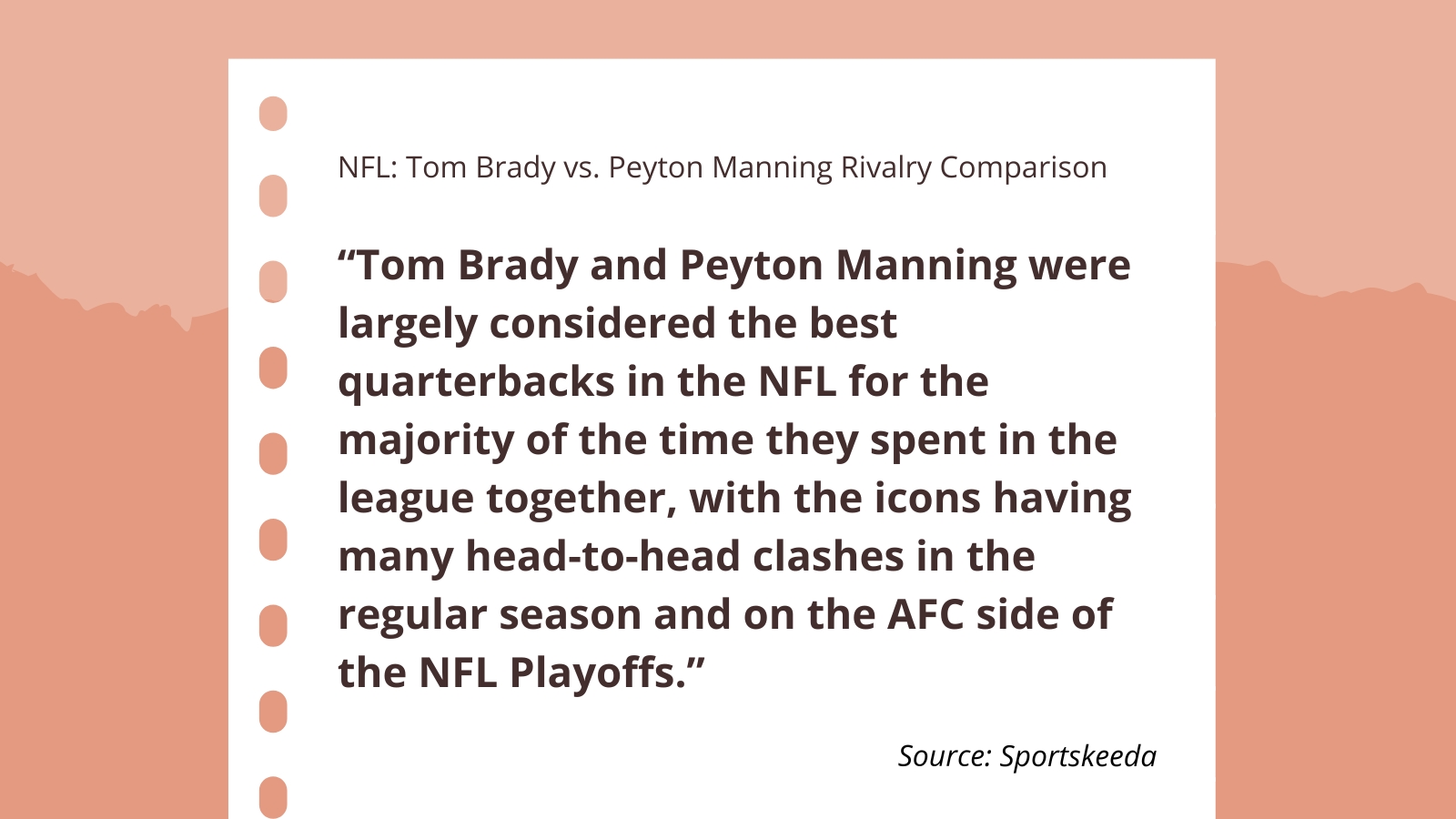
Do your writers need some inspiration? If you’re teaching students to write a compare and contrast essay, a strong example is an invaluable tool. This round-up of our favorite compare and contrast essays covers a range of topics and grade levels, so no matter your students’ interests or ages, you’ll always have a helpful example to share. You’ll find links to full essays about education, technology, pop culture, sports, animals, and more. (Need compare-and-contrast essay topic ideas? Check out our big list of compare and contrast essay topics! )
What is a compare and contrast essay?
- Education and parenting essays
- Technology essays
- Pop culture essays
- Historical and political essays
- Sports essays
- Lifestyle essays
- Healthcare essays
- Animal essays
When choosing a compare and contrast essay example to include on this list, we considered the structure. A strong compare and contrast essay begins with an introductory paragraph that includes background context and a strong thesis. Next, the body includes paragraphs that explore the similarities and differences. Finally, a concluding paragraph restates the thesis, draws any necessary inferences, and asks any remaining questions.
A compare and contrast essay example can be an opinion piece comparing two things and making a conclusion about which is better. For example, “Is Tom Brady really the GOAT?” It can also help consumers decide which product is better suited to them. Should you keep your subscription to Hulu or Netflix? Should you stick with Apple or explore Android? Here’s our list of compare and contrast essay samples categorized by subject.
Education and Parenting Compare and Contrast Essay Examples
Private school vs. public school.
Sample lines: “Deciding whether to send a child to public or private school can be a tough choice for parents. … Data on whether public or private education is better can be challenging to find and difficult to understand, and the cost of private school can be daunting. … According to the most recent data from the National Center for Education Statistics, public schools still attract far more students than private schools, with 50.7 million students attending public school as of 2018. Private school enrollment in the fall of 2017 was 5.7 million students, a number that is down from 6 million in 1999.”
Read the full essay: Private School vs. Public School at U.S. News and World Report
Homeschool vs. Public School: How Home Schooling Will Change Public Education

Sample lines: “Home schooling, not a present threat to public education, is nonetheless one of the forces that will change it. If the high estimates of the number of children in home schools (1.2 million) is correct, then the home-schooling universe is larger than the New York City public school system and roughly the size of the Los Angeles and Chicago public school systems combined. … Critics charge that three things are wrong with home schooling: harm to students academically; harm to society by producing students who are ill-prepared to function as democratic citizens and participants in a modern economy; and harm to public education, making it more difficult for other parents to educate their children. … It is time to ask whether home schooling, charters, and vouchers should be considered parts of a broad repertoire of methods that we as a society use to educate our children.”
Read the full essay: Homeschool vs. Public School: How Home Schooling Will Change Public Education at Brookings
Which parenting style is right for you?
Sample lines: “The three main types of parenting are on a type of ‘sliding scale’ of parenting, with permissive parenting as the least strict type of parenting. Permissive parenting typically has very few rules, while authoritarian parenting is thought of as a very strict, rule-driven type of parenting.”
Read the full essay: What Is Authoritative Parenting? at Healthline ADVERTISEMENT
Masked Education? The Benefits and Burdens of Wearing Face Masks in Schools During the Pandemic
Sample lines: “Face masks can prevent the spread of the virus SARS-CoV-2. … However, covering the lower half of the face reduces the ability to communicate. Positive emotions become less recognizable, and negative emotions are amplified. Emotional mimicry, contagion, and emotionality in general are reduced and (thereby) bonding between teachers and learners, group cohesion, and learning—of which emotions are a major driver. The benefits and burdens of face masks in schools should be seriously considered and made obvious and clear to teachers and students.”
Read the full essay: Masked Education? The Benefits and Burdens of Wearing Face Masks in Schools During the Pandemic at National Library of Medicine
To Ban or Not: What Should We Really Make of Book Bans?
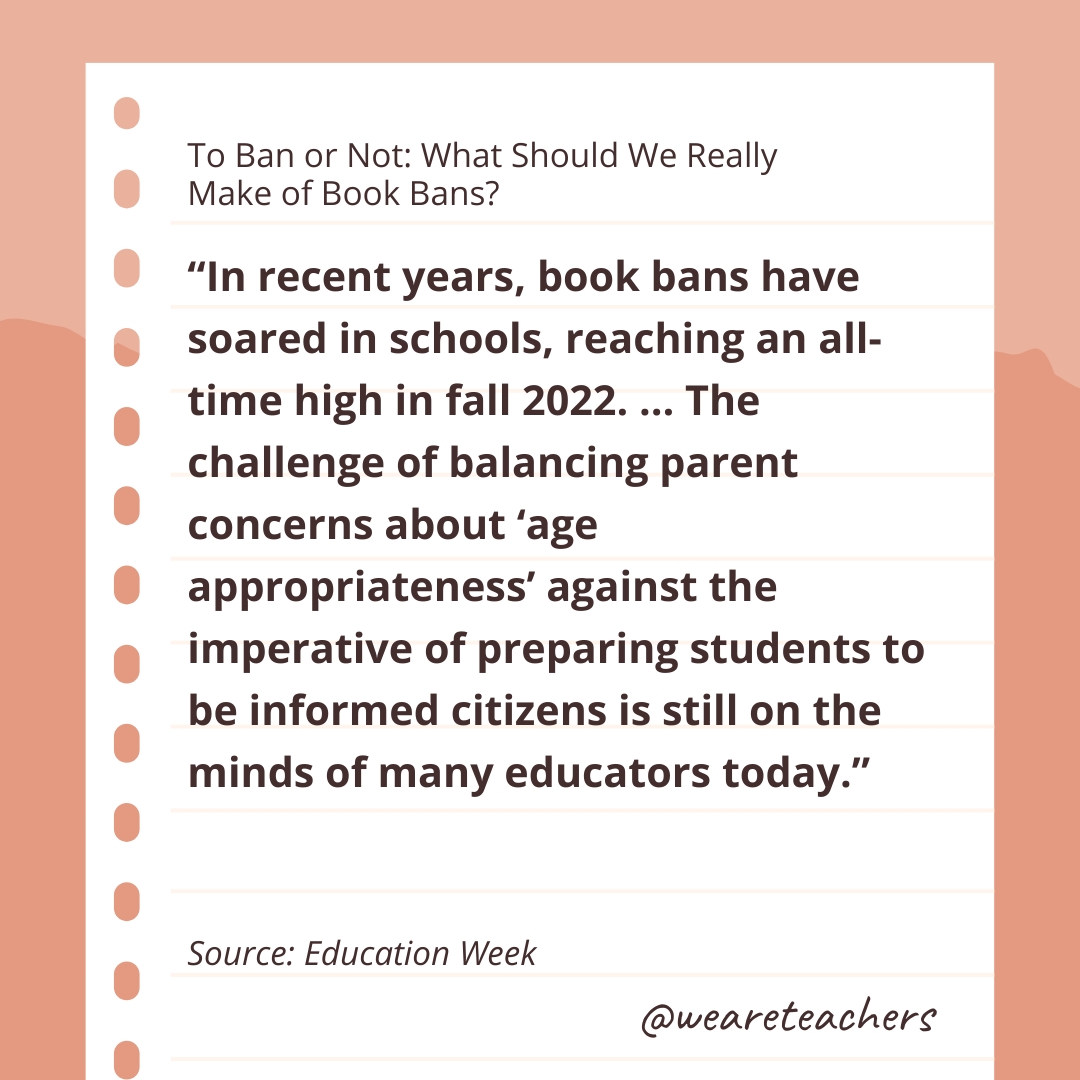
Sample lines: “In recent years, book bans have soared in schools, reaching an all-time high in fall 2022. … The challenge of balancing parent concerns about ‘age appropriateness’ against the imperative of preparing students to be informed citizens is still on the minds of many educators today. … Such curricular decision-making should be left to the professionals, argues English/language arts instructional specialist Miriam Plotinsky. ‘Examining texts for their appropriateness is not a job that noneducators are trained to do,’ she wrote last year, as the national debate over censorship resurged with the news that a Tennessee district banned the graphic novel Maus just days before Holocaust Remembrance Day.”
Read the full essay: To Ban or Not: What Should We Really Make of Book Bans? at Education Week
Technology Compare and Contrast Essay Examples
Netflix vs. hulu 2023: which is the best streaming service.
Sample lines: “Netflix fans will point to its high-quality originals, including The Witcher , Stranger Things , Emily in Paris , Ozark , and more, as well as a wide variety of documentaries like Cheer , The Last Dance , My Octopus Teacher , and many others. It also boasts a much larger subscription base, with more than 222 million subscribers compared to Hulu’s 44 million. Hulu, on the other hand, offers a variety of extras such as HBO and Showtime—content that’s unavailable on Netflix. Its price tag is also cheaper than the competition, with its $7/mo. starting price, which is a bit more palatable than Netflix’s $10/mo. starting price.”
Read the full essay: Netflix vs. Hulu 2023: Which is the best streaming service? at TV Guide
Kindle vs. Hardcover: Which is easier on the eyes?
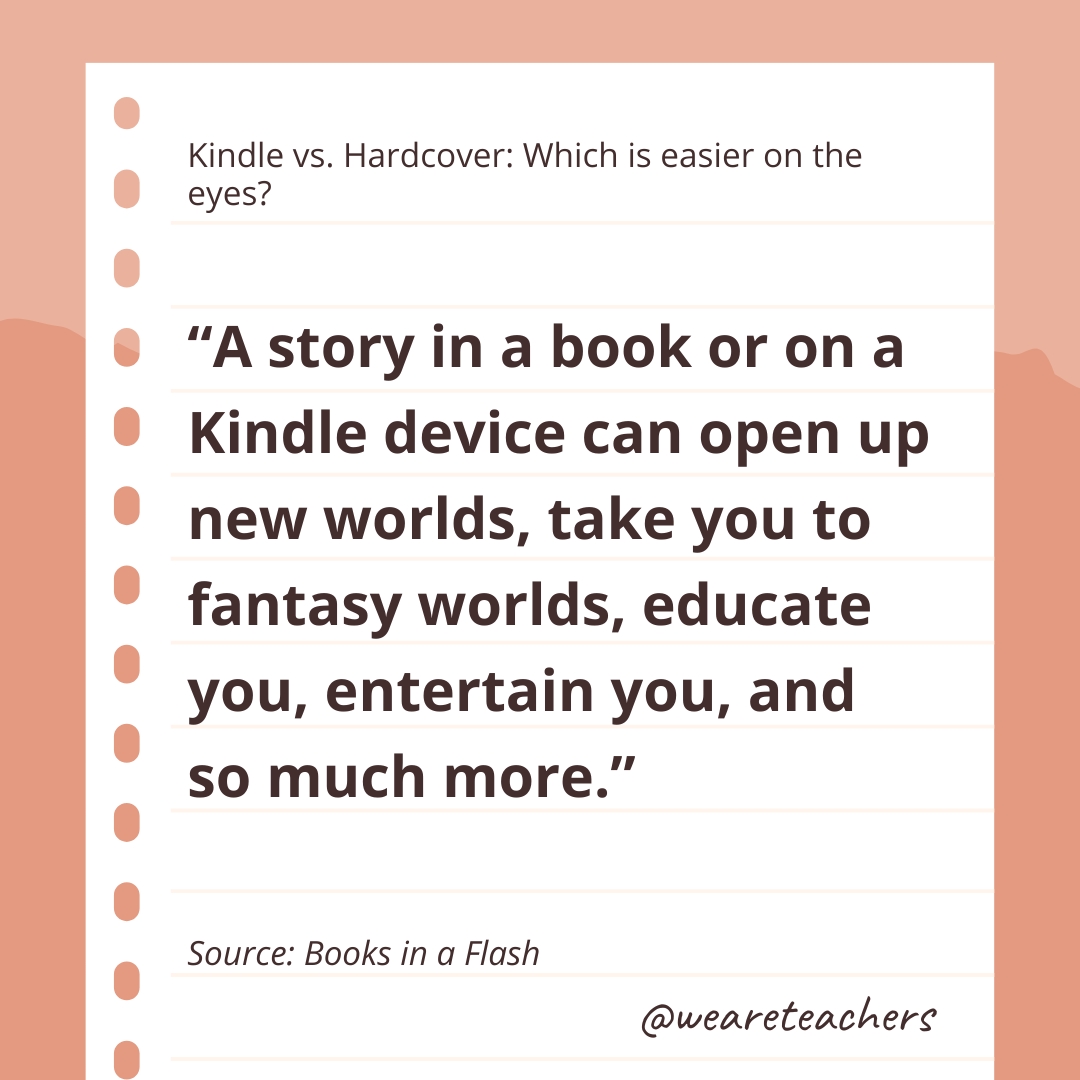
Sample lines: “In the past, we would have to drag around heavy books if we were really into reading. Now, we can have all of those books, and many more, stored in one handy little device that can easily be stuffed into a backpack, purse, etc. … Many of us still prefer to hold an actual book in our hands. … But, whether you use a Kindle or prefer hardcover books or paperbacks, the main thing is that you enjoy reading. A story in a book or on a Kindle device can open up new worlds, take you to fantasy worlds, educate you, entertain you, and so much more.”
Read the full essay: Kindle vs. Hardcover: Which is easier on the eyes? at Books in a Flash
iPhone vs. Android: Which is better for you?
Sample lines: “The iPhone vs. Android comparison is a never-ending debate on which one is best. It will likely never have a real winner, but we’re going to try and help you to find your personal pick all the same. iOS 17 and Android 14—the latest versions of the two operating systems—both offer smooth and user-friendly experiences, and several similar or identical features. But there are still important differences to be aware of. … Owning an iPhone is a simpler, more convenient experience. There’s less to think about. … Android-device ownership is a bit harder. … Yet it’s simultaneously more freeing, because it offers more choice.”
Read the full essay: iPhone vs. Android: Which is better for you? at Tom’s Guide
Cutting the cord: Is streaming or cable better for you?
Sample lines: “Cord-cutting has become a popular trend in recent years, thanks to the rise of streaming services. For those unfamiliar, cord cutting is the process of canceling your cable subscription and instead, relying on streaming platforms such as Netflix and Hulu to watch your favorite shows and movies. The primary difference is that you can select your streaming services à la carte while cable locks you in on a set number of channels through bundles. So, the big question is: should you cut the cord?”
Read the full essay: Cutting the cord: Is streaming or cable better for you? at BroadbandNow
PS5 vs. Nintendo Switch
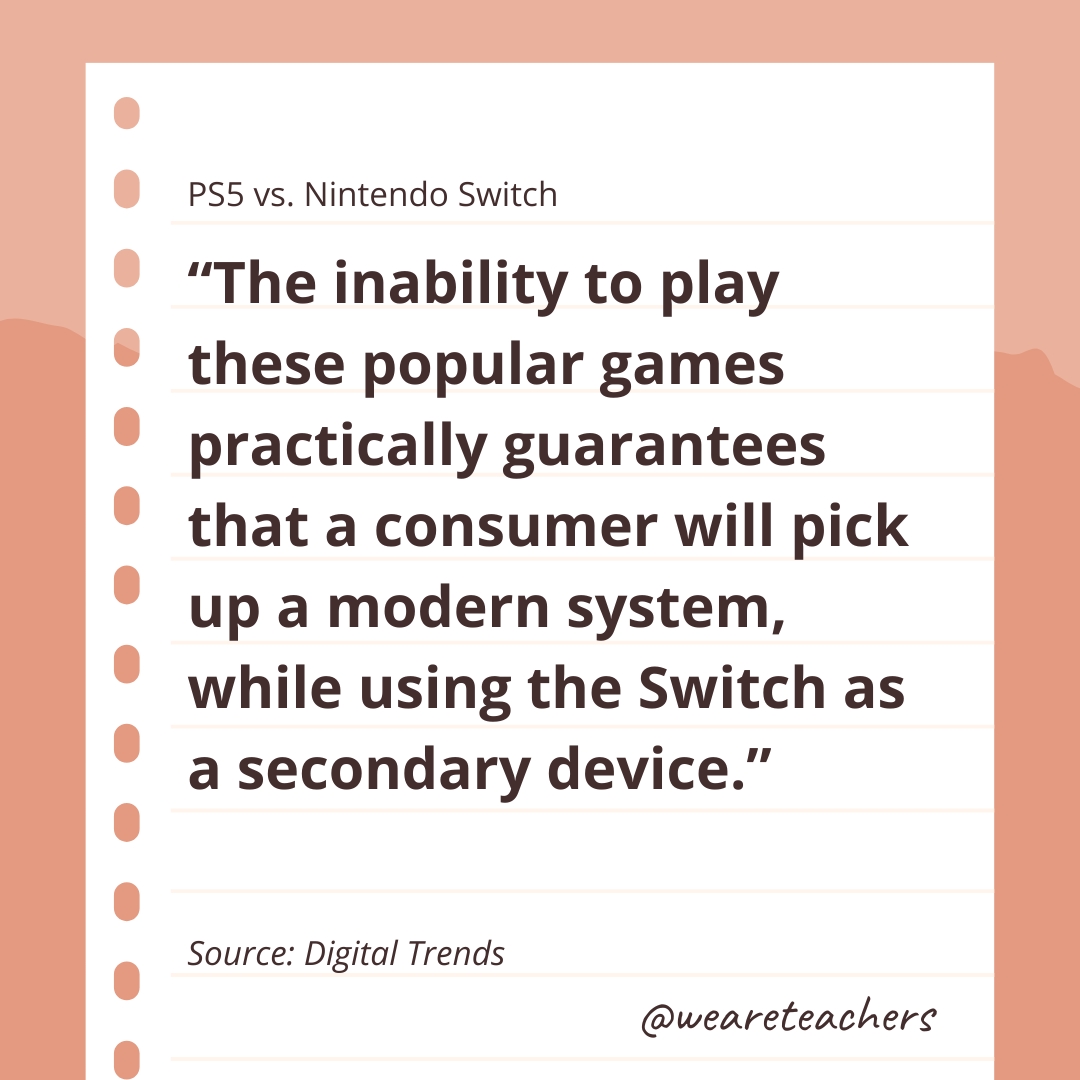
Sample lines: “The crux of the comparison comes down to portability versus power. Being able to migrate fully fledged Nintendo games from a big screen to a portable device is a huge asset—and one that consumers have taken to, especially given the Nintendo Switch’s meteoric sales figures. … It is worth noting that many of the biggest franchises like Call of Duty, Madden, modern Resident Evil titles, newer Final Fantasy games, Grand Theft Auto, and open-world Ubisoft adventures like Assassin’s Creed will usually skip Nintendo Switch due to its lack of power. The inability to play these popular games practically guarantees that a consumer will pick up a modern system, while using the Switch as a secondary device.”
Read the full essay: PS5 vs. Nintendo Switch at Digital Trends
What is the difference between Facebook and Instagram?
Sample lines: “Have you ever wondered what is the difference between Facebook and Instagram? Instagram and Facebook are by far the most popular social media channels used by digital marketers. Not to mention that they’re also the biggest platforms used by internet users worldwide. So, today we’ll look into the differences and similarities between these two platforms to help you figure out which one is the best fit for your business.”
Read the full essay: What is the difference between Facebook and Instagram? at SocialBee
Digital vs. Analog Watches—What’s the Difference?
Sample lines: “In short, digital watches use an LCD or LED screen to display the time. Whereas, an analog watch features three hands to denote the hour, minutes, and seconds. With the advancement in watch technology and research, both analog and digital watches have received significant improvements over the years. Especially in terms of design, endurance, and accompanying features. … At the end of the day, whether you go analog or digital, it’s a personal preference to make based on your style, needs, functions, and budget.”
Read the full essay: Digital vs. Analog Watches—What’s the Difference? at Watch Ranker
AI Art vs. Human Art: A Side-by-Side Analysis
Sample lines: “Art has always been a reflection of human creativity, emotion, and cultural expression. However, with the rise of artificial intelligence (AI), a new form of artistic creation has emerged, blurring the lines between what is created by human hands and what is generated by algorithms. … Despite the excitement surrounding AI Art, it also raises complex ethical, legal, and artistic questions that have sparked debates about the definition of art, the role of the artist, and the future of art production. … Regardless of whether AI Art is considered ‘true’ art, it is crucial to embrace and explore the vast possibilities and potential it brings to the table. The transformative influence of AI art on the art world is still unfolding, and only time will reveal its true extent.”
Read the full essay: AI Art vs. Human Art: A Side-by-Side Analysis at Raul Lara
Pop Culture Compare and Contrast Essay Examples
Christina aguilera vs. britney spears.
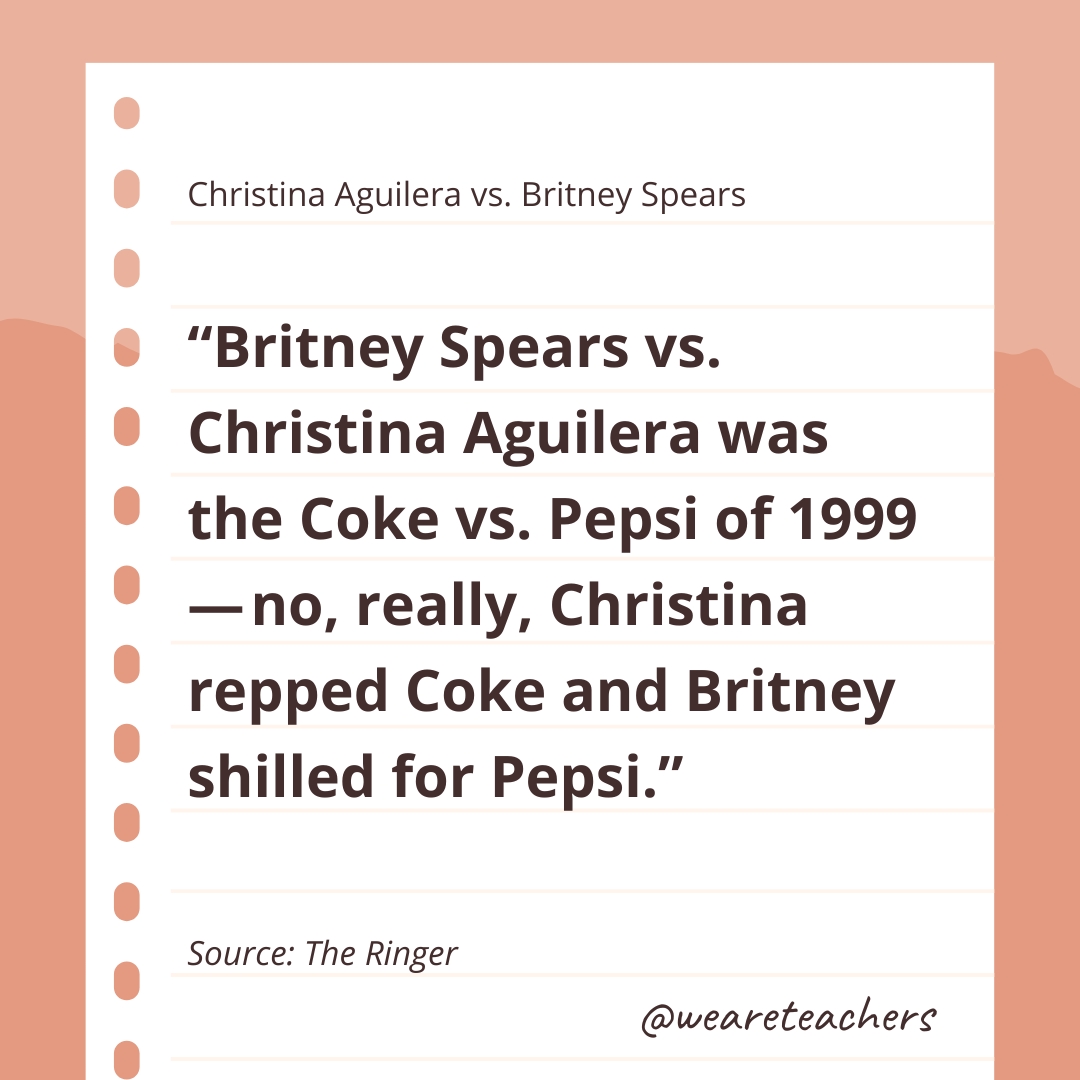
Sample lines: “Britney Spears vs. Christina Aguilera was the Coke vs. Pepsi of 1999 — no, really, Christina repped Coke and Britney shilled for Pepsi. The two teen idols released debut albums seven months apart before the turn of the century, with Britney’s becoming a standard-bearer for bubblegum pop and Aguilera’s taking an R&B bent to show off her range. … It’s clear that Spears and Aguilera took extremely divergent paths following their simultaneous breakout successes.”
Read the full essay: Christina Aguilera vs. Britney Spears at The Ringer
Harry Styles vs. Ed Sheeran
Sample lines: “The world heard our fantasies and delivered us two titans simultaneously—we have been blessed with Ed Sheeran and Harry Styles. Our cup runneth over; our bounty is immeasurable. More remarkable still is the fact that both have released albums almost at the same time: Ed’s third, Divide , was released in March and broke the record for one-day Spotify streams, while Harry’s frenziedly anticipated debut solo, called Harry Styles , was released yesterday.”
Read the full essay: Harry Styles versus Ed Sheeran at Belfast Telegraph
The Grinch: Three Versions Compared
Sample lines: “Based on the original story of the same name, this movie takes a completely different direction by choosing to break away from the cartoony form that Seuss had established by filming the movie in a live-action form. Whoville is preparing for Christmas while the Grinch looks down upon their celebrations in disgust. Like the previous film, The Grinch hatches a plan to ruin Christmas for the Who’s. … Like in the original Grinch, he disguises himself as Santa Claus, and makes his dog, Max, into a reindeer. He then takes all of the presents from the children and households. … Cole’s favorite is the 2000 edition, while Alex has only seen the original. Tell us which one is your favorite.”
Read the full essay: The Grinch: Three Versions Compared at Wooster School
Historical and Political Compare and Contrast Essay Examples
Malcolm x vs. martin luther king jr.: comparison between two great leaders’ ideologies .
Sample lines: “Although they were fighting for civil rights at the same time, their ideology and way of fighting were completely distinctive. This can be for a plethora of reasons: background, upbringing, the system of thought, and vision. But keep in mind, they devoted their whole life to the same prospect. … Through boycotts and marches, [King] hoped to end racial segregation. He felt that the abolition of segregation would improve the likelihood of integration. Malcolm X, on the other hand, spearheaded a movement for black empowerment.”
Read the full essay: Malcolm X vs. Martin Luther King Jr.: Comparison Between Two Great Leaders’ Ideologies at Melaninful
Contrast Between Obama and Trump Has Become Clear
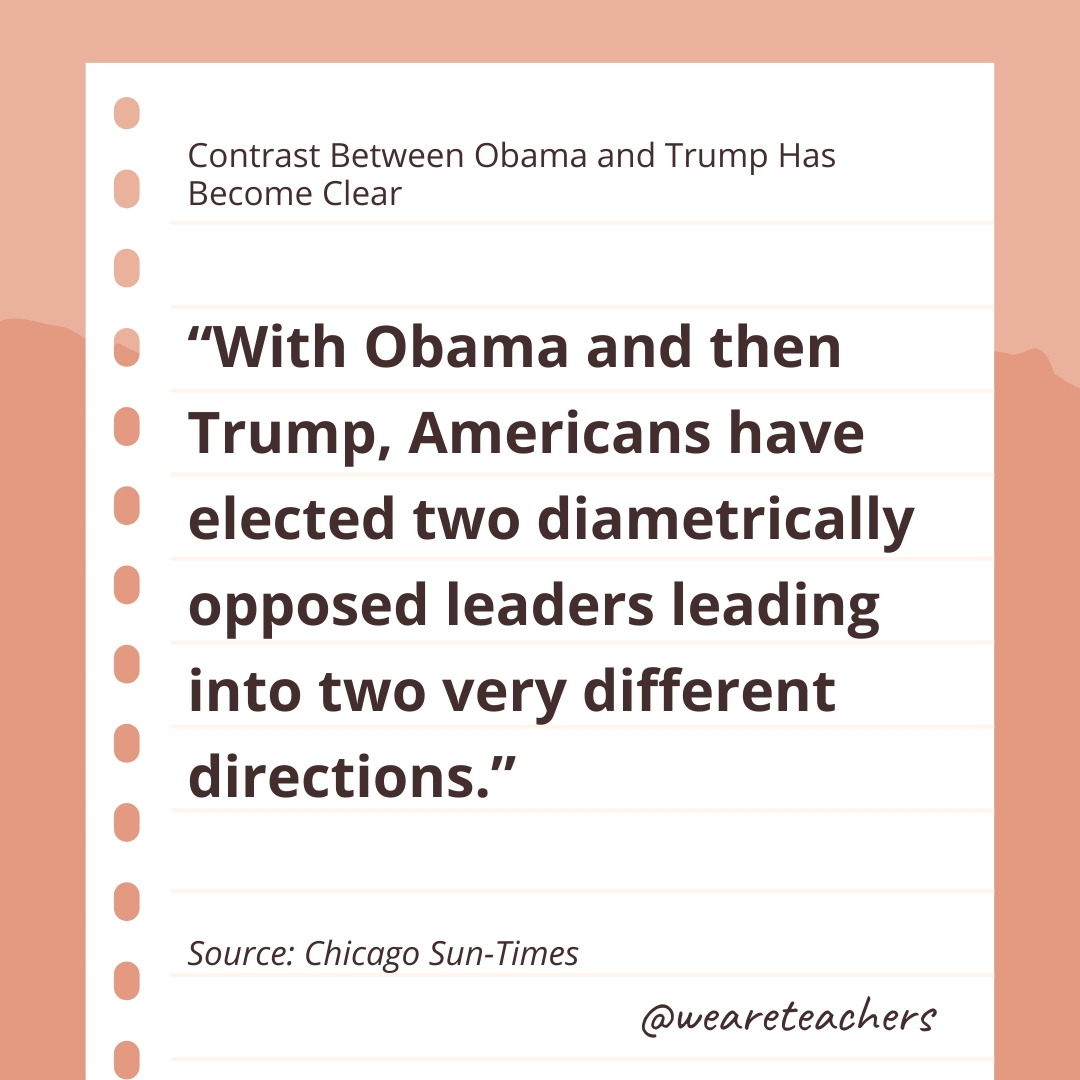
Sample lines: “The contrast is even clearer when we look to the future. Trump promises more tax cuts, more military spending, more deficits and deeper cuts in programs for the vulnerable. He plans to nominate a coal lobbyist to head the Environmental Protection Agency. … Obama says America must move forward, and he praises progressive Democrats for advocating Medicare for all. … With Obama and then Trump, Americans have elected two diametrically opposed leaders leading into two very different directions.”
Read the full essay: Contrast Between Obama and Trump Has Become Clear at Chicago Sun-Times
Sports Compare and Contrast Essay Examples
Lebron james vs. kobe bryant: a complete comparison.
Sample lines: “LeBron James has achieved so much in his career that he is seen by many as the greatest of all time, or at least the only player worthy of being mentioned in the GOAT conversation next to Michael Jordan. Bridging the gap between Jordan and LeBron though was Kobe Bryant, who often gets left out of comparisons and GOAT conversations. … Should his name be mentioned more though? Can he compare to LeBron or is The King too far past The Black Mamba in historical rankings already?”
Read the full essay: LeBron James vs. Kobe Bryant: A Complete Comparison at Sportskeeda
NFL: Tom Brady vs. Peyton Manning Rivalry Comparison
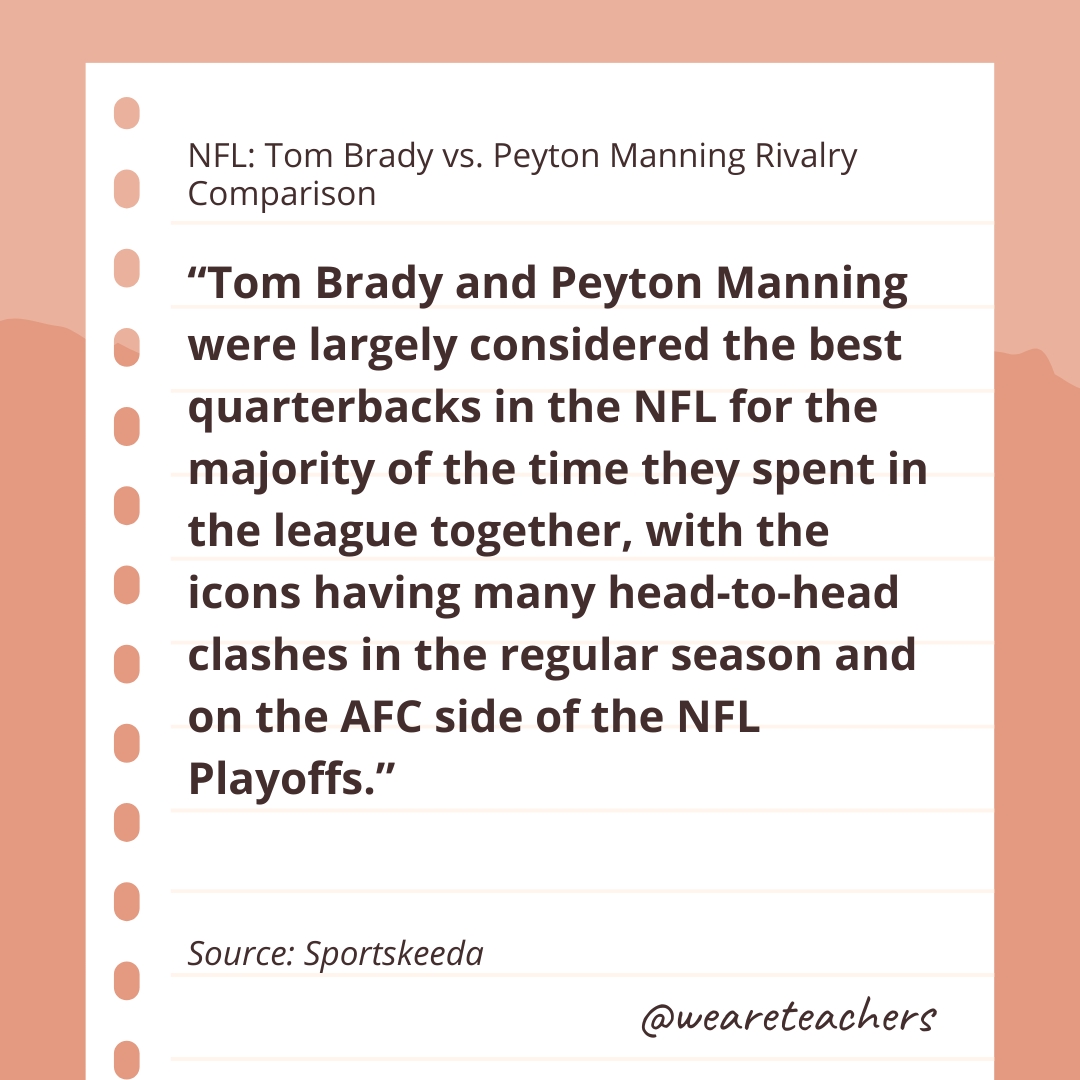
Sample lines: “Tom Brady and Peyton Manning were largely considered the best quarterbacks in the NFL for the majority of the time they spent in the league together, with the icons having many head-to-head clashes in the regular season and on the AFC side of the NFL Playoffs. Manning was the leader of the Indianapolis Colts of the AFC South. … Brady spent his career as the QB of the AFC East’s New England Patriots, before taking his talents to Tampa Bay. … The reality is that winning is the most important aspect of any career, and Brady won more head-to-head matchups than Manning did.”
Read the full essay: NFL: Tom Brady vs. Peyton Manning Rivalry Comparison at Sportskeeda
The Greatest NBA Franchise Ever: Boston Celtics or Los Angeles Lakers?
Sample lines: “The Celtics are universally considered as the greatest franchise in NBA history. But if you take a close look at the numbers, there isn’t really too much separation between them and their arch-rival Los Angeles Lakers. In fact, you can even make a good argument for the Lakers. … In 72 seasons played, the Boston Celtics have won a total of 3,314 games and lost 2,305 or a .590 winning mark. On the other hand, the Los Angeles Lakers have won 3,284 of 5,507 total games played or a slightly better winning record of .596. … But while the Lakers have the better winning percentage, the Celtics have the advantage over them in head-to-head competition.”
Read the full essay: The Greatest NBA Franchise Ever: Boston Celtics or Los Angeles Lakers? at Sport One
Is Soccer Better Than Football?
Sample lines: “Is soccer better than football? Soccer and football lovers have numerous reasons to support their sport of choice. Both keep the players physically fit and help to bring people together for an exciting cause. However, soccer has drawn more numbers globally due to its popularity in more countries.”
Read the full essay: Is Soccer Better Than Football? at Sports Brief
Lifestyle Choices Compare and Contrast Essay Examples
Mobile home vs. tiny house: similarities, differences, pros & cons.
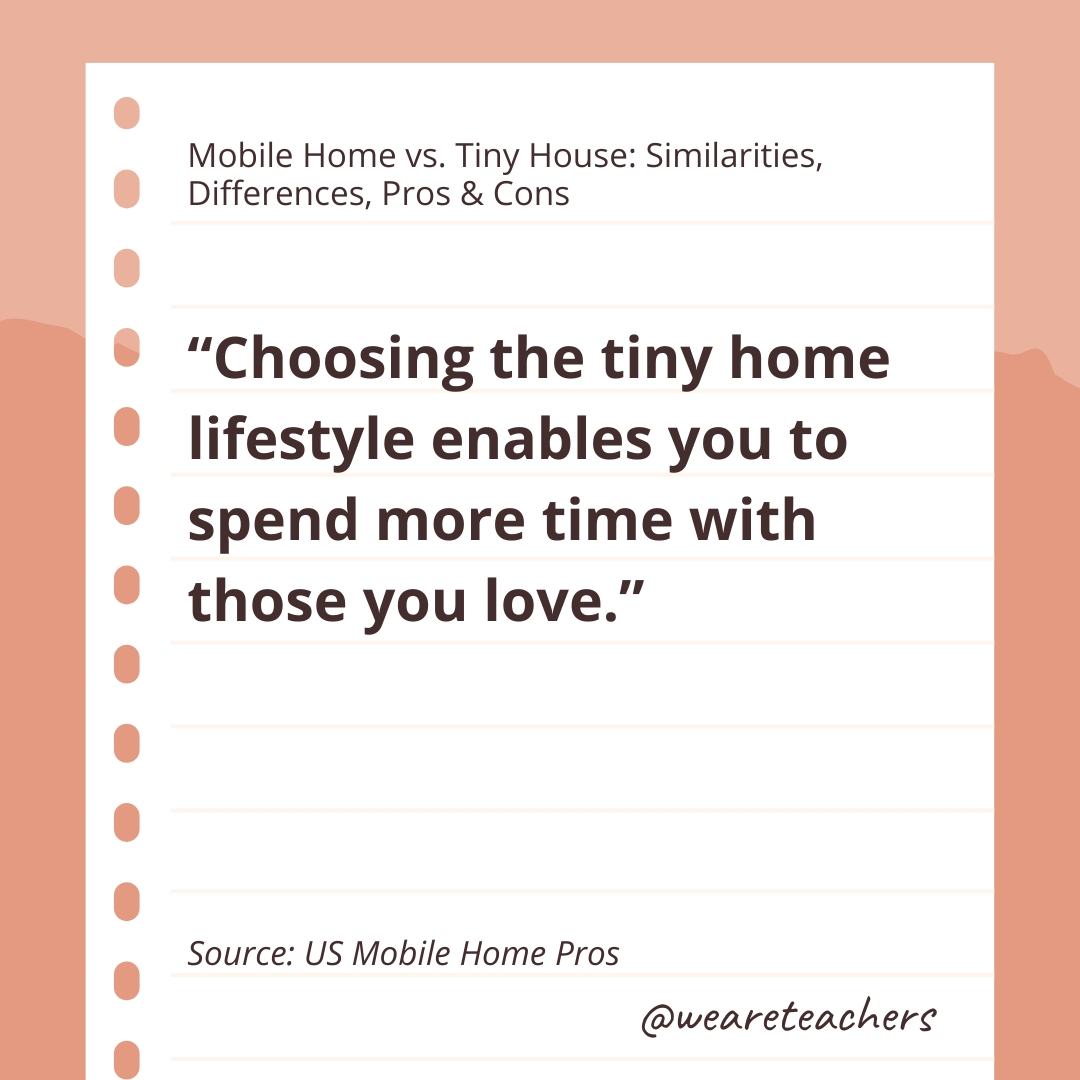
Sample lines: “Choosing the tiny home lifestyle enables you to spend more time with those you love. The small living space ensures quality bonding time rather than hiding away in a room or behind a computer screen. … You’ll be able to connect closer to nature and find yourself able to travel the country at any given moment. On the other hand, we have the mobile home. … They are built on a chassis with transportation in mind. … They are not built to be moved on a constant basis. … While moving the home again *is* possible, it may cost you several thousand dollars.”
Read the full essay: Mobile Home vs. Tiny House: Similarities, Differences, Pros & Cons at US Mobile Home Pros
Whole Foods vs. Walmart: The Story of Two Grocery Stores
Sample lines: “It is clear that both stores have very different stories and aims when it comes to their customers. Whole Foods looks to provide organic, healthy, exotic, and niche products for an audience with a very particular taste. … Walmart, on the other hand, looks to provide the best deals, every possible product, and every big brand for a broader audience. … Moreover, they look to make buying affordable and accessible, and focus on the capitalist nature of buying.”
Read the full essay: Whole Foods vs. Walmart: The Story of Two Grocery Stores at The Archaeology of Us
Artificial Grass vs. Turf: The Real Differences Revealed
Sample lines: “The key difference between artificial grass and turf is their intended use. Artificial turf is largely intended to be used for sports, so it is shorter and tougher. On the other hand, artificial grass is generally longer, softer and more suited to landscaping purposes. Most homeowners would opt for artificial grass as a replacement for a lawn, for example. Some people actually prefer playing sports on artificial grass, too … artificial grass is often softer and more bouncy, giving it a feel similar to playing on a grassy lawn. … At the end of the day, which one you will choose will depend on your specific household and needs.”
Read the full essay: Artificial Grass vs. Turf: The Real Differences Revealed at Almost Grass
Minimalism vs. Maximalism: Differences, Similarities, and Use Cases
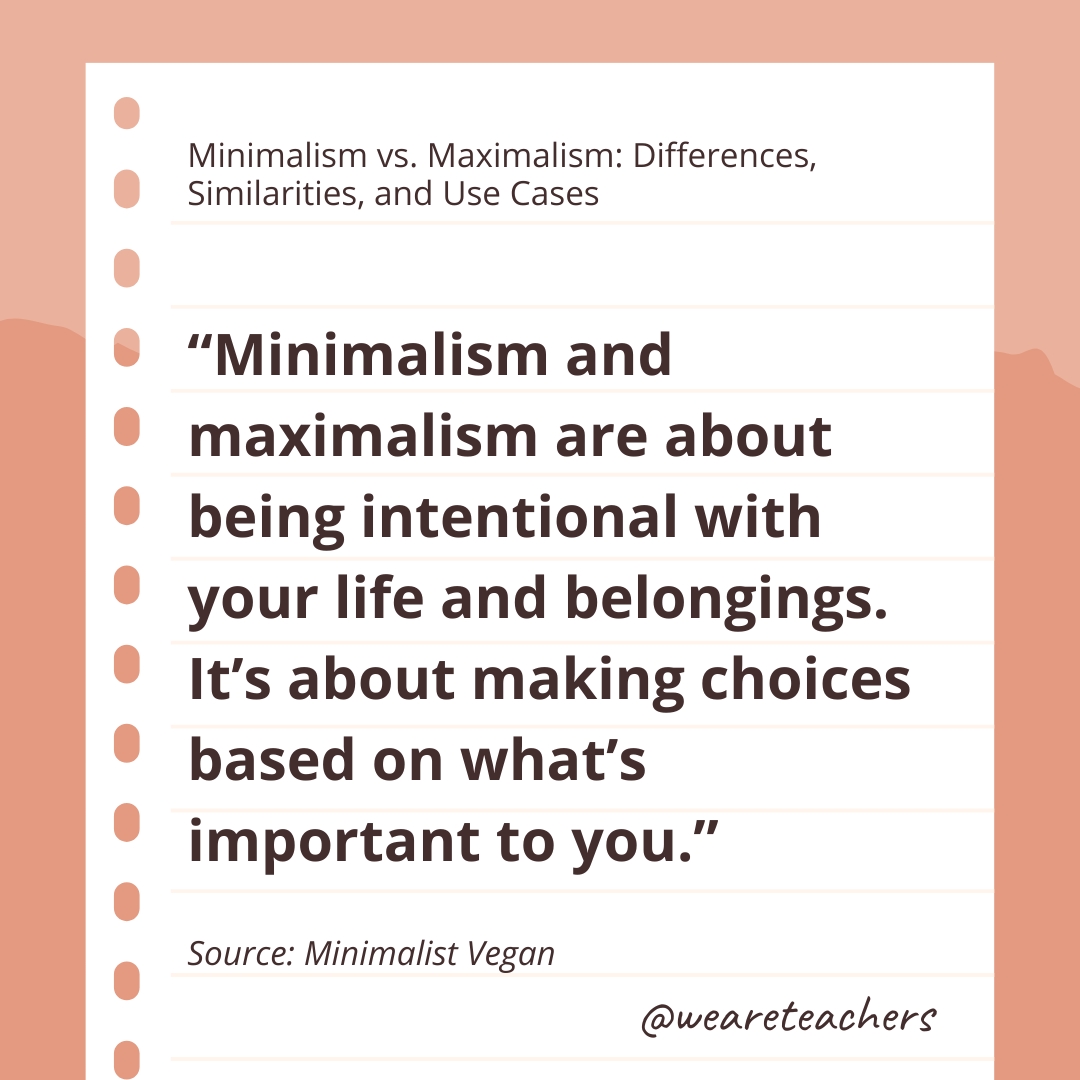
Sample lines: “Maximalists love shopping, especially finding unique pieces. They see it as a hobby—even a skill—and a way to express their personality. Minimalists don’t like shopping and see it as a waste of time and money. They’d instead use those resources to create memorable experiences. Maximalists desire one-of-a-kind possessions. Minimalists are happy with duplicates—for example, personal uniforms. … Minimalism and maximalism are about being intentional with your life and belongings. It’s about making choices based on what’s important to you.”
Read the full essay: Minimalism vs. Maximalism: Differences, Similarities, and Use Cases at Minimalist Vegan
Vegetarian vs. Meat Eating: Is It Better To Be a Vegetarian?
Sample lines: “You’ve heard buzz over the years that following a vegetarian diet is better for your health, and you’ve probably read a few magazine articles featuring a celeb or two who swore off meat and animal products and ‘magically’ lost weight. So does ditching meat automatically equal weight loss? Will it really help you live longer and be healthier overall? … Vegetarians appear to have lower low-density lipoprotein cholesterol levels, lower blood pressure and lower rates of hypertension and type 2 diabetes than meat eaters. Vegetarians also tend to have a lower body mass index, lower overall cancer rates and lower risk of chronic disease. But if your vegetarian co-worker is noshing greasy veggie burgers and fries every day for lunch, is he likely to be healthier than you, who always orders the grilled salmon? Definitely not!”
Read the full essay: Vegetarian vs. Meat Eating: Is It Better To Be a Vegetarian? at WebMD
Healthcare Compare and Contrast Essay Examples
Similarities and differences between the health systems in australia & usa.
Sample lines: “Australia and the United States are two very different countries. They are far away from each other, have contrasting fauna and flora, differ immensely by population, and have vastly different healthcare systems. The United States has a population of 331 million people, compared to Australia’s population of 25.5 million people.”
Read the full essay: Similarities and Differences Between the Health Systems in Australia & USA at Georgia State University
Universal Healthcare in the United States of America: A Healthy Debate
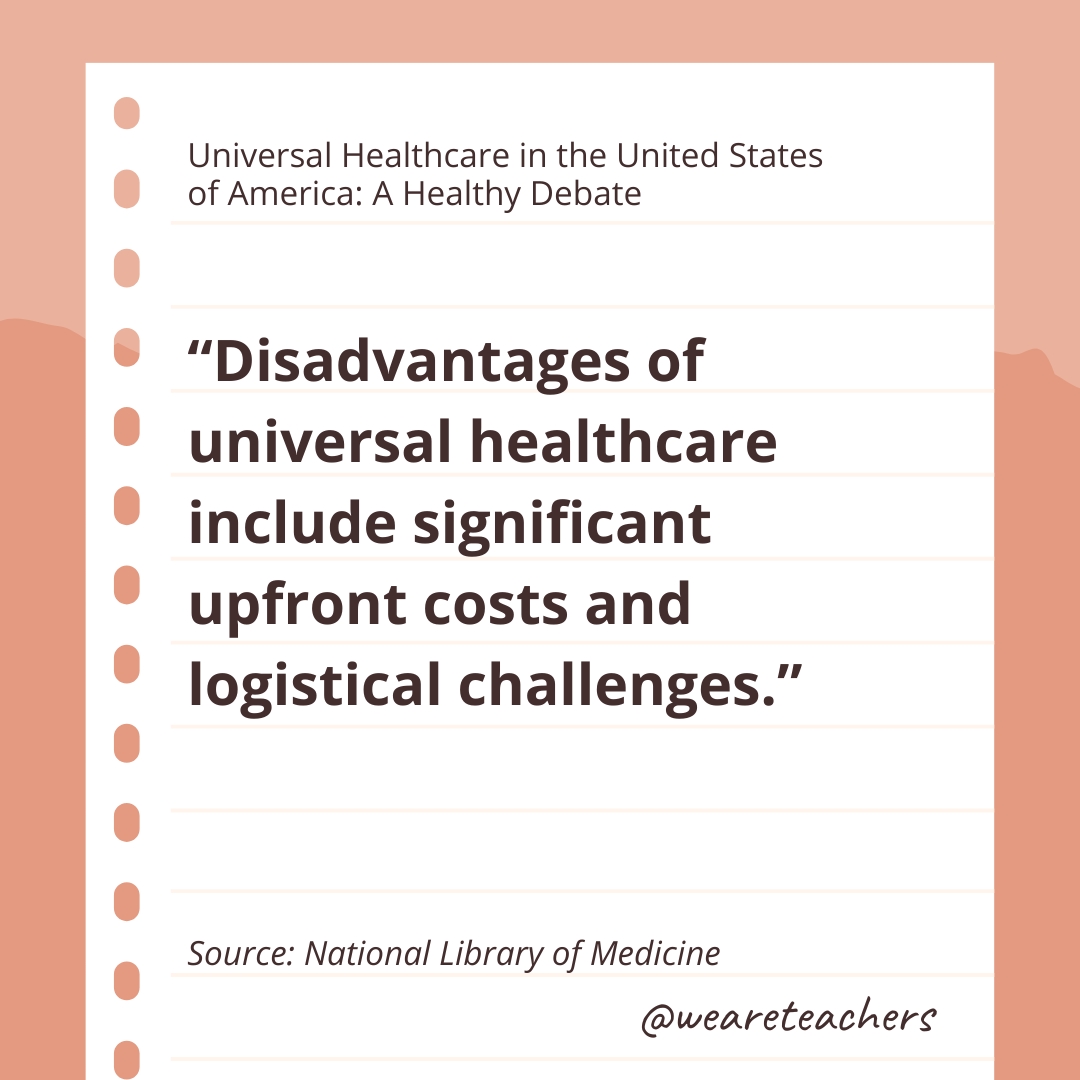
Sample lines: “Disadvantages of universal healthcare include significant upfront costs and logistical challenges. On the other hand, universal healthcare may lead to a healthier populace, and thus, in the long-term, help to mitigate the economic costs of an unhealthy nation. In particular, substantial health disparities exist in the United States, with low socio-economic status segments of the population subject to decreased access to quality healthcare and increased risk of non-communicable chronic conditions such as obesity and type II diabetes, among other determinants of poor health.”
Read the full essay: Universal Healthcare in the United States of America: A Healthy Debate at National Library of Medicine
Pros and Cons of Physician Aid in Dying
Sample lines: “Physician aid in dying is a controversial subject raising issues central to the role of physicians. … The two most common arguments in favor of legalizing AID are respect for patient autonomy and relief of suffering. A third, related, argument is that AID is a safe medical practice, requiring a health care professional. … Although opponents of AID offer many arguments ranging from pragmatic to philosophical, we focus here on concerns that the expansion of AID might cause additional, unintended harm through suicide contagion, slippery slope, and the deaths of patients suffering from depression.”
Read the full essay: Pros and Cons of Physician Aid in Dying at National Library of Medicine
Animals Compare and Contrast Essay Examples
Compare and contrast paragraph—dogs and cats.
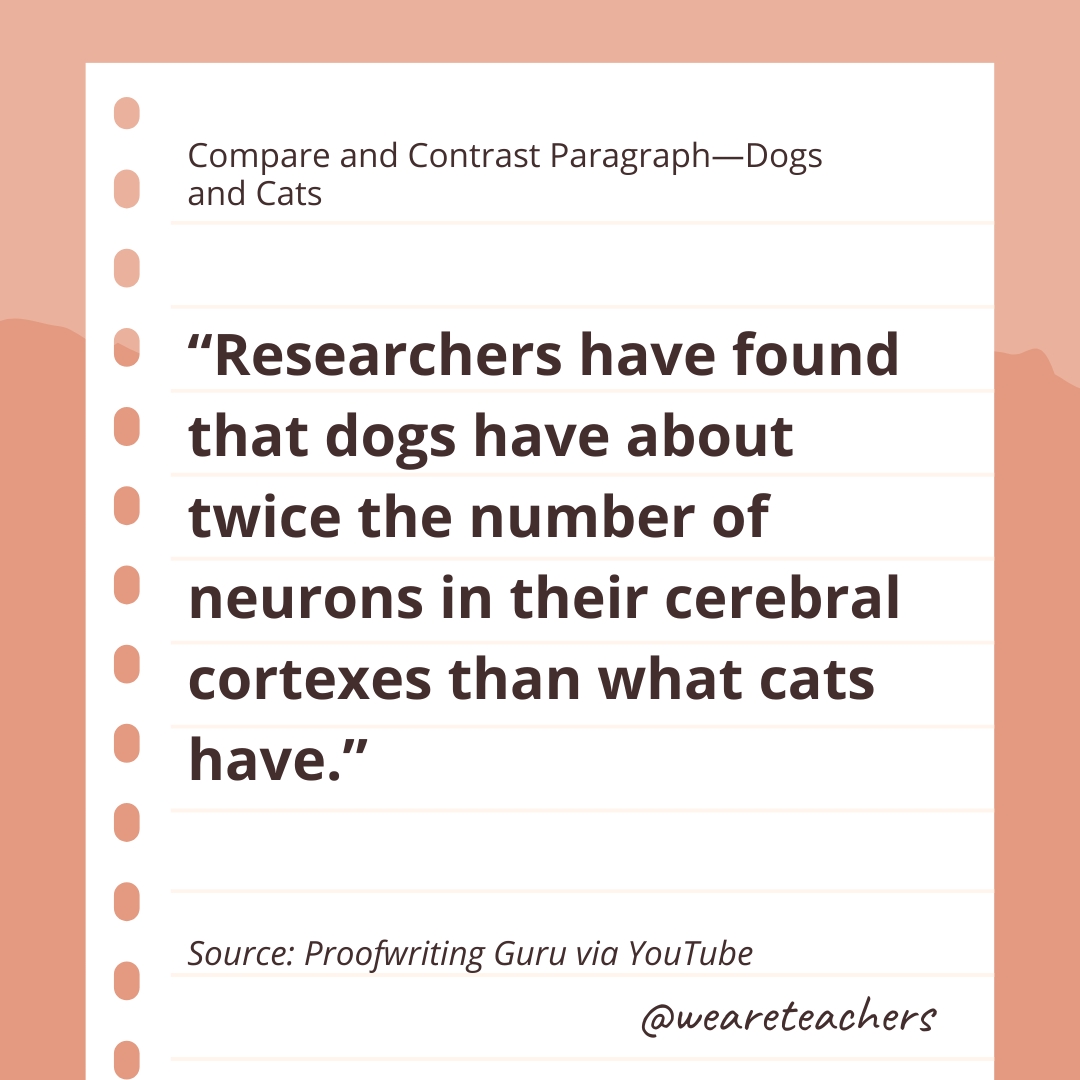
Sample lines: “Researchers have found that dogs have about twice the number of neurons in their cerebral cortexes than what cats have. Specifically, dogs had around 530 million neurons, whereas the domestic cat only had 250 million neurons. Moreover, dogs can be trained to learn and respond to our commands, but although your cat understands your name, and anticipates your every move, he/she may choose to ignore you.”
Read the full essay: Compare and Contrast Paragraph—Dogs and Cats at Proofwriting Guru via YouTube
Giddyup! The Differences Between Horses and Dogs
Sample lines: “Horses are prey animals with a deep herding instinct. They are highly sensitive to their environment, hyper aware, and ready to take flight if needed. Just like dogs, some horses are more confident than others, but just like dogs, all need a confident handler to teach them what to do. Some horses are highly reactive and can be spooked by the smallest things, as are dogs. … Another distinction between horses and dogs … was that while dogs have been domesticated , horses have been tamed. … Both species have influenced our culture more than any other species on the planet.”
Read the full essay: Giddyup! The Differences Between Horses and Dogs at Positively Victoria Stilwell
Exotic, Domesticated, and Wild Pets
Sample lines: “Although the words ‘exotic’ and ‘wild’ are frequently used interchangeably, many people do not fully understand how these categories differ when it comes to pets. ‘A wild animal is an indigenous, non-domesticated animal, meaning that it is native to the country where you are located,’ Blue-McLendon explained. ‘For Texans, white-tailed deer, pronghorn sheep, raccoons, skunks, and bighorn sheep are wild animals … an exotic animal is one that is wild but is from a different continent than where you live.’ For example, a hedgehog in Texas would be considered an exotic animal, but in the hedgehog’s native country, it would be considered wildlife.”
Read the full essay: Exotic, Domesticated, and Wild Pets at Texas A&M University
Should Zoos Be Banned? Pros & Cons of Zoos
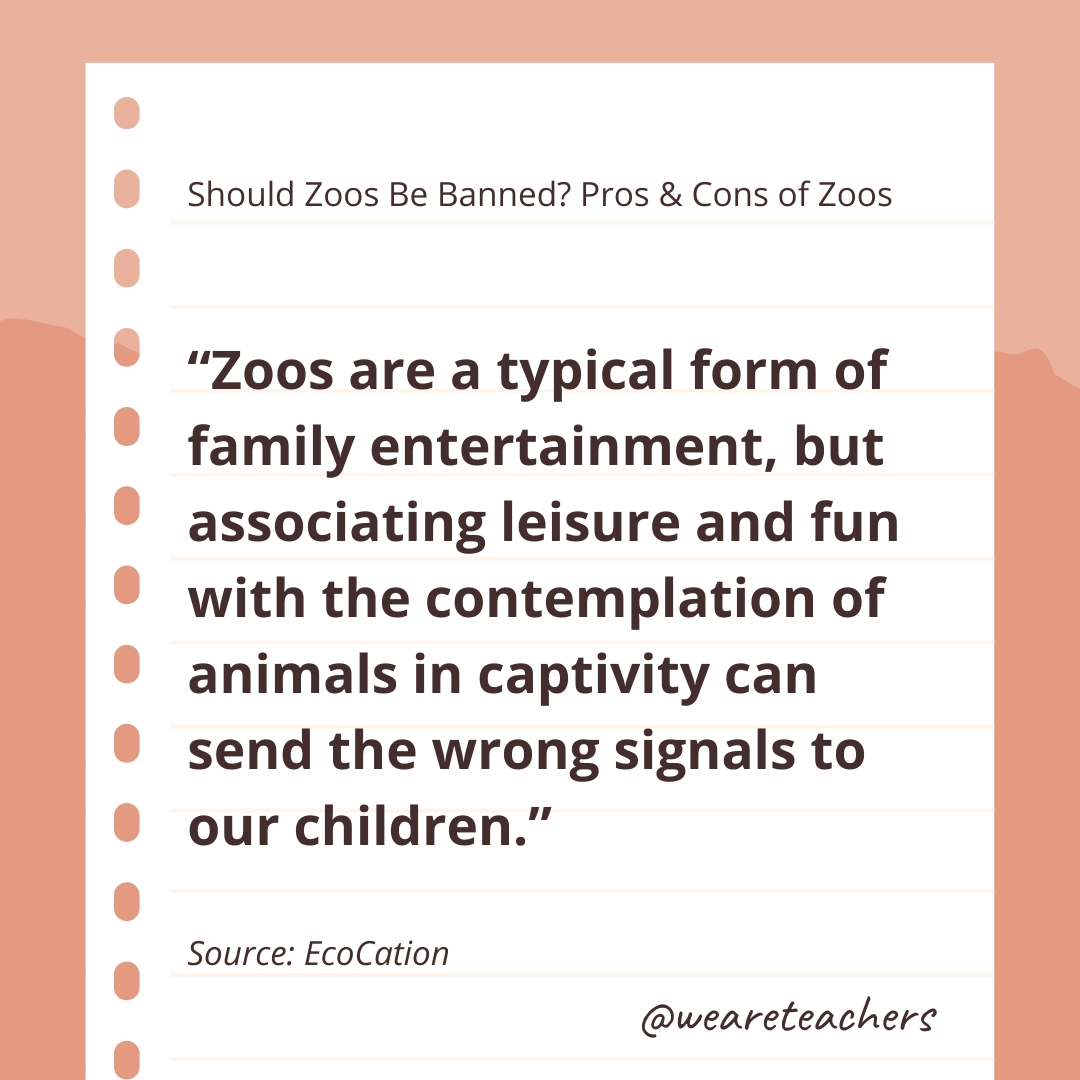
Sample lines: “The pros and cons of zoos often come from two very different points of view. From a legal standard, animals are often treated as property. That means they have less rights than humans, so a zoo seems like a positive place to maintain a high quality of life. For others, the forced enclosure of any animal feels like an unethical decision. … Zoos provide a protected environment for endangered animals, and also help in raising awareness and funding for wildlife initiatives and research projects. … Zoos are key for research. Being able to observe and study animals is crucial if we want to contribute to help them and repair the ecosystems. … Zoos are a typical form of family entertainment, but associating leisure and fun with the contemplation of animals in captivity can send the wrong signals to our children.”
Read the full essay: Should Zoos Be Banned? Pros & Cons of Zoos at EcoCation
Do you have a favorite compare and contrast essay example? Come share in the We Are Teachers HELPLINE group on Facebook .
Plus, if you liked these compare and contrast essay examples check out intriguing compare and contrast essay topics for kids and teens ..
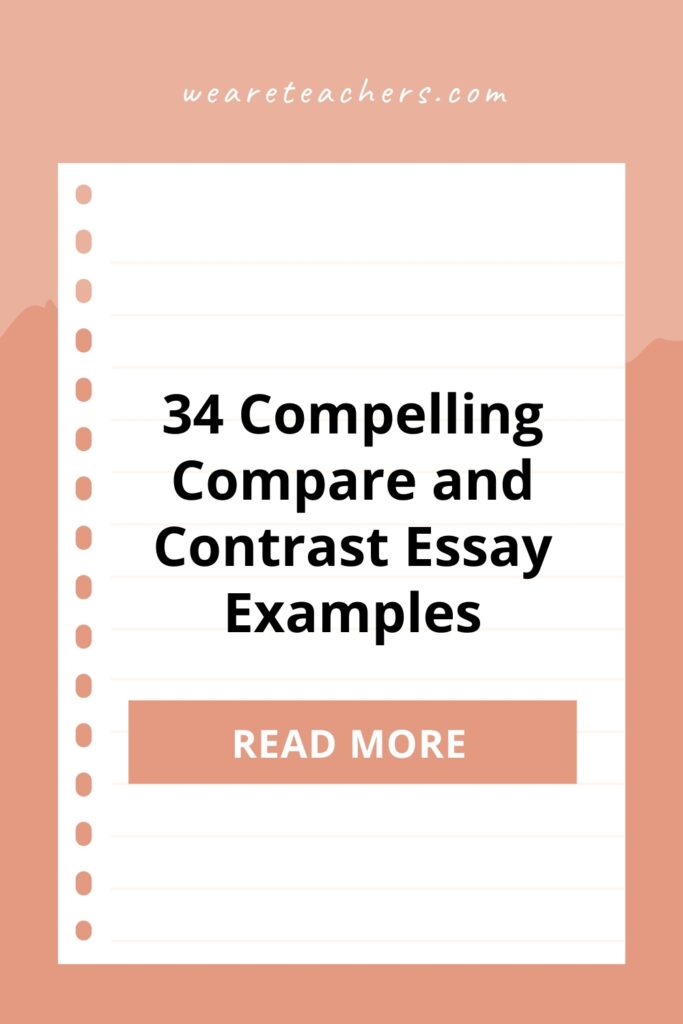
You Might Also Like
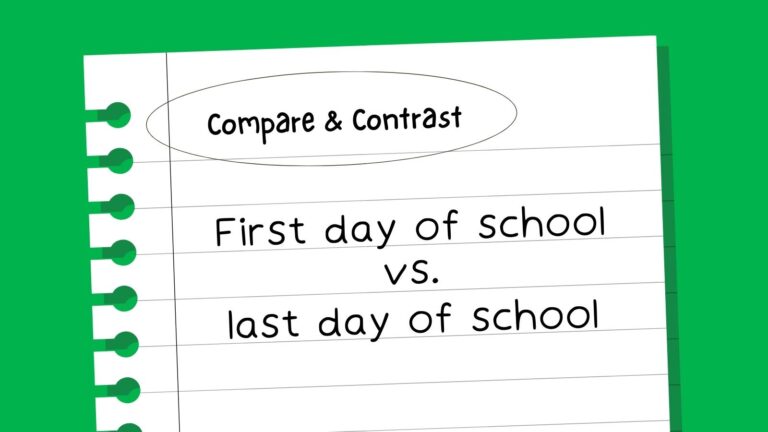
125 Intriguing Compare and Contrast Essay Topics for Kids and Teens
Android vs. iPhone? Capitalism vs. communism? Hot dog vs. taco? Continue Reading
Copyright © 2024. All rights reserved. 5335 Gate Parkway, Jacksonville, FL 32256
How to Write a Comparison Essay: From Similarities to Differences
Table of contents
- 1.1 What Сan I Compare and Contrast?
- 1.2 Choosing a Great Topic for a Comparison Essay
- 1.3 Education Compare and Contrast Essays Topics
- 1.4 Sports Compare and Contrast Essays Topics
- 1.5 Politics Compare and Contrast Essays Topics
- 1.6 Economy Compare and Contrast Essays Topics
- 1.7 Social Studies Compare and Contrast Essays Topics
- 1.8 History Compare and Contrast Essays Topics
- 1.9 Literature Compare and Contrast Essays Topics
- 1.10 Controversial Compare and Contrast Essay Topics
- 2.1 Thesis Statement
- 3.0.1 Understand Your Subjects:
- 3.0.2 Purpose of the Essay:
- 3.0.3 Audience Consideration:
- 3.0.4 Two Predominant Structures:
- 4.1 Comparison Essay Outline Example
- 5.1 Comparison Essay Format
- 6 Bringing It All Together
As we navigate our lives, we can’t help but notice the elements in our environment, whether it’s the latest car, a fashion trend, or even some experiences. Think about your favorite Mexican restaurant, then visit another; automatically, you’re likely to size them up to each other. So when your professors assign you homework to compare two samples in a case study, it may seem natural.
But at the college level, something happens, our natural ability to compare vacates us. You may be stuck wondering how to write a comparison essay. This is a common dilemma many students face. We’ve put together this comprehensive guide to walk you through the perfect paper’s construction steps. Below, you’ll find:
- A comprehensive guide on how to write a comparison essay, outlining its purpose, how to choose relevant topics for comparison, and the structure for presenting the content effectively.
- That the comparison essay requires the writer to analyze two objects, events, or theories and identify their similarities and differences, supporting findings with empirical data.
- For a successful comparison essay, it’s essential to choose relevant subjects, have a clear and precise thesis statement, and employ an effective structure, depending on the subjects and purpose of the essay.
So read on to learn how the pros from Papersowl suggest writing a compare and contrast essay.
What Is a Comparison Essay?
As it sounds, your comparative essay should analyze two objects, events, or theories and determine the similarities and differences . The overall goal of the paper is for the reader to clearly identify how the studied criteria are the same and where they diverge. In a marketing class, you may evaluate two similar products and develop a plan to demonstrate their features and benefits. Or, in a psychology class, you may have an in-depth look at two therapy techniques and then evaluate the results of a particular case study.
Your paper’s critical component is that you must ensure your findings are backed up with empirical data. While you may feel one subject is “better” than another, giving examples to prove your position is important. Information that can be weighed or measured, such as a device’s performance or the results of a process, is strong evidence to support a claim.
What Сan I Compare and Contrast?
As long as the main points make sense and the essay is comprehensive to the reader, anything can be used as a topic for a compare-and-contrast essay. It is important to remember that two principal subjects related in one way should be compared and contrasted. To help you better understand this concept, below is a table serving as a visual aid and showcasing examples of compare and contrast essay topics.
|
|
|
|
|
| Food | Apples & Pears | Apples & Seeds | Apples & Unicorns |
| Sitcoms | Scrubs & F.R.I.E.N.D.S. | Scrubs & Zach Braff | Scrubs & Napkins |
| Social Politics | Radical Feminism & Liberal Feminism | Radical Feminism & Women’s Day | Radical Feminism & Water Pollution |
| Programming | Java & C++ | Java & Websites | Java & Chips |
| History | Socialism & Communism | Socialism & Self-Management | Socialism & Animal Shelters |
| Self-driving cars | Uber & Tesla | Uber & Tires | Uber & Blankets |
The “Good Examples” column presents two semantic subjects. They are not entirely different and, as such, leave more room for analysis. The column “Examples to improve” also contains subjects relevant to each other. However, a correlation between them is nearly impossible because they are different types of things from the same field. And the final column, “Examples to avoid,” as the name suggests, showcases some examples of topics that would not make a good compare and contrast essay.
Choosing a Great Topic for a Comparison Essay
What you write about could make or break your paper. As in any academic work, a good compare and contrast essay will have a purpose that adds value. For this, consider topics that are helpful in your discipline. Effective compare and contrast topics should expand the universe of knowledge or valid claims that have not yet been proven. A few examples of topics include:
Education Compare and Contrast Essays Topics
- Home Education vs. Daycare: What will Suit your Child?
- Spice-Cake vs. Cane: What Works Better with Kids?
- E-learning vs. Conventional Learning.
- Learning System in Asia vs. the West.
- College Dream vs. Skills Acquisition.
- Textbooks vs. E-books.
- Private vs. Public College: Which will Suit You?.
- Parents’ Involvement in Children’s Career Choice vs. Self Discovery.
Sports Compare and Contrast Essays Topics
- Football or basketball: three-pointer in the soccer goal.
- Marathons and walkathons – similar in terms of endurance, will, and fitness. However, they are also different.
- Indoor vs. In Open Air Sports.
- Sport-Study Balance vs. High Focus studying .
- Early morning Exercise vs. Late night Exercise.
- Running vs. gymming: Which one is for you?.
- Home Exercise VS Gym Workout.
- Tennis or Badminton: Which is Harder?.
Politics Compare and Contrast Essays Topics
- Democracy, Monarchy, or Autocracy
- Socialism and Communism: Is It the Same?
- Merits of free trade vs. the demerits of Free Trade
- Centralized Government Vs. Decentralized Government
- Legislature and executive – Branches of Power to analyze
- Fundamental rights Vs. State Policy’s directive principles
- Equal opportunities versus affirmative action
Economy Compare and Contrast Essays Topics
- Economics as Mandatory Discipline or as an Optional Pick
- Peace vs. political unrest.
- Economics vs. business studies: What’s More Efficient?
- Regulated Prices vs. Free Market
- America Tax System vs. China Tax System
- New Laws vs Old Laws: Which is More Important
- Macro-Economics vs. Micro-Economics.
Social Studies Compare and Contrast Essays Topics
- Childhood in the 90s vs. Modern Day Childhood
- Coronavirus vs. The Great Depression
- COVID-19 vs. The Plague
- Common-Law Vs. Civil Law
- Rural Life to Urban Life
- America in the 60s Vs. America Now
History Compare and Contrast Essays Topics
- Lincoln’s Ideas vs. Washington’s ideas
- Baroque epoch vs. Renaissance
- Religious studies vs. Anthropology: Are They So Different?
- Napoleon Fall vs. Hitler Fall
- Democracy and monarchy
- The US and the UK Election System
- Nazism vs. Fascism: Is It the Same?
Literature Compare and Contrast Essays Topics
- Reality vs. Fiction Literature
- Depiction of Women in Literature in the 80s and Now
- Memoir vs. Autobiography
- Prose versus Poetry
- Shakespeare Piece: Othello vs. Hamlet
- English novels vs. French novels.
- Roman and Greek mythology.
Controversial Compare and Contrast Essay Topics
We believe that controversial compare-and-contrast essays are the most interesting ones. They include two opposite beliefs on the same question or situation and analyze their similarity or different points. It’s the most exciting essay type to write and overwhelming to read, so look at the list of top-rated topics for such articles:
- Intervention or Invasion: What is the Difference?
- Religion versus Atheism.
- LGBT++ Rights vs. Sexual Orientation Restriction.
- Death Penalty vs. Life Sentence: What is Worse?
- Climate Change vs. War: There Is Connection?
- Violent video games and Shooting games.
In addition to these academic subjects, you may be tasked to write a good application comparison essay when entering college. These topics could be more light-hearted and include comparing your youth with your adolescent years or comparing two close friends.
Pre-Writing Stage

The pre-writing stage is an indispensable phase in the essay-writing process, laying the foundation for a well-organized and insightful piece. Before diving into the actual writing, this preparatory stage allows you to explore, organize, and refine their thoughts. For compare and contrast essays, this often involves researching the chosen subjects to uncover detailed information, nuances, and perspectives. Techniques such as brainstorming can help identify key points of similarity and difference, while tools like Venn diagrams visually map out where subjects overlap and where they diverge. This visual representation can be particularly invaluable in determining the essay’s structure and focus. Additionally, the pre-writing stage is an opportune time to formulate a tentative thesis statement, which will provide direction and purpose as the essay evolves. By dedicating time to this initial phase, writers can ensure a clearer, more coherent essay, minimizing potential roadblocks and revisions later in the writing process. In essence, the pre-writing is akin to blueprinting; it’s where the groundwork is laid for the construction of a compelling narrative.

Thesis Statement
The thesis statement is the anchor of any well-structured essay, offering readers a concise snapshot of what to expect. In a compare and contrast essay, the thesis not only indicates the subjects to be compared but also the focus and purpose of the comparison. Begin by pinpointing the main similarities or differences you want to highlight. For instance, if comparing apples to oranges, your thesis might read: “While apples and oranges both provide essential vitamins and are popular fruits, they differ in texture, taste, and cultural significance.” This statement not only sets the subjects of comparison but also guides readers on the specific aspects being compared.
Crafting an effective thesis requires clarity and precision. It should avoid vague language and ensure that readers can anticipate the direction of the discussion. Remember, a strong thesis statement acts as a roadmap, helping to steer both the writer and the reader through the essay’s argumentative landscape.

Structure for a Compare and Contrast Essay
When setting out to write a compare and contrast essay, one of the initial and fundamental decisions you’ll need to make is regarding the essay’s structure. Your choice of structure can have a profound impact on the clarity and effectiveness of your presentation. Here’s how you can determine the best structure for your essay:
Understand Your Subjects:
- Before choosing a structure, you need a clear understanding of your subjects and the points of comparison. Are there numerous similarities and differences, or just a few major ones?
Purpose of the Essay:
- Are you trying to highlight the stark differences between your subjects, shed light on unexpected similarities, or do both? Your purpose can guide the structure.
Audience Consideration:
- Think about your readers. If your subjects are very unfamiliar to your audience, the block method might be better because it allows for a more in-depth exploration of each subject before contrasting.
Two Predominant Structures:
- Block Method: In this structure, you discuss all relevant points related to one subject and then move on to the next subject. This approach can be particularly useful if you want your readers to have an in-depth understanding of each subject before highlighting the contrasts.
✏️ Example: If you’re comparing apples and oranges, you would first discuss everything about apples and then everything about oranges.
- Point-by-Point Method: This is a more integrated approach. For each point of comparison, you alternate between the two subjects. This method keeps the comparison and contrast front and center and can make direct contrasts clearer.
✏️ Example: Discuss the color of apples and then the color of oranges, followed by the texture of apples and then the texture of oranges, and so on.
Whichever structure you choose, your primary goal should be clarity. Ensure that your points of comparison are clear and that readers can easily follow your reasoning. Remember, while these are the two primary structures, they are not set in stone. Depending on your topic, you might find it effective to blend these structures in some sections.
In conclusion, the structure you choose for your compare and contrast essay will significantly shape your argument’s presentation. While the block method allows for a deep dive into each subject separately, the point-by-point method maintains a tight focus on the comparison throughout the essay. Evaluate your subjects, your purpose, and your audience, and choose the structure that most effectively communicates your points.
Compare and Contrast Essay Outline
A good essay outline will contain, at a minimum, the three core sections – introduction, body, and conclusion. Often times the intro can be the most difficult to write, and it should be reserved for last. Once you have all your ideas laid out, hammering out a solid beginning is much easier to inform the reader what is to follow. You can pick out an interesting fact in your paper to write a strong hook to lure your readers in. Also, you’ll be able to tighten up your compare-and-contrast thesis to give a stronger impression.
Comparison Essay Outline Example
In this example, we’ll compare and contrast the essay point by point. In our comparison essay structure, we’ve elected to speak about similarities and follow up with differences and apply an extended conclusion with analysis and then the actual concluding paragraph for the scope of the paper.
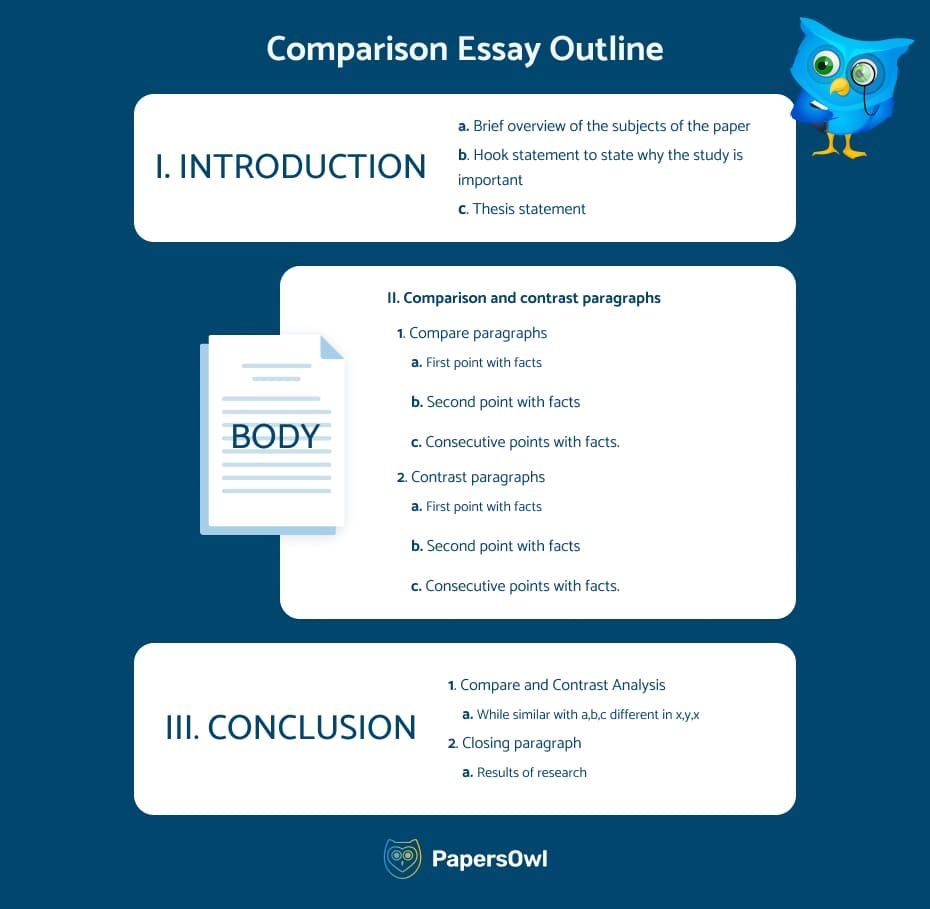
In our comparative essay outline example, we’ve put together a basic template of what the paper should look like. Mind you, this is an informal template for an introduction to compare and contrast essay. If your course requires you to submit a formal outline in APA or MLA style, be sure to draft one according to the latest style guide.
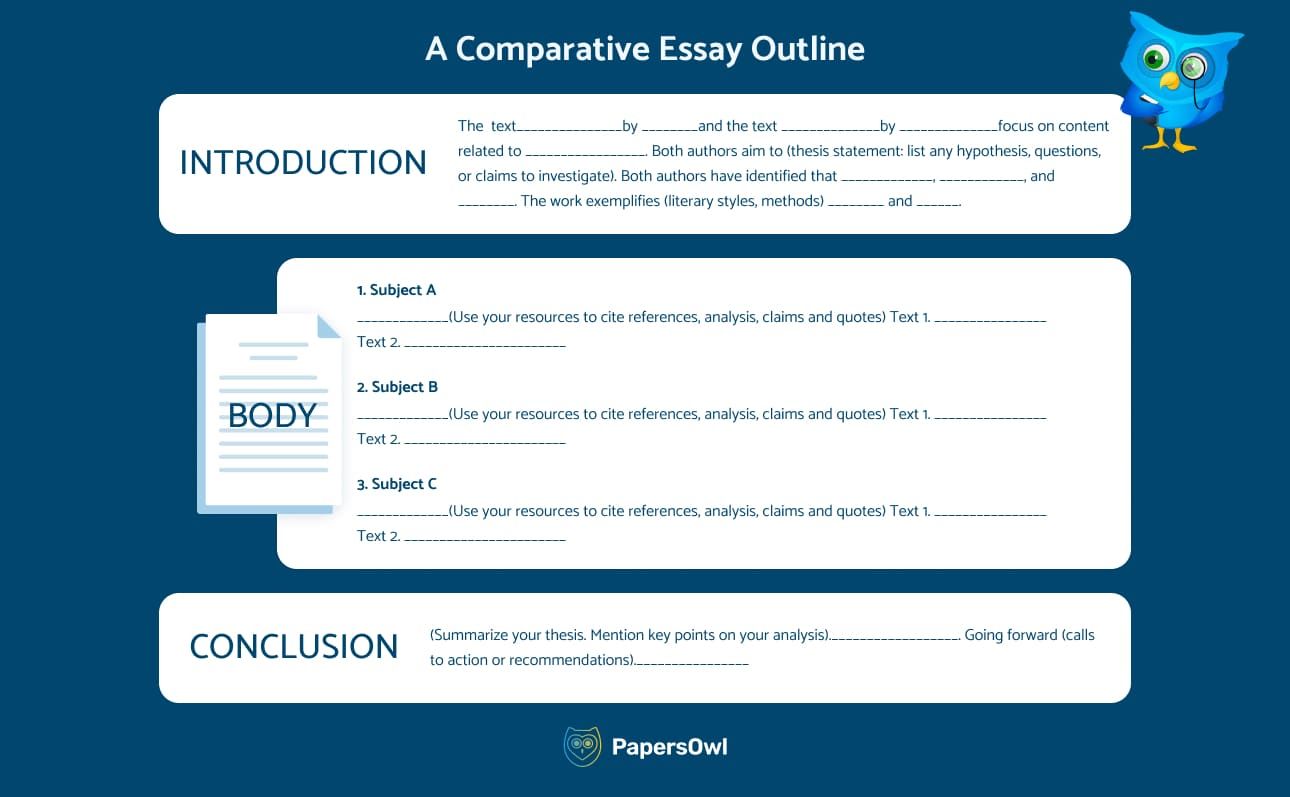
You can use this comparative essay outline template to draft your paper as a means to get your ideas out on paper. Like many students, you could be short on time or not have the ability to complete your paper. In this case, you can use our writing service, and we’ll draft a perfect custom text for you to meet any deadlines you have.
We all have our opinions and curiosities, and sharing them with the world is a fun experience. And you can through an effective contrast and comparison paper. Just be sure to pick subjects that can be analyzed and back up your conclusions with data, and you’ll be well on your way to unlocking the world’s inner workings. Sometimes you may find a lack of inspiration for a topic or are stressed to get a high grade. We are here to help 24/7/365 to get you out of a jam and write your papers for you in your time of need. So reach out to us, and we are here to help.
Tips to Write a Compare and Contrast Essay

If you’re wondering how to write a comparison essay fast, there are a few tricks to make the most of your time. Follow these steps professional writers use, and you’ll get your paper done to meet the tightest deadlines.
- Brainstorm on a scratch pad : You may be used to using your computer for everything, but for organizing your ideas, old-fashioned scratch paper works best. Draw a side-by-side chart and start listing out the characteristics of your subjects. Mention all the pros and cons, physical characteristics, as well as processes and applications that each possesses.
- Make sure to choose comparable subjects that will make sense to the reader.
- Ensure that the thesis statement is strong and to the point.
- Do good research and ensure that your arguments are clearly stated.
- Build your outline of compare and contrast essay : You can start to compare and contrast essay outline with your data table. Check the required length of your paper and start building a paragraph structure that will meet any bullet points and suffice the word count. Be sure to start off with your most interesting points to keep the reader engaged.
- Draft your paper : Be sure to include a catchy title that is on point with the contents of your work. As a general rule, try not to go over 12 words in your title. Also, note that the thesis statement for the comparison and contrast essay should relate to every section of your text.
- Use transitional words to make it easier for the reader to follow the arguments presented in your essay.
Transitional words and phrases are the connective tissues of an essay, ensuring the flow of ideas is seamless and readers can easily navigate the content. Especially crucial in compare and contrast essays, these transitions aid in clarifying comparisons or highlighting disparities. Words like “similarly,” “likewise,” and “equally” signal similarities between subjects, guiding the reader’s understanding of how two things align. Conversely, phrases such as “on the other hand,” “however,” and “in contrast” denote differences, emphasizing the distinct characteristics of each subject.
- Review your work : Now, it’s time to smooth out some rough patches in your initial draft and fine-tune some sections. Pay special attention to retaining your paper’s focus and meeting all the task requirements. Many students get stuck in this phase and, while they’ve met the requirements, are not happy with the final product. In this case, a comparison essay to buy is a great alternative. Hiring a specialist in your subject is the best way to get a good grade.
There are various factors to consider, such as structure, format, and even finding the right resources. Fortunately, cheap essay writing services such as PapersOwl make the process much easier. Simply provide your instructions, and their professional writers will create an original paper for you.
Comparison Essay Format
Universities are real sticklers for formatting. This may seem like an annoyance for many students, but academic work should be consistent across disciplines to aid analysts in efficiently referencing work and applying it to their own studies. Depending on your course, you may be required to write a comparison essay in MLA format or APA. So armed with the latest style guide of your choice, let’s get down to how to write a good comparison essay outline.
Bringing It All Together
Comparing and contrasting is an intrinsic part of our daily decision-making. From choosing restaurants to assessing products, we inherently evaluate based on similarities and differences. Yet, when tasked with a formal compare and contrast essay in academia, many students falter. This guide aims to simplify the process, providing structure and clarity. Emphasizing the importance of a solid thesis, structured format, and the use of transitional phrases, it offers a blueprint for effective essay writing.
Readers also enjoyed

WHY WAIT? PLACE AN ORDER RIGHT NOW!
Just fill out the form, press the button, and have no worries!
We use cookies to give you the best experience possible. By continuing we’ll assume you board with our cookie policy.
Take 10% OFF— Expires in h m s Use code save10u during checkout.
Chat with us
- Live Chat Talk to a specialist
- Self-service options
- Search FAQs Fast answers, no waiting
- Ultius 101 New client? Click here
- Messenger
International support numbers
For reference only, subject to Terms and Fair Use policies.
- How it Works
Learn more about us
- Future writers
- Explore further
How to write a comparative essay
A step-by-step guide with instructions, outlines, and samples
Writing a great comparative essay means highlighting the similarities and differences between two things in a systematic manner. Start by choosing the parameters (items) to compare, write an outline, and fill in the details for each section. Make sure to have an introduction and conclusion.
The comparative essay is one form of document that you will probably be expected to write at some point over the course of your college career. The purpose of this article is to provide you with a thorough overview of the comparative essay. Specific things that will be addressed include:
Purpose of the comparative essay
Explanation of comparative models, how to analyze subjects, elements of a good comparative essay, how to write a great comparative essay.
- Samples/examples
- Best practices and advice
- Additional information
By the end of this article, you should feel more confident about your own knowledge of what a comparative essay is and the best ways to go about writing one (if you haven't decided to buy a comparative essay from Ultius ).

The fundamental purpose of a comparative essay is to elaborate the similarities and differences between two things in a systematic manner.
An effective comparative essay will leave the reader with much greater clarity about the natures and properties of the things that have been compared.
This could potentially serve as a basis for making a decision in favor of one or the other thing.
A comparative essay is different from, for example, an argumentative essay in that the comparative essay does not make a case for either of the two things under comparison. Rather, the point is to simply set up the comparison so that the reader will have as much information about the two things as possible.
| Argumentative essay | Comparative essay | |
| To make a clear case for a position on a given subject or a plan of action | To highlight the similarities and differences between one object and another object | |
| Objective, first-person or third-person, appeals to reason and evidence, some subjective anecdote allowed | Objective, third-person, appeals to reason and evidence, personal anecdote should be avoided | |
| "The Republican Party is a threat to the long-term stability and well-being of America, so everyone must vote Democrat." | "The Republicans and the Democrats disagree on a lot, but they also have some underlying similarities." | |
| Philosophical journals, political magazines, editorials | Scholarly journals, more viewpoint-neutral magazines |
Why are comparative essays important?
The comparative essay is an important form of document because when you have to make a decision or choose a side in an argument, you will want to know as much as possible about the two options under consideration—and a good comparative essay on the subject can bring out both the similarities and the differences between the options, thereby clarifying the stakes at play.
For example, a comparative essay could address the similarities and differences between any of the following pairs:
- The Republican Party and the Democratic Party
- Christianity and Marxism
- The Big Bang and creationism
- The Light or Dark side of the Force from Star Wars
- The revolutionary and the reformist perspectives on social change
By developing a comparative essay on any of these pairs, you can not only understand each item of under comparison is a more thorough way, you can also get closer to figuring out which item you prefer.
For example, a solid comparative essay on revolution vs. reformism could not only help you understand what each of these items entails, it can also help you figure out whether you would rather be a revolutionary or a reformist. Likewise, if you only have time to binge watch one show, then a comparative essay could help you figure out whether you would prefer to go with Game of Thrones or Westworld .
When writing a comparative essay, there are several models you can use in order to ensure that you set up your comparison as effectively as possible.
Venn diagram
The Venn diagram is a classic, and surely, you're familiar with it. This is the model of two overlapping circles, where each circle belongs to one item of comparison: features shared by both items (similarities) go in the overlapping middle zone, whereas features that are not shared go in the outer areas. For example, here is a Venn diagram that compares humans against gorillas.
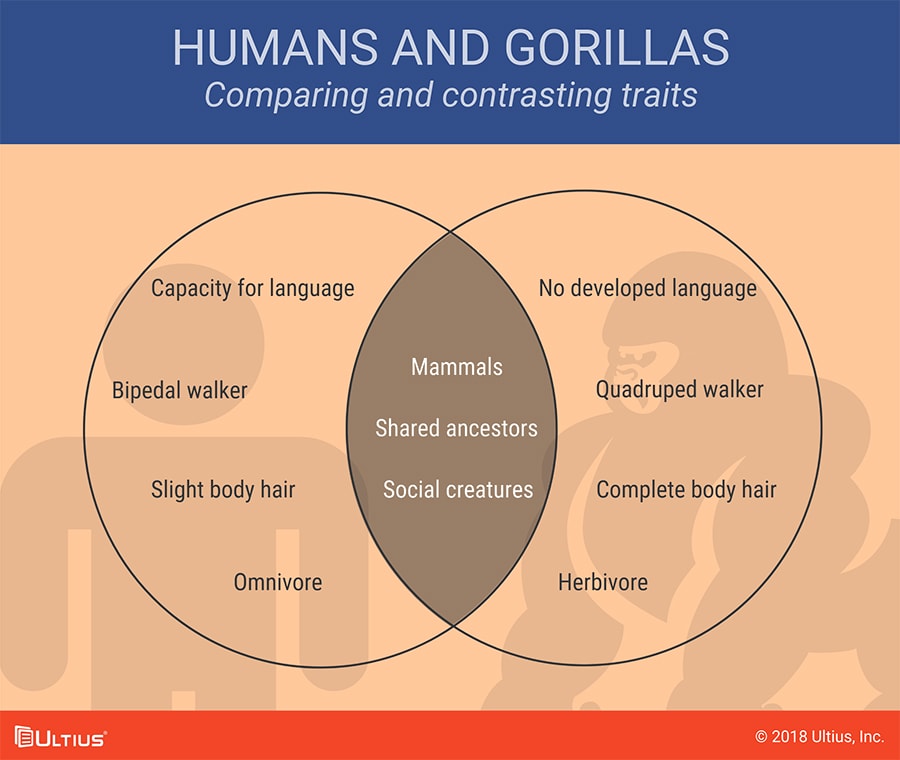
When using the Venn diagram model, it is important to note that the differences must be symmetrical. In other words, every difference you list on one side of the comparison must be matched by a difference on the other side.
For example, if you were comparing Apple and Amazon, then for the parameter of "founder," you can list "Steve Jobs" in one circle and "Jeff Bezos" in the other. But it wouldn't make sense if you just listed one or the other: you must list something for each of the items of comparisons under the selected parameter of comparison.
In the Venn diagram above, the first parameter is "language," so for humans it is listed that we have a capacity of language, whereas for gorillas it is listed that they do not.
You don't need to worry about this kind of symmetry when it comes to the similarities, since you will list the same thing for both items of comparison (which means you only have to list it once, in the overlapping zone). In the example, above, the fact that both humans and gorillas are mammals is thus listed just once in the middle.
The dialectical method
The dialectical method is important within the discipline of philosophy, and it has been used to great effect by thinkers such as Socrates and Hegel and Kierkegaard.
This involves holding two ideas or items in tension with each other, to better clarify not only the ideas themselves but also the dynamic relationship that exist between the ideas. The first idea is called the thesis , and the second idea is called the antithesis .
For example, Romanticism could be dialectically compared against the Enlightenment that came before it, because Romanticism was in some ways a rejection of the previous worldview.
Need help? Essay writing services from Ultius can help you produce a great sample compare and contrast essay.
So, by setting up a comparison between Romanticism and the Enlightenment, it becomes possible to see both the continuities (or similarities) between the one and the other, as well as the contradictions (or differences) between them.
| Enlightenment | Romanticism | |
| reason, logic | imagination, passion | |
| Western Europe | Western Europe | |
| science, rationality, objective truth | poetry, enchantment, subjective truth | |
| superstitious religion | overbearing rationality | |
| yes | yes |
Berlin, Isaiah. The Roots of Romanticism . Princeton: Princeton U P, 2013. Print.
From the table above, it is clear that we are able to understand both Romanticism and the Enlightenment better if we set them up in terms of dialectical contrast.
Clearly, they are different in some important ways (logic vs. passion, for example), but we can also see that they are in continuity with each other (both happened in Western Europe and responded to previous developments). This comparison also leads one to wonder about whether it would be possible to make a synthesis that takes the best from both the thesis and the antithesis
A good comparative essay can lead one to ask such questions and pursue such lines of inquiry.
To analyze your subjects for a comparative essay, you need to identify clear parameters, or axes, in terms of which your two selected items can be compared. For example, in the table above, Romanticism and the Enlightenment were compared along the axis of " epistemology ". But that axis won't be relevant to all subjects.
Your job when preparing to write a comparative essay is to identify the specific axes that are relevant for the items that you are comparing. Why is the comparison interesting, and what insights are you trying produce? The answers to those questions will determine how you decide to frame your comparison.
For example, we could compare the Democratic Socialists of America (DSA) against the Democratic Party in terms of the axis of membership. This would reveal that the DSA has far fewer registered members than does the Democratic Party.
We could also compare them on the axis of healthcare policy, where it may be found that the DSA and the Democratic Party agree about the importance of universal coverage. When we look at the axis of economics, though, we may find that the DSA is much more radical in its proposals than the Democratic Party.
| Axis | DSA | Democratic Party |
| relatively few members | one of the major parties | |
| values universal coverage | values universal coverage | |
| calls for a radical restructuring of all economic relations | tends to seek reform and regulation within capitalism |
The problem of identifying relevance
In principle, any one thing in the world could be compared with any other thing in the world. For example, you could compare your shoe with the moon, and conclude that one similarity is that they both exist within the Milky Way galaxy.
But this would be a meaningless point (even if it may make for some interesting poetry). It is important for you to figure out what exactly you are trying to determine through your comparative essay. What is your purpose for writing it?
This will help you choose two items where setting up a dialectical contrast between them will produce actual insight, and it will also help you to choose the proper parameters by which to compare those items.
For example, suppose that you are running a business, and there are two expansion options open in front of you. It would be logical for you to compare and contrast these options, since this will help ensure that you are making your decision with as much knowledge and insight as possible.

Likewise, one parameter that you are sure to consider is: which option will make your business the most money? If you pick parameters that are meaningless, then you will obtain no real insight that can help you make the important decision.
Using a rubric
Once you have identified both the two items of comparison and the axes along which they will be compared, you can proceed to analyze the items by applying the axes in the form of a table or rubric.
This is what has been done, for example, in the tables that have been developed above in this article. In the left-most column, list the parameters you have selected in order to compare your items. Then, in the top-most row, list the items.
Then go ahead and list the relevant details for each parameter for each of the two items. This will produce a table where you can see how each item measures up against the other for each parameter.
| Business axis | Marketing | Human Resources |
| Profits | Raise prices | Cut staff |
| Increase customer base | Pursue advertising | Hire expert |
| Saving money | Cut ad budget | Cut/reduce staff |
The important thing is to be systematic when you are making your comparison: it should not seem random or arbitrary. Thus, it is important to carefully select both the items and the parameters for comparison, and then to proceed to address each item/parameter combo in turn.
There are several elements that are a part of any good comparative essay.
Effective selection of items
A strong comparative essay has well-chosen items for comparison, with the comparison producing actual insights of value through the juxtaposition of the two items. If the items appear to be chosen for no apparent reason, or if the comparison does not in fact produce insight, then the comparative essay would be quite weak (or at any rate pointless).
The comparative essay is not meant to make an argument in favor of one thing or another, but it is meant to produce knowledge and insight about the two things under comparison. In order to compare and contrast items in an effective way, the two items must be different enough from each other, but they should also not be so different that it just feels absurd to even compare them at all.
| Items | Good or bad? | Rationale |
| Democracy and communism | Good | They belong to the same class (ideology), but they are substantially different on some parameters (like liberty) |
| Democracy and potatoes | Bad | They don't belong to the same class, so there is no natural basis for comparison |
| Potatoes and rice | Good | They belong to the same class (food), and there's an obvious axis of comparison (nutrition) |
Effective selection of parameters of comparison
A good comparative essay not only includes well-selected items of comparison, it also includes well-selected parameters of comparison. Between any two selected items, you could theoretically make an endless number of comparisons.
But a good comparative essay identifies parameters of comparative in terms of salience , or the reasons why anyone would be interested in the comparison in the first place. This can be difficult, because in principle, any comparison could be interesting, depending on the audience of the comparative essay and the intended purpose of the essay.

For example, one could use the parameter of zodiac sign to compare Romantic artists against Enlightenment artists.
This could be very interesting to people who are very serious about the zodiac, but it would probably seem ridiculous to just about everyone else.
But if you were writing for an audience of zodiac fanatics, then this comparison could actually be a success.
So, there is no parameter of comparison that is "inherently" bad. Rather, the point is to find parameters that highlight specific salient aspects of the selected items.
For example, when comparing Romanticism against the Enlightenment, core values would be a solid parameter of comparison, because that will surely help produce insights about how worldviews changed from the one paradigm to another.
Strong organizational structure
If you want your comparative essay to be a success, then it absolutely must have strong organizational structure . This is because an effective comparison must be easy for your reader to follow. It can't just jump all over the place at random, which not only be confusing but could also result in the reader forgetting what the point of the comparison was in the first place.
In general, there are two ways in which you can organize your comparative essay. In the first format, each of the parameters would be considered in the section for similarities and the section for differences.
In the first format the comparative essay is organized in terms of similarities and differences, whereas in the second format the essay is organized in terms of parameters of comparison.
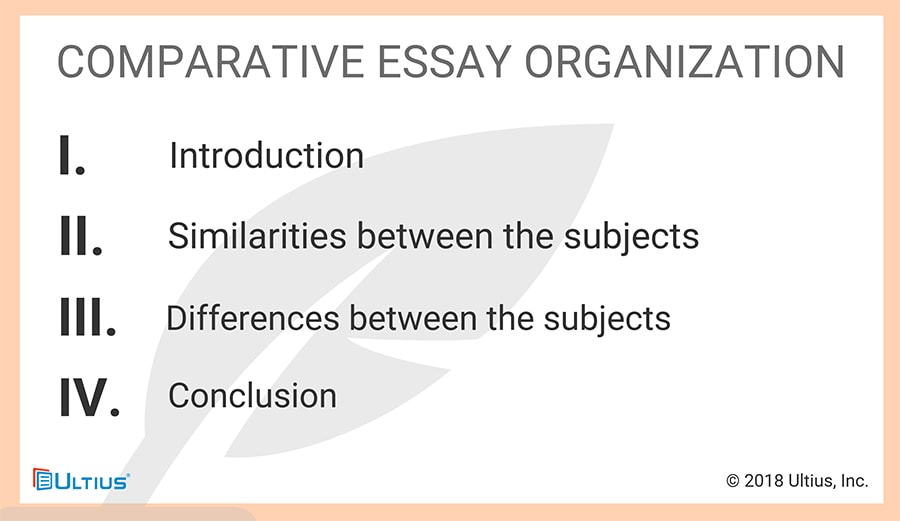
In the second format, both similarities and differences would be considered within each of the parameter sections.
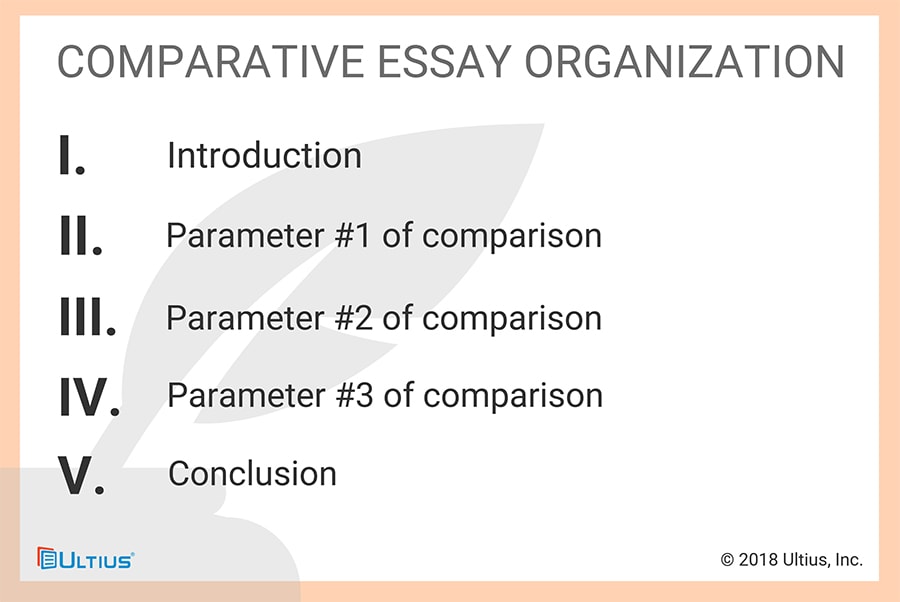
Both these are formats are good, and a strong comparative essay could be built around either one.
The important thing is to have a clear system and to not make your comparisons random.
There needs to be an organizational structure that your reader can easily follow.
There are steps you can follow in order to ensure that your comparative essay has all the elements that will be required in order to make it great.
Ask yourself about your intention
If you have selected two items for your comparative essay, then you should start by asking yourself why you selected those two items. What is it about the two items that made you think it would be a good idea to compare them? (Or if you were assigned the two items, then why do you think those items were selected by your professor?)
The point here is that the items selected for a comparative essay are non-random. They are selected because that specific comparison should be able to yield interesting insights (unlike research papers ).
For example, if you are writing a comparative essay on the dogs vs. cats, then are you writing this from the perspective of evolutionary biology? Or are you perhaps writing it in order to inform potential pet owners who are debating whether they want a dog or a cat?
The purpose of your essay will determine what parameters you will select in order to compare your two items. This means that you should have an intended audience in mind, and you should also have specific questions you would like to know more about.
| Intention | Example of an appropriate parameter |
| To better understand the evolution of dogs and cats | Biological taxonomy |
| To determine whether someone should get a dog or a cat | Risk of allergies |
| To evaluate the relative popularity of dogs vs. cats | Number of pet owners in the nation |
In short, in order to develop effective parameters for your comparative essay, you have to ask yourself why you are writing it and who would be interested in the insights produced by the essay. This can help ensure you select both appropriate items and appropriate parameters for comparison.
Develop a structural outline
It is very important that you do not just jump into your comparative essay and start writing it without a plan. That is a recipe for disaster, and the comparisons will almost certainly turn out random and confusing. Rather, you should begin with a solid outline .
A good outline will do three main things:
- 1. Identify the selected items of comparison in the introduction/thesis
- 2. Utilize one of the two organizational formats described above
- 3. Provide a roadmap for how you intend to systematically follow through on the comparison
For example, here is how an outline could look for a comparative essay on Romanticism vs. the Enlightenment.
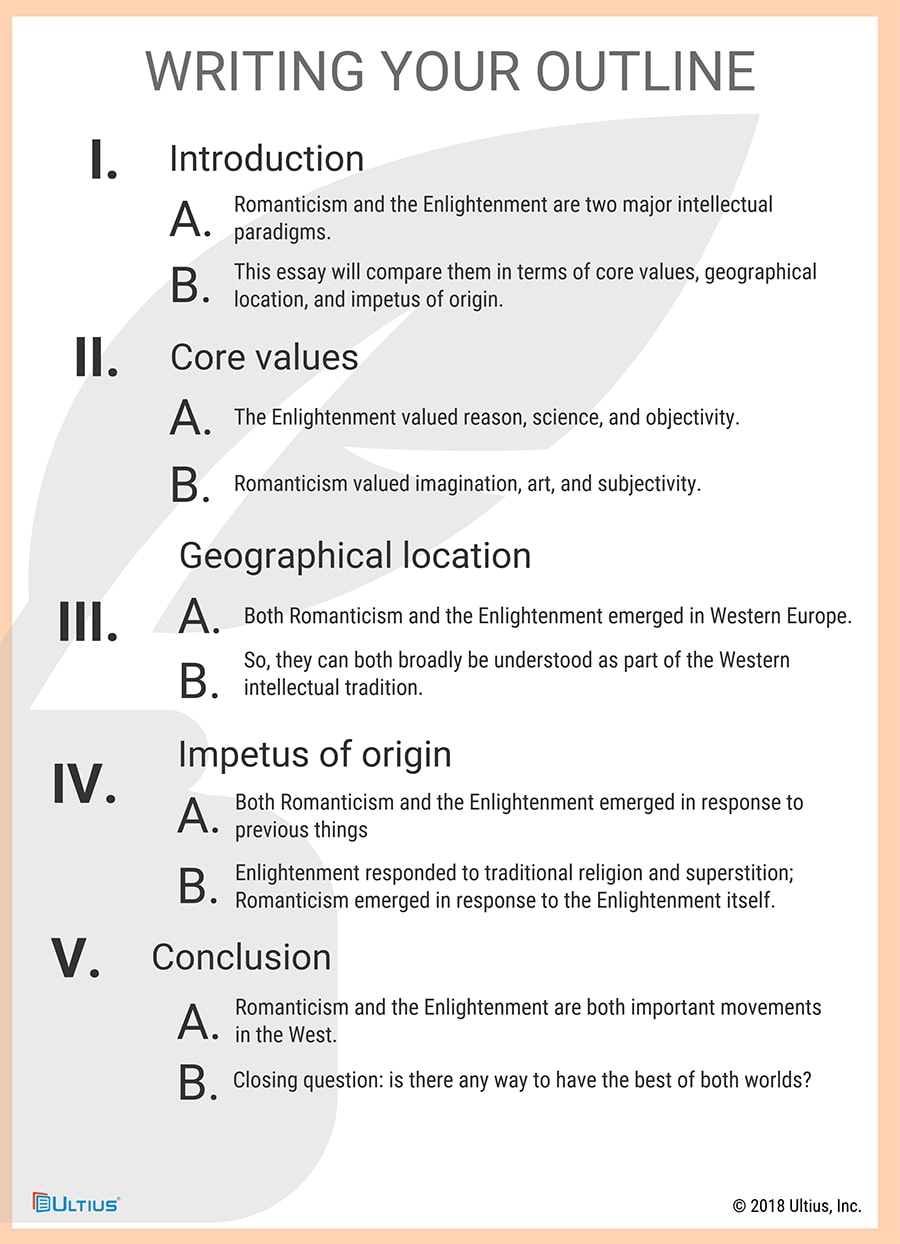
In this sample outline, the format that is used dedicates a paragraph to each of three parameters of comparison, and both similarities and differences are addressed for each of those parameters.
This is the kind of logical flow that you will need to have in order for your comparative essay to turn out great.
Write in a systematic way
A comparative essay is not a place to get too creative with your writing, whether in terms of organization or in terms of style.
Rather, you should focus on simply carrying out your comparison, point-by-point and in a way that is easy for your reader to follow. This can get a little tedious, so if that is a problem for you, then you should make sure that you set aside enough time to work on your comparative essay little by little.
For example, if your essay has three parameters, then you could write a section on the first parameter today, the second parameter tomorrow, and the third parameter the next day.
The important thing is for you to ensure that you consider each of your two selected items in terms of each of your selected parameters. This needs to be done in a smooth and logical manner, such that your reader knows where you are in the comparison. There should be no jumping around, and there should be no departure from the basic format or structure.
Example comparative (compare/contrast) essay
Best practices/tips.
We have now arrived at the end of this guide, and you should have a much better idea of what makes a comparative essay successful and how you can go about writing one. It may be helpful to now summarize some of the main points that have been addressed here.
Let's address five main points.
1. Ensure that you select appropriate items for comparison
The two items that will be compared in your comparative essay should be carefully selected. The items should have some shared features and be in the same "class" of items, but they should also have substantial differences to which you are trying to call attention. If the items are too similar, then there would be no point in the comparison, but if they are too different, that can also make the comparison meaningless.
2. Select effective parameters of comparison
Your comparative essay shouldn't compare anything and everything between your two items; rather, the parameters should be specifically selected to highlight specific, salient similarities and differences. In order to determine what parameters would be effective, you have to ask yourself why you are writing your comparative essay and what sort of insights you intend to produce about the items being compared.
3. Use tools and models in an effective way
The Venn diagram is one tool that can be very helpful in conceptualizing your comparative essay, especially if you are a more visual kind of learner. Tables, rubrics, and outlines will also work to help ensure that you are developing a strong backbone of logic and systematic reasoning for your comparative essay. These and other tools may even help you reconsider your initial choices of items and parameters, if you realize that significant insights are not being produced.
4. Choose an organizational format, and stick with it
There are two main ways in which to structure an effective comparative essay, which have been described above. You can dedicate one section to similarities and one section to differences; or, you can dedicate a section to each of the parameters of comparison. This second option is usually more effective, especially if you are new to comparative essays. But either way, it is crucial that you stick to your chosen format and do not jump around and confuse the reader.
5. Seek assistance if you need it
If you are still uncertain about how to write a successful comparative essay, then Ultius is here to help. Our writer help section has many tools like this one available on various types of essays; we have a huge writer help section that contains all sorts of information on pretty much any writing-related questions you may have; and we also have elite professional writers who can produce a sample comparative essay for you on any subject of your choosing. We are here for you, and if you have any further questions about how to write a comparative essay, then you should feel free to reach out.

Tested Daily
Click to Verify
About The Author
This post was written by Ultius.

The Ultius Promise
With every order, you can count on the following:
- Delivered on time
- 100% original
- Free revisions
- Awesome 24/7 support
- World-class writers
- Writer Options
- Custom Writing
- Business Documents
- Support Desk
- +1-800-405-2972
- Submit bug report
- A+ BBB Rating!
Ultius is the trusted provider of content solutions for consumers around the world. Connect with great American writers and get 24/7 support.
© 2024 Ultius, Inc.
- Refund & Cancellation Policy
Free Money For College!
Yeah. You read that right —We're giving away free scholarship money! Our next drawing will be held soon.
Our next winner will receive over $500 in funds. Funds can be used for tuition, books, housing, and/or other school expenses. Apply today for your chance to win!
* We will never share your email with third party advertisers or send you spam.
** By providing my email address, I am consenting to reasonable communications from Ultius regarding the promotion.
Past winner

- Name Samantha M.
- From Pepperdine University '22
- Studies Psychology
- Won $2,000.00
- Award SEED Scholarship
- Awarded Sep. 5, 2018
Thanks for filling that out.
Check your inbox for an email about the scholarship and how to apply.

Comparative Essay
Comparative essay generator.
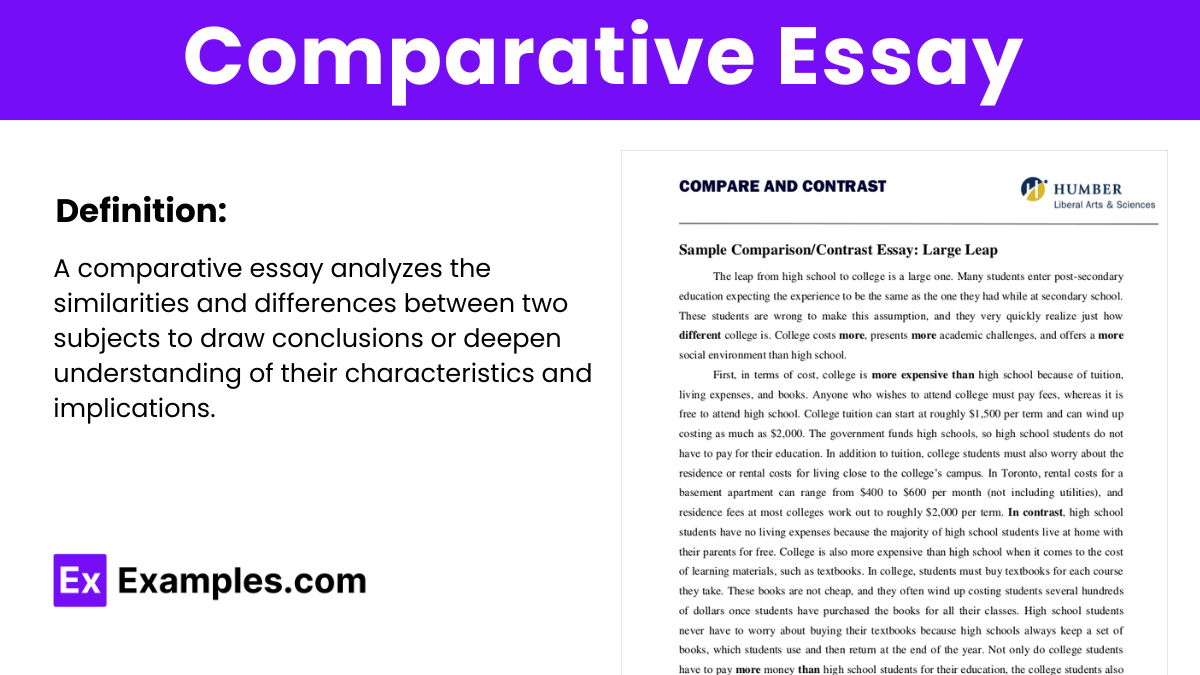
Academic institutions always provide writing exercises to students so that the level of understanding that the students can have about a particular subject manner is widened. One of the most common academic essay examples that’s given as writing assignment to students is the comparative essay. A comparative essay, also known as comparison essay or compare and contrast essay, is the type of essay that specifically analyzes two subject matters. There are a lot of academic fields where writing a comparative essay can be beneficial to students and their educational undertaking.
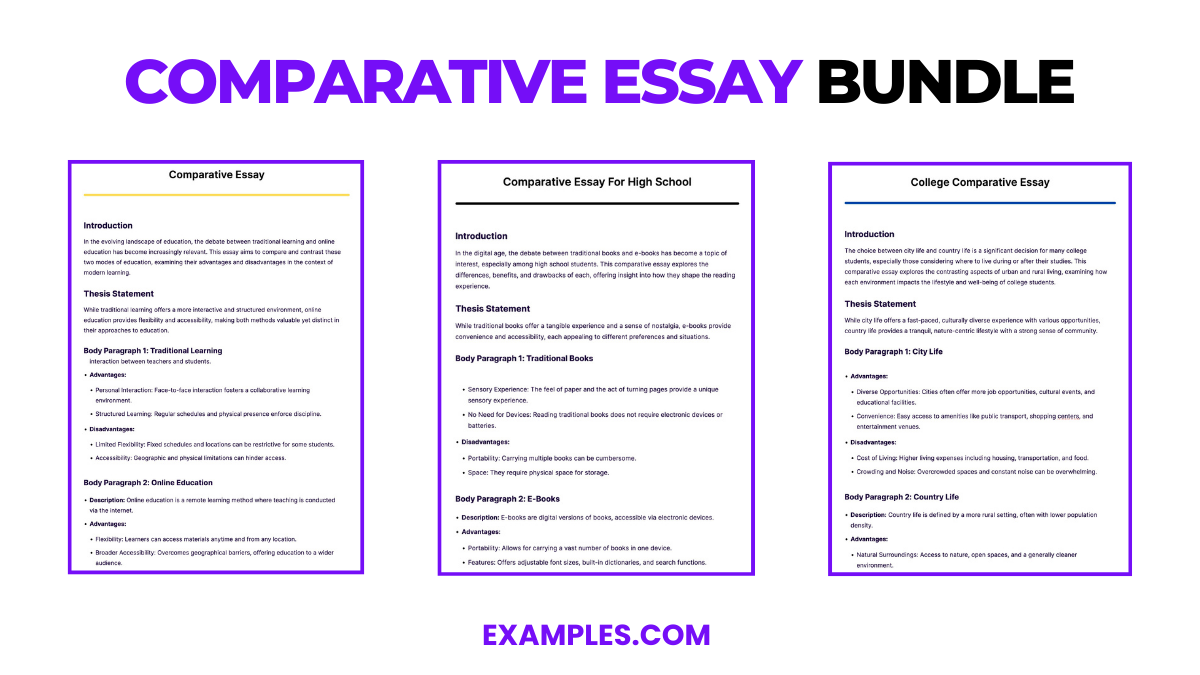
Download Comparative Essay Bundle
A comparative essay can either compare or contrast two topics, theories, materials and other subjects of discussion. However, there are activities where both comparisons and contrasts are necessary to be presented. If you are required to write a comparative essay but is unaware on how you can do one effectively, you can browse through the samples that we have gathered for you so you can be more knowledgeable on how to structure both the content and layout of this kind of essay.
What is Comparative Essay?
A comparative essay is a type of academic writing where the writer analyzes and discusses the similarities and differences between two or more subjects. These subjects can be theories, works of literature, historical events, scientific processes, or social phenomena, among others. The main purpose of a comparative essay is to highlight the contrast and comparison to derive a deeper understanding or to make a point about the subjects being examined.
Comparative Essay Format
Introduction.
Hook: Start with a compelling sentence to grab attention. Background Information: Provide necessary background information on the subjects being compared. Thesis Statement: Clearly state the basis of comparison and what you aim to prove or reveal through the essay.
Body Paragraphs
Each body paragraph should focus on a specific point of comparison, discussing both subjects:
Paragraph 1: Aspect 1
- Topic Sentence: Introduce the first point of comparison.
- Subject 1 Detail: Discuss how the first subject approaches this aspect.
- Subject 2 Detail: Discuss how the second subject approaches this aspect.
- Comparison and Analysis: Compare and contrast the two subjects on this point and analyze the significance of the differences or similarities.
Paragraph 2: Aspect 2
- Topic Sentence: Introduce the second point of comparison.
- Subject 1 Detail: Details for the first subject.
- Subject 2 Detail: Details for the second subject.
- Comparison and Analysis: Exploration of how they differ or are similar in this aspect and why these observations matter.
Paragraph 3: Aspect 3
- Topic Sentence: Present another point of comparison.
- Subject 1 Detail: Examination of the first subject in this context.
- Subject 2 Detail: Examination of the second subject.
- Comparison and Analysis: Discuss and analyze differences or similarities.
- Summary of Main Points: Recap the main similarities and differences that have been analyzed.
- Restatement of Thesis: Restate the thesis in light of the evidence discussed in the essay.
- Closing Thought: End with a final thought or reflection that emphasizes the significance of the comparison and possibly suggests broader implications or future considerations.
Comparative Literature Essay
Comparing themes in “1984” by george orwell and “brave new world” by aldous huxley.
Hook: Imagine living in a world where your every move is monitored, and your very thoughts are not your own.
Background Information: “1984” by George Orwell and “Brave New World” by Aldous Huxley are seminal works of dystopian fiction that explore the grim futures of societies controlled by oppressive governments.
Thesis Statement: While both “1984” and “Brave New World” depict societies where governments have stripped away individual freedoms, they differ significantly in their portrayal of surveillance, control mechanisms, and the response of the individual to these oppressions.
Paragraph 1: Mechanism of Control
- Topic Sentence: Orwell and Huxley present fundamentally different mechanisms of control that reflect their respective visions of dystopia.
- 1984 Detail: In “1984,” control is exerted through constant surveillance, symbolized by the omnipresent eyes of Big Brother and the threat of the Thought Police.
- Brave New World Detail: Contrastingly, in “Brave New World,” control is maintained through the manipulation of science and technology, notably through the use of soma, a drug that suppresses emotions and dissent.
- Comparison and Analysis: Orwell’s use of overt suppression through fear versus Huxley’s method of covert control through pleasure highlights different critiques of how societies might lose their way.
Paragraph 2: Resistance and Compliance
- Topic Sentence: Both novels feature protagonists who initially resist the societal norms imposed upon them, but their journeys and fates diverge markedly.
- 1984 Detail: Winston Smith’s resistance is crushed by the regime, symbolizing the futility and doom of individual rebellion in Orwell’s world.
- Brave New World Detail: In contrast, John the Savage’s resistance ends with his suicide, a tragic yet potent act of defiance against the dehumanizing conformity of Huxley’s world.
- Comparison and Analysis: While both endings are bleak, they illuminate the authors’ differing views on the possibility of successful defiance against totalitarian regimes.
Paragraph 3: Role of Technology
- Topic Sentence: Technology plays a central role in both novels, yet its use and implications are portrayed differently.
- 1984 Detail: Technology in “1984” is primarily used for oppression and surveillance, as seen in the telescreens and hidden microphones.
- Brave New World Detail: In “Brave New World,” technology is employed to ensure happiness and social stability, primarily through genetic engineering and conditioning.
- Comparison and Analysis: These contrasting uses of technology reflect Orwell and Huxley’s different fears about the future: Orwell is concerned with a government that uses technology as a tool for totalitarian control, while Huxley fears a society where technology diminishes human capacities and agency.
- Summary of Main Points: “1984” and “Brave New World” provide stark, compelling visions of future societies, highlighting significant parallels and divergences in themes of control, resistance, and the use of technology.
- Restatement of Thesis: Though both novels forecast dystopian futures dominated by oppressive governments, their distinct explorations of control, resistance, and technological use offer unique insights into the potential paths of modern societies.
- Closing Thought: The enduring relevance of these novels warns us of the precarious balance between societal order and personal freedom, urging current and future generations to vigilantly safeguard their rights and liberties.

Free Download
Comparative Essay For High School
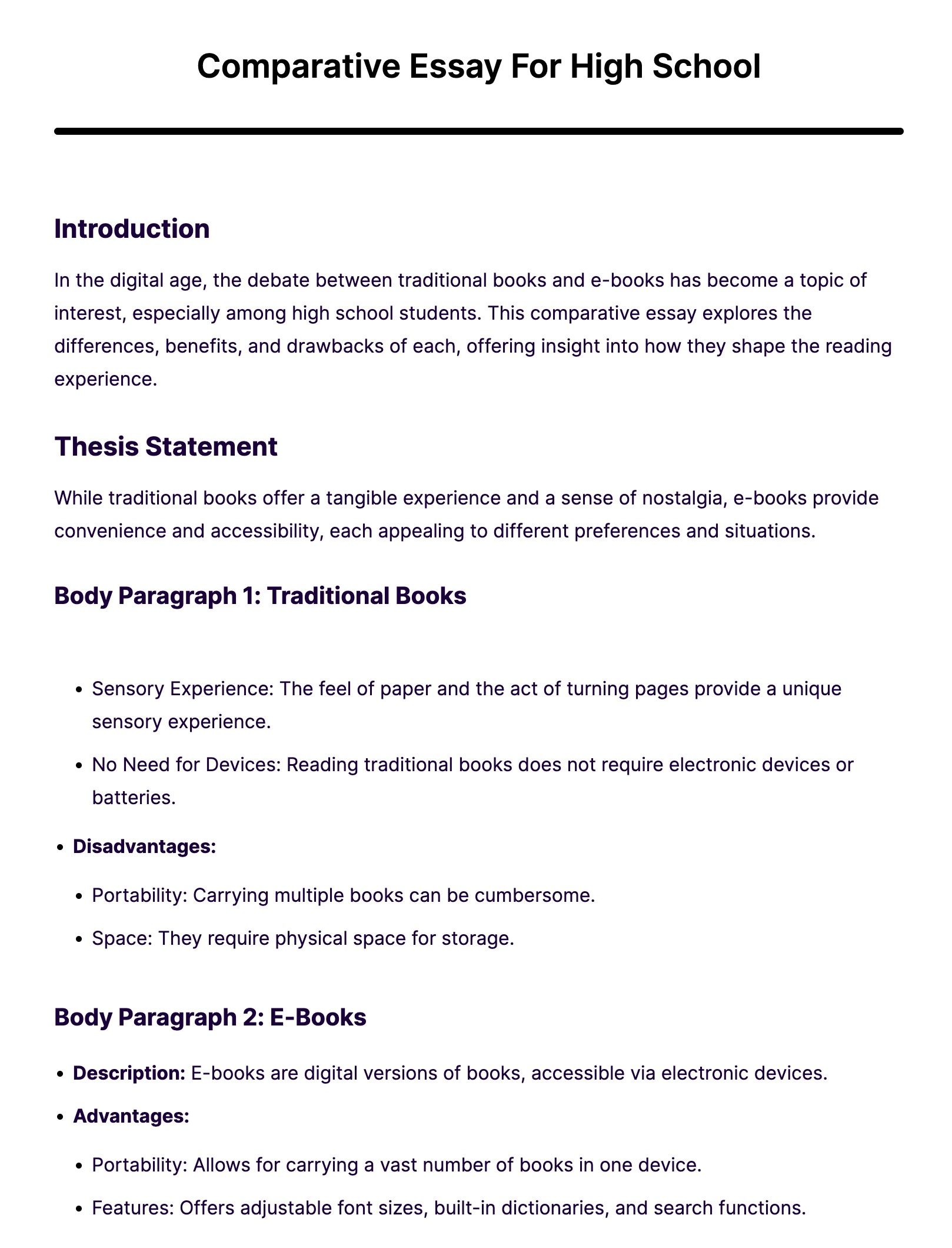
College Comparative Essay
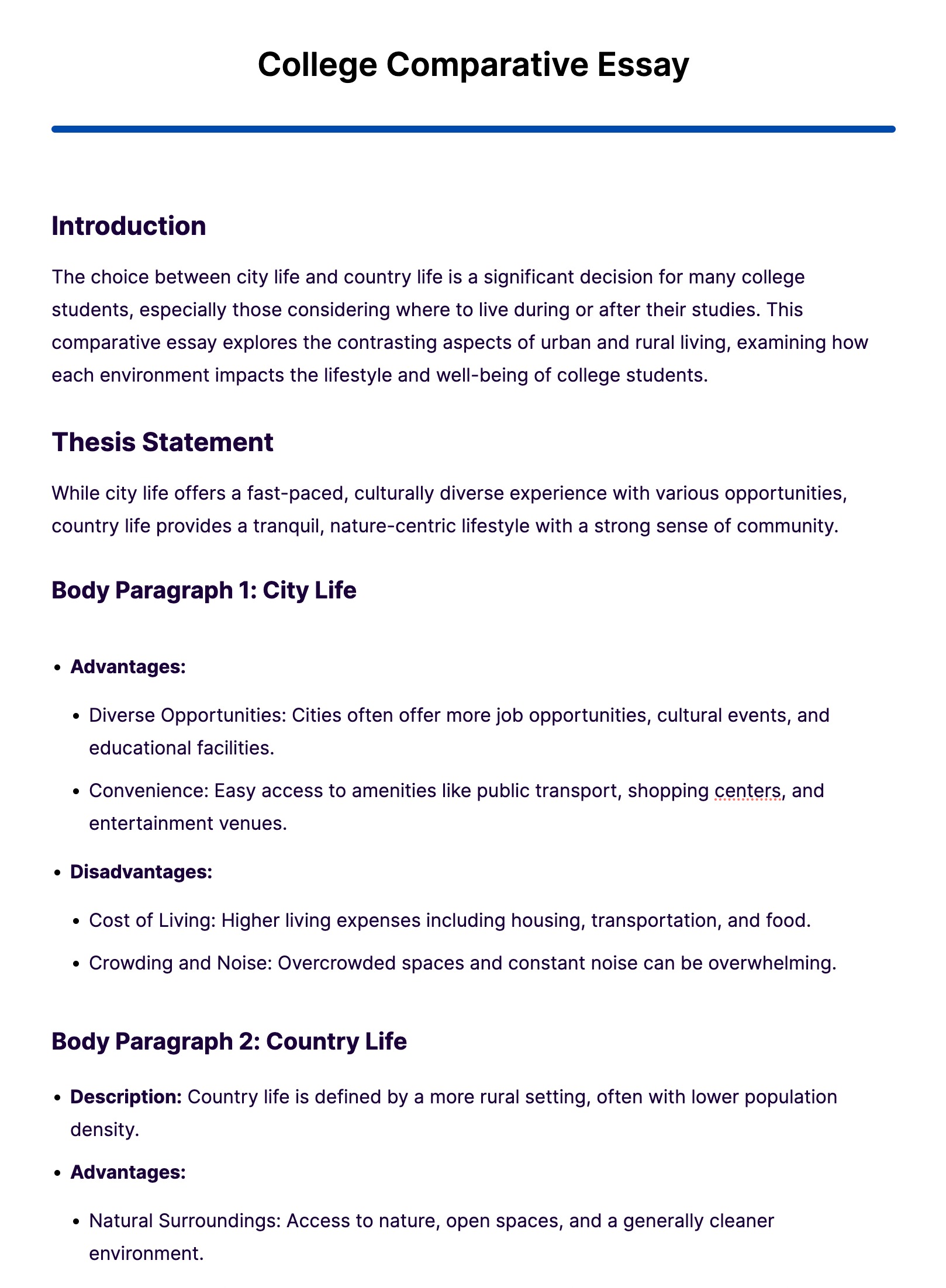
Comparative Essay Plan Template
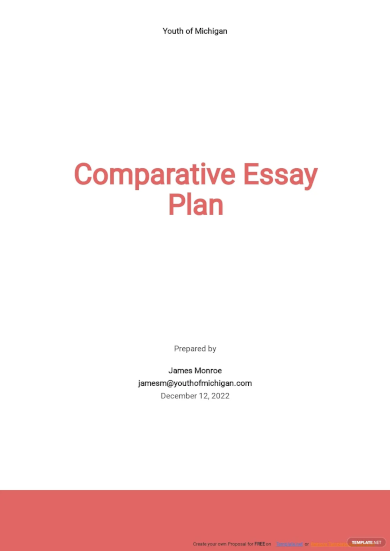
- Google Docs
- Apple Pages
Size: 28 KB
Compare and Contrast Sample Essay
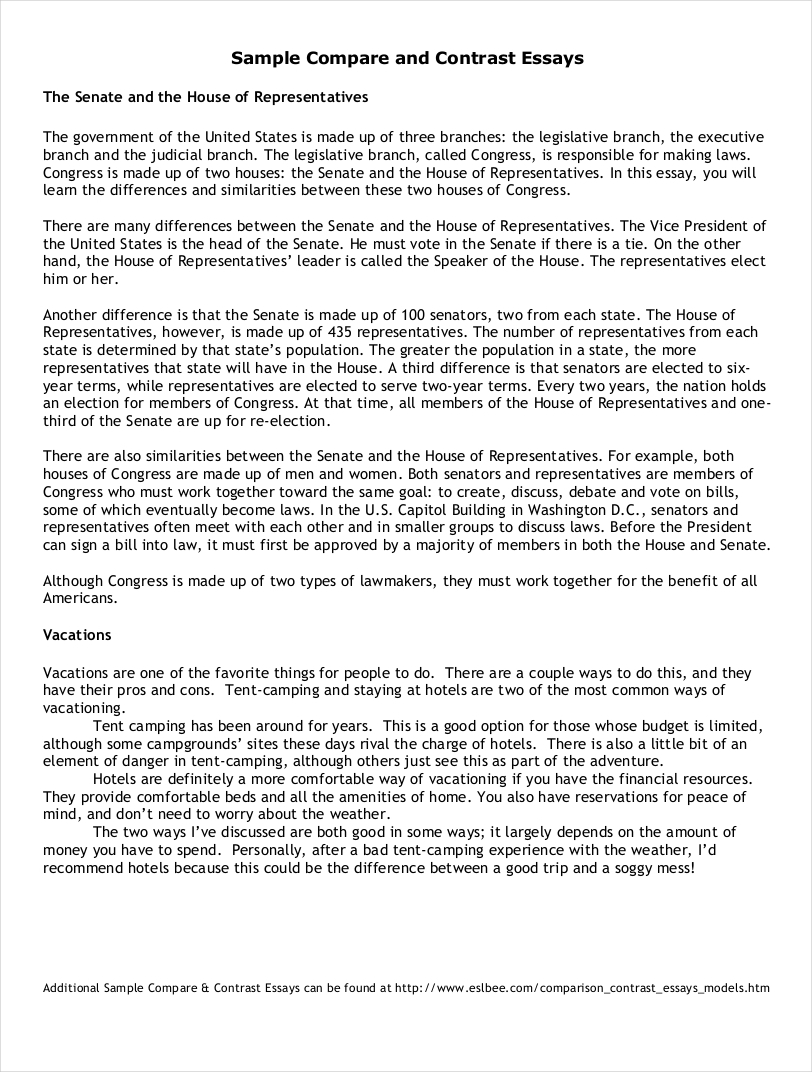
Size: 109 KB
Sample Comparative Essay Format
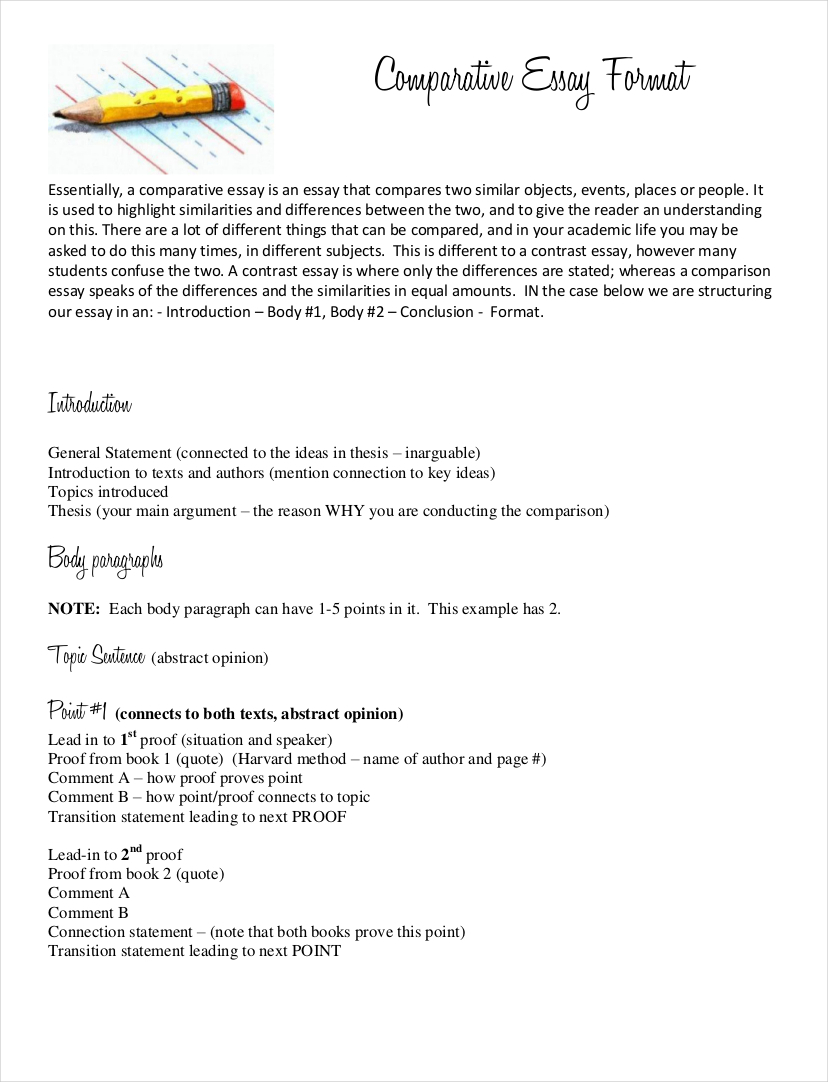
Size: 249 KB
The Concept of Comparative Essays
Different college essay examples are written based on different sets of instructions. Depending on the writing task that you have at hand, the things that you may include in your comparative essay may vary. However, the concept of making a comparative essay remains the same. For it to be clearer in your mind, here is how a comparative essay works:
- A comparative essay is an academic essay that requires students to create a comprehensive and precise comparative report about two things.
- A comparative essay is an organized written material that is meant to provide a comparison that should be easily understood by the target readers. It is set to impress people by providing them the information that they need to be aware of about two subjects and how they differ and/or compare with each other.
- A comparative essay can be written if you have two objects or subjects that can be compared in a level where their similarities and/or differences are relevant or meaningful for a specific purpose.
- A comparative essay can be used in formal writing assignments and it can also be the basis for various research assessments.
- A comparative essay is created through pertaining precise points of comparison. These points should be backed by actual researchers, factual information, and other reliable evidence.
Block Comparative Essay Example
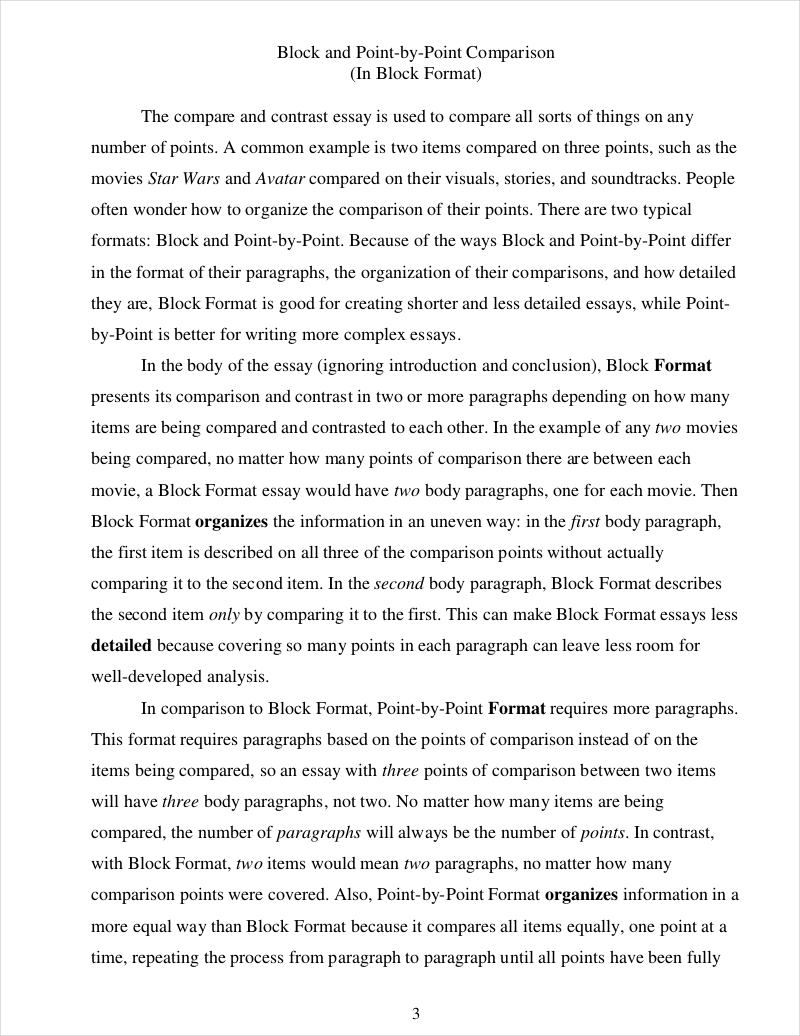
Size: 462 KB
Student Comparative Essay Sample
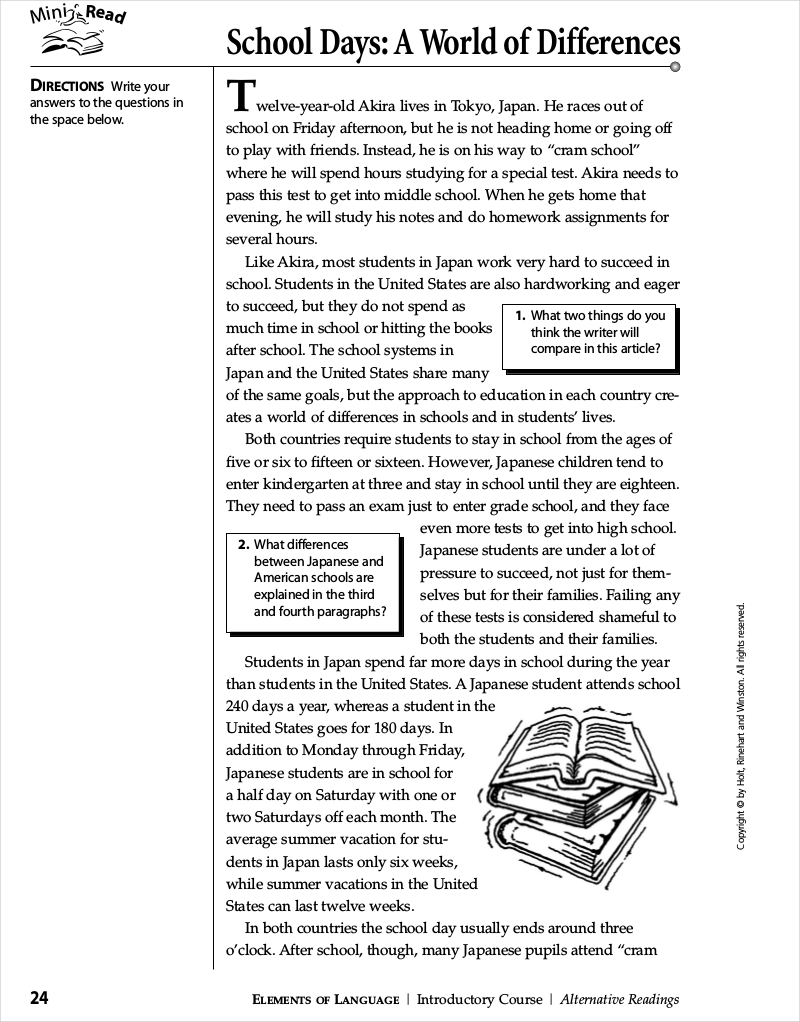
How to Develop the Content of Your Comparative Essay
Before writing a comparative essay, you first need to arm yourself with the information that you need. This will allow you to create a comparative essay that is filled with relevant and helpful information. More so, this can help you veer away from committing common essay mistakes if you are already in the process of actual content writing.
The way that you plan to present your ideas, especially if they are backed up with facts, can make your comparative essay more successful. Listed below are the steps that you may use when developing the content of your comparative essay.
- The first thing that you need to do is to be aware of the question that you need to answer. You need to be aware of the essay prompt so you can address the needs of your readers. It is essential for you to be fully knowledgeable of the essence of the question so you can interpret it accordingly. The content that you will write will only be effective if it is related to the question and if it matches the purpose on why the essay is necessary to be written.
- Know whether there are limits for your discussion . Always identify whether you need to know the similarities or the differences between your subjects. Also, you need to know whether the scope of your essay assignment requires you to do any of these or both.
- Select the ideas that you would like to compare. It is important for you to have an in-depth understanding of the kind of comparison that you will write. The framework of your essay should be based on an actual evaluation that can point out how you were able to perceive the similarities or differences of the subject.
- Assess whether you already have sufficient points for comparison. Your ability to present as many valid points as possible can make a lot of clarifications about the unanswered questions that you can enlighten your readers with.
- Once the points of your comparison are already specified, list down whether they are under the similarities or differences of the two subjects. This step can help you be organized throughout the writing process. With easy access to how subjects are compared, you can be guided on how to use them in your content development.
- Evaluate your list. Your list is only your initial view about the subjects being reviewed or assessed. Hence, further evaluation is necessary. Make sure that you will read through the entire list so you can rank them based on their impact and weight of thesis.
- Chronologically arrange your list based on your basis of comparison . Make sure that you will follow a metric when examining the items that you will place in your actual comparative essay.
- Know the approach that you will use when developing your essay content. Will you be theoretical? Will you focus on answering questions for comparison? It is essential for you to be aware of your basis so your approach can provide you with maximum benefits within the entirety of the content development process.
- Research further about your subjects so you can verify whether your claims and initial claims are correct. This can help you create more topics and gather more evidence that can support your comparison.
- Create a thesis statement where your discussion can set its foundation. This will enable you to start writing the comparative essay that you would like to achieve.
You may think that this is a very long process just for developing the ideas that you will present. In a way, you may be right. However, being prepared and ready on how you will attack and execute the writing assignment can make it easier for you to create a valid discussion.
Comparative Contrast Essay Template

Size: 43 KB
Printable Comparative Essay Sample
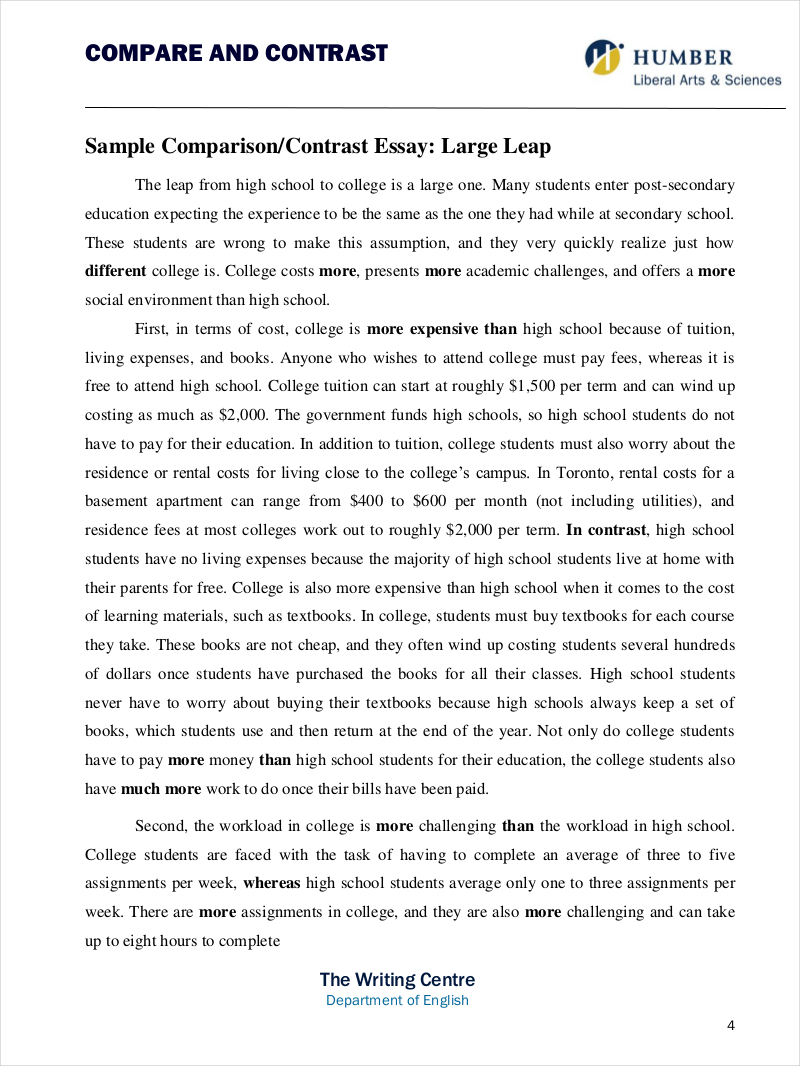
Size: 148 KB
Steps in Organizing Your Comparative Essay Discussion
Aside from knowing the idea of what you will write about, the structure of your essay or the organization of your essay’s content can affect the smooth flow of your discussion. Even during last minute essay writing activities, you can still come up with an outstanding comparative essay if you are already knowledgeable on how you can organize your essay’s idea, content, structure, and discussion. Listed below are some of the ways on how you can efficiently organize your comparative essay’s content.
- Refer to the outline of your comparisons. This is where the items that we have discussed above can be helpful. If you are already guided by your comparisons, then you can easily rank their relevance to the essay that you will write. Referencing your comparisons can make it easier for you to have a thesis statement that you can further discuss.
- Organize your writing strategies. The strategies that you will incorporate into your discussion can make it easier for readers to relate to your point. You need to make sure that your strategies are aligned with your type of comparison and the subjects that you are comparing.
- Properly address your comparisons. For your comparative essay to be highly-usable, you need to make sure that you will implement simplicity within your discussion. Do not make it complicated. The content of your comparative essay should be as simple as possible so that it can be furthermore understood.
- Organize your paragraph structure. The way that you create your paragraph listing can be one of the factors that can either improve or destroy your comparative essay. You should create a draft that can specifically state the items that you will discuss per paragraph. Create statements that can address specific comparisons and divide them per paragraph. Each of your paragraphs should be talking about one subject so you can give focus per comparison aspect.
- Evaluate whether your writing guide is already organized enough. It is essential for you to not overlap subjects of discussion. When organizing your statements, make sure to cover one subject at a time. This will help you create a comparative essay that contains a list of carefully arranged and curated evidence which are further discussed and broken down into relevant specification pieces.
Simple Essay of Comparison Sample
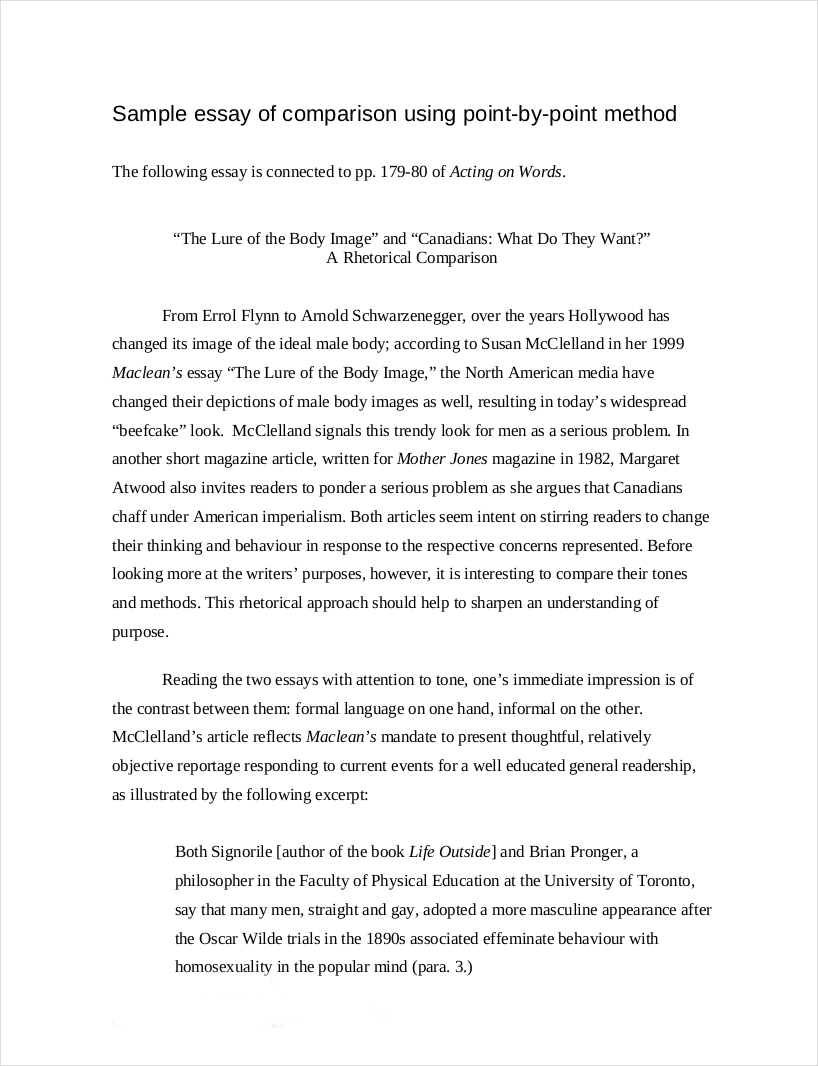
Size: 19 KB
Sample Comparative Essay in PDF

Size: 539 KB
Writing Guide in Creating the Actual Comparative Essay
Just like descriptive essay examples and other kinds of academic essays, a comparative essay can be created in different ways. Each writer has various techniques that can be applied when doing this particular kind of essay. Since there are no strict rules when it comes to crafting a comparative essay, all you need to ensure is that your comparative essay is comprehensive, understandable and credible. Here is how you can effectively write your actual comparative essay:
- Create an introduction to the topic. Your thesis statement should contain the subjects that you will talk about. You also need to create an initial discussion of what your readers can expect to the reader within the content of your comparative essay. A strong validation of your comparison can make your readers more interested to browse through the entire essay document.
- Develop your next paragraphs for discussion. As mentioned above, work per paragraph. Arrange your topics of discussion in a way that each paragraph can specifically state one comparison topic per time. You have to create an interesting discussion so you need to ensure that all your paragraphs are organized and well-written.
- Finalize your comparative essay with a conclusion. Your last paragraph should contain the information about your final thoughts with regards the comparison. How different or similar are the two subjects from one another? How sure are you that your basis is factual and relevant? Create a great impact b
- y having a conclusion that can put together all your points of discussion.
Compare Contrast Essay Sample
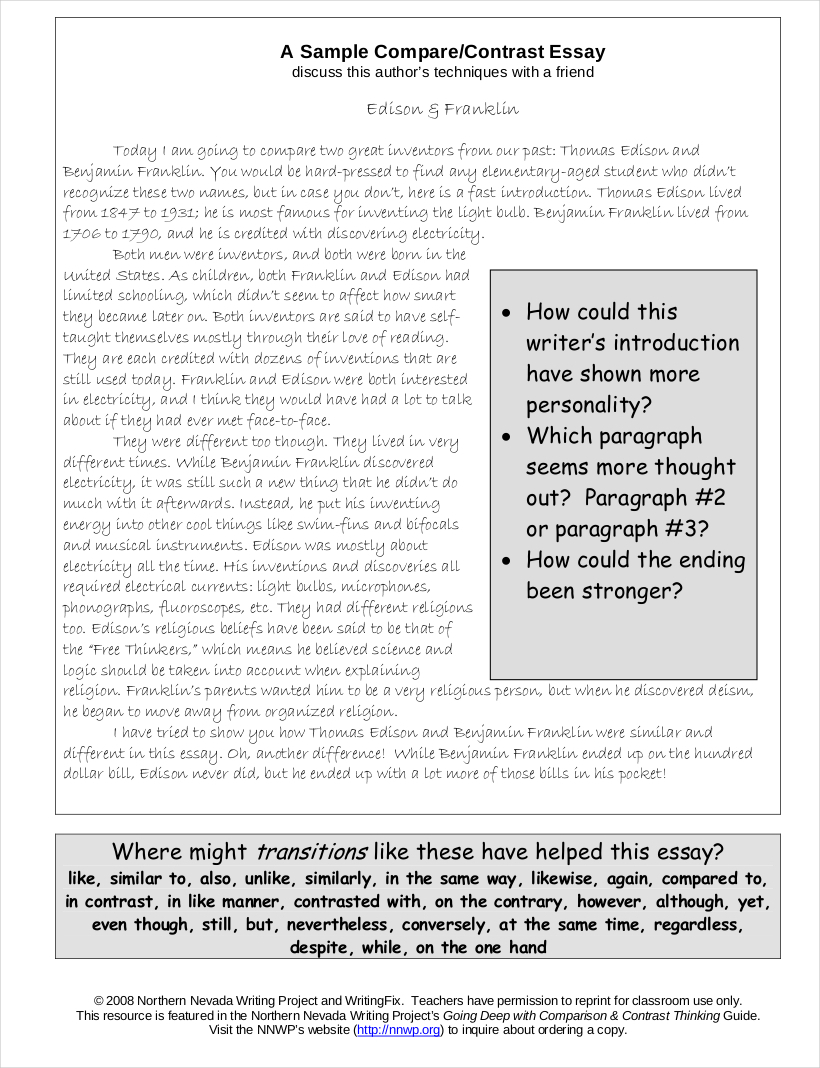
Size: 86 KB
Sample Comparative Essay Guide
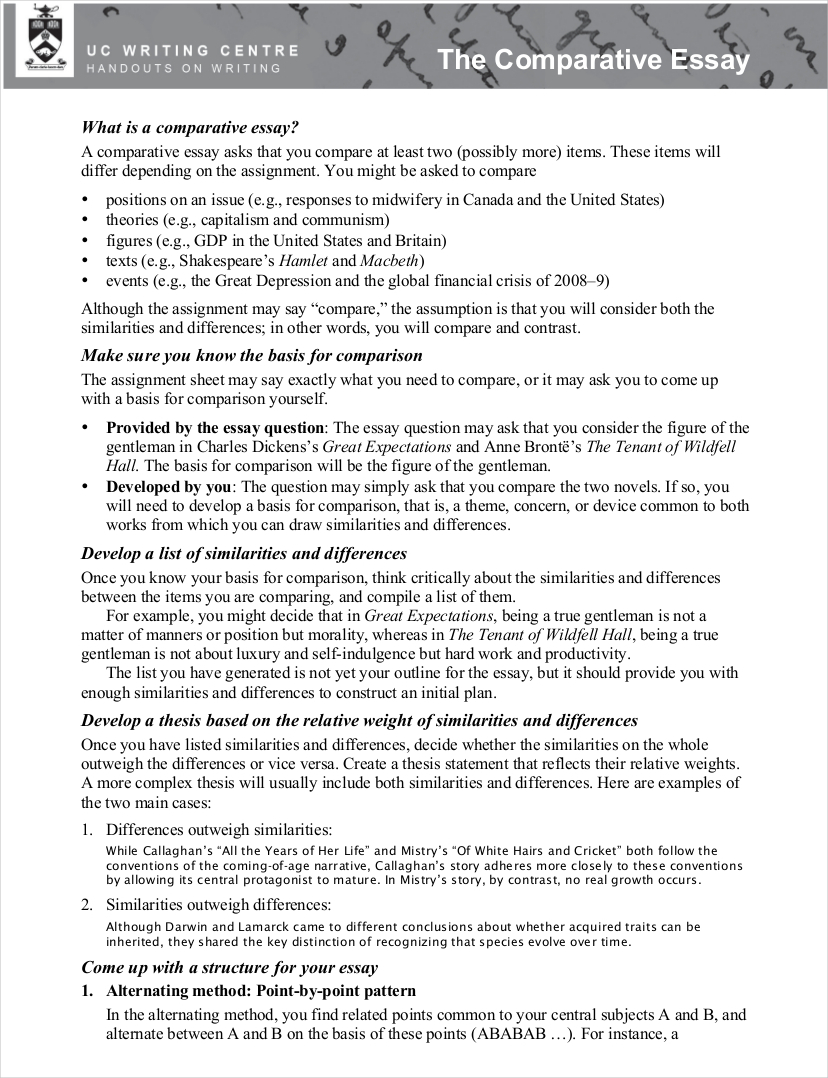
Size: 334 KB
Factors to Consider When Writing a Comparative Essay
In comparison to evaluation essay examples , a comparative essay is more keen with regards the assessment of two subjects. If you will write a comparative essay, you need to have an idea of the impacts of different factors to the result that you may get at the end of the writing activity. Listed below are some of the elements or factors that you need to take into consideration when writing a comparative essay.
- Your discussion’s organization. Within the entirety of the comparative essay creation, it is very evident that organization is key to success. As a writer, you need to ensure that you have a skeletal plan that can create your discussion more polished and coherent. The discussion of your organization can greatly affect the impression of your readers with regards your knowledge about your topic as well as your level of understanding with what you are talking about.
- Your thesis statement. When creating a comparative essay, you need to stick with an argument that can provide you the framework for the effective dissemination of information. Your thesis statement should be based on the results of your frame of references. You need to analyze your subjects properly so that you can create a stand on how you perceive them in levels of similarities and/or differences.
- Your claims or grounds for comparison. You should always be aware of your selection processes. At the end of the writing activity, you need to validate the importance of comparing two subjects. Always have your grounds of comparison ready so you can ensure your readers that you have followed a particular set of criteria that can enable the objectivity between the selection of two items for comparison. The rationale that you have behind your subject selection can make your comparative essay more appealing.
- Your reference frame. A comparative essay’s frame of reference deals with the way that the writer has created the groupings for the comparison. May it be talking about the similarities, differences, or both of these factors; a comparative essay should be able to have a reference that can identify how the characteristics of ideas, themes, theories or even problems are arranged.
With the samples that we have in this post, it will be faster for you to identify the points of discussion that you need to provide. Again, comparative essays vary from one another in terms of content. Ensure that you are fully aware of the writing instructions given to you so you can plan your comparative essay’s content and structure accordingly.
What Does a Comparative Essay Do?
- Analyzes Similarities and Differences: It systematically explores and discusses the similarities and differences between two or more subjects. These subjects could be texts, theories, historical periods, artistic works, scientific processes, etc.
- Develops Critical Thinking: By comparing different subjects, the essay encourages deep analytical thinking, requiring the writer to evaluate, synthesize, and articulate complex ideas clearly.
- Supports an Argument: The comparative analysis often supports a specific argument or thesis statement. The essay uses the comparative points as evidence to back up claims or to illustrate a particular viewpoint.
- Enhances Understanding: By highlighting contrasts and parallels, a comparative essay enhances understanding of the subjects. It allows readers to see familiar material in a new light and gain insights into the nature and implications of the subjects being compared.
- Engages Readers: Through its analytical depth and the intrigue of discovering connections and distinctions, a comparative essay engages and maintains reader interest.
- Teaches Organizational Skills: Writing a comparative essay requires organizing thoughts and findings in a coherent and logical structure, improving the writer’s overall organizational skills.
Always refer to the guidelines and tips that we have specified so you can create effective decisions in every step of your comparative essay development. Do not be afraid to write what your thoughts. As long as these thoughts are based on factual references, then it will be easy for you to have a comparative essay that can achieve its purpose or reason for creation.
the art of writing a comparative essay lies in the delicate balance of presenting similarities and differences in a clear, coherent manner. This type of essay encourages critical thinking and develops analytical skills, crucial for academic success. For further guidance on creating effective comparative essays, the UNC Writing Center offers a detailed resource on comparing and contrasting ( UNC Writing Center ). This link provides valuable insights and examples, helping students refine their comparative writing skills. By mastering the comparative essay, students not only enhance their writing abilities but also deepen their understanding of contrasting subjects, an essential skill in many academic and professional fields.
Text prompt
- Instructive
- Professional
Write a comparative essay on cats vs. dogs as pets: which are better and why?
Compare in a comparative essay the effects of online learning vs. traditional classroom learning on students.
Essay Papers Writing Online
A complete guide to writing a comparison essay – tips, strategies, and examples.
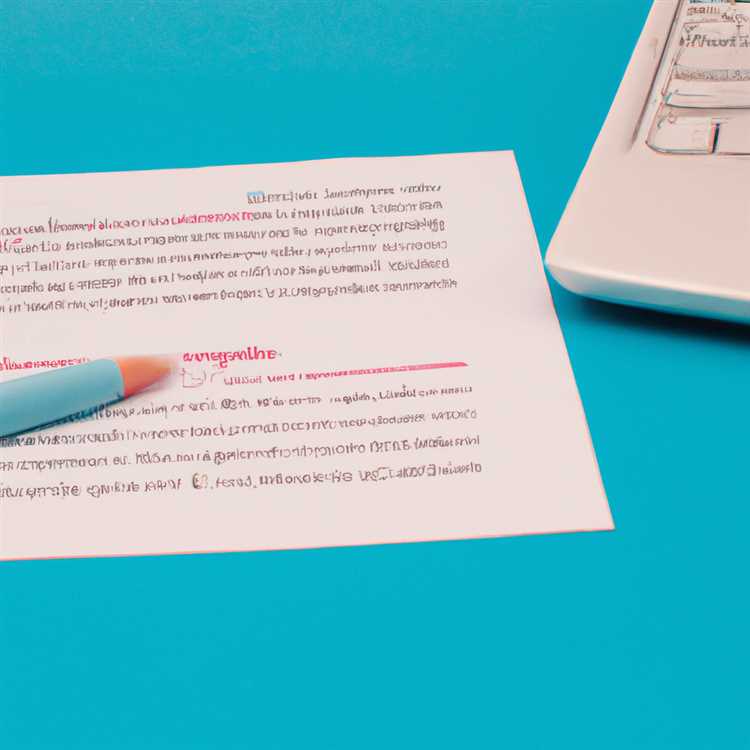
When it comes to analyzing and exploring different ideas, a comparison essay is an invaluable tool in any writer’s arsenal. A well-crafted comparison essay allows you to highlight the similarities and differences between two or more subjects, giving you the opportunity to delve into their intricacies and uncover new perspectives. Whether you are an aspiring writer or a seasoned one looking to refine your skills, learning how to effectively write a comparison essay is an essential skill.
Comparisons enable us to understand the world around us on a deeper level. They provide us with the ability to envision the connections between seemingly disparate entities, to draw parallels between opposing viewpoints, and to unveil the nuanced aspects that make each subject unique. Crafting a compelling comparison essay requires finesse, as it involves not only presenting the similarities and differences but also offering a coherent and insightful analysis that expands the reader’s understanding.
Throughout history, renowned writers and thinkers have employed the art of comparison to captivate audiences and convey complex ideas. From the works of Shakespeare to the philosophical teachings of Socrates, these masterpieces of comparison have stood the test of time, offering us timeless wisdom and inspiration. By studying and analyzing these literary gems, you can gain a deeper appreciation for the power of comparison and harness it within your own writing, making your words resonate with readers and leave a lasting impact.
Understanding the Purpose and Structure of a Comparison Essay
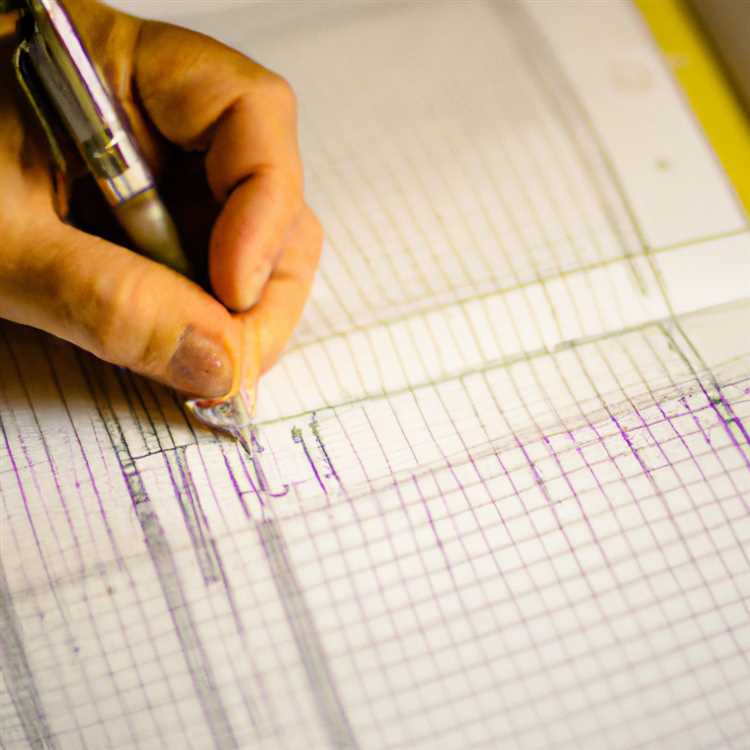
When composing a comparison essay, it is crucial to grasp its underlying purpose and follow a well-defined structure. Comparison essays, also known as comparative essays, require the writer to analyze and discuss the similarities and differences between two or more subjects. These essays serve to showcase the writer’s ability to critically examine the given topics, provide thoughtful analysis, and draw meaningful conclusions.
The purpose of a comparison essay is to highlight the similarities and differences between the subjects being compared. This type of essay allows the writer to explore various aspects of the subjects and provide insights into their similarities and disparities. It provides an opportunity to delve into the characteristics, qualities, and features of the subjects in a structured manner.
Regarding the structure, a comparison essay typically follows a systematic approach. It consists of an introduction, body paragraphs, and a conclusion. The introduction sets the tone for the essay and provides a brief overview of the subjects being compared. It also includes a thesis statement that presents the main argument or point of comparison.
The body paragraphs form the core of the essay and present the detailed analysis of the subjects. Each paragraph focuses on one aspect or characteristic, comparing and contrasting it between the subjects. Clear topic sentences help to guide the reader through the comparison process, while supporting evidence and examples provide credibility to the writer’s analysis.
Finally, the conclusion summarizes the main points discussed in the body paragraphs and restates the thesis statement. It offers the writer an opportunity to leave the reader with a compelling closing thought or emphasize the significance of the comparison. It should not introduce any new information but rather provide a concise summary of the essay’s main ideas.
Understanding the purpose and structure of a comparison essay is essential for producing a well-organized and compelling piece of writing. It allows the writer to present a thoughtful comparison of the subjects and effectively convey their insights and conclusions to the reader.
| Key Points |
|---|
| Comparison essays analyze the similarities and differences between subjects. |
| The purpose is to explore various aspects of the subjects and provide meaningful insights. |
| The structure consists of an introduction, body paragraphs, and a conclusion. |
| The introduction presents an overview and a thesis statement. |
| The body paragraphs provide detailed analysis and evidence. |
| The conclusion summarizes the main points and restates the thesis statement. |
Choosing the Right Topics for Comparison
One of the crucial steps in writing a comparison essay is selecting suitable topics for comparison. This stage requires careful consideration and evaluation of potential subjects to ensure a meaningful and engaging analysis. By choosing the right topics, you can effectively highlight similarities and differences, providing your readers with valuable insights.
When selecting topics for comparison, it is essential to opt for subjects that share some similarities, yet possess distinctive features that can be explored in depth. This contrast will enable you to showcase the nuances and complexities of the subjects being compared, leading to a more comprehensive and thought-provoking essay.
- Choose two subjects that are related or have a connection in some way, whether it is through their characteristics, themes, or historical context.
- Consider selecting topics that you have a personal interest in or are knowledgeable about. This will make the writing process more enjoyable and allow you to provide unique insights.
- Ensure that the topics selected are relevant and meaningful to your intended audience. By addressing subjects that resonate with your readers, you can create a stronger impact and generate interest.
- Look for topics that offer sufficient material for comparison. It is essential to have enough similarities and differences between the subjects to provide a comprehensive analysis.
By following these guidelines and taking the time to carefully select your topics, you can create a strong foundation for your comparison essay. Remember to consider the interests and preferences of your audience, while also focusing on subjects that allow for a thorough exploration of similarities and differences. With the right selection, you can deliver a compelling and impactful analysis that resonates with your readers.
Gathering and Organizing Relevant Information
To create a well-rounded comparison essay, it is crucial to gather and organize relevant information effectively. This step involves collecting the necessary data and materials that will aid in the comparison process.
Begin by identifying the key elements or subjects of comparison. These could be two similar products, concepts, theories, or any other items that you want to compare. Make a list or create a mind map to help visualize the connections between these subjects.
Next, conduct thorough research on each subject. Look for reliable and credible sources such as books, scholarly articles, reputable websites, and academic journals. Take note of any relevant quotes, statistics, examples, or arguments that can be used to support your points in the essay.
Once you have gathered the necessary information, it is important to organize it in a structured manner. This can be done by creating an outline or a table that compares the different aspects of each subject. Consider using headings and subheadings to categorize the information and make it easier to follow.
When organizing the information, keep in mind the main purpose of your comparison essay. Are you trying to highlight similarities, differences, or both? Use this objective as a guide when arranging the gathered information. For example, if you are focusing on similarities, you may want to group similar aspects of each subject together for easy comparison.
Additionally, it is essential to properly cite and reference the sources you used during your research. This not only gives credit to the original authors but also adds credibility to your essay. Use a consistent citation style, such as APA or MLA, and include in-text citations as well as a bibliography or works cited page at the end of your essay.
Gathering and organizing relevant information sets a strong foundation for a comparison essay. By following these steps, you will be able to present a well-structured and well-informed analysis of the subjects under comparison.
Developing a Strong Thesis Statement

Formulating a compelling thesis statement is essential when writing a comparative essay. It serves as the roadmap for the entire piece, allowing the reader to understand the main argument or point being made. The thesis statement should concisely summarize the main ideas that will be explored in the essay, while also highlighting the similarities and differences between the subjects being compared.
One effective way to develop a strong thesis statement is to first analyze the similarities and differences between the two subjects. By identifying the key aspects that will be discussed, it becomes easier to craft a thesis statement that accurately represents the main focus of the essay.
Another approach is to consider the overall purpose of the essay. Are you trying to persuade the reader to favor one subject over the other? Or are you simply presenting an objective analysis of the similarities and differences? Clarifying the purpose of the comparison essay can help guide the development of a strong thesis statement that aligns with the intended message.
In addition, it is important to consider the scope of the essay. Are you comparing just one aspect of the subjects or their overall characteristics? The depth of the analysis will impact the specificity of the thesis statement. For a more focused comparison, the thesis statement can be more specific, while a broader analysis may require a more general thesis statement.
Lastly, it is crucial to ensure that the thesis statement is clear and concise. Avoid vague or ambiguous language, and instead, use precise wording to clearly communicate the main argument of the essay. The thesis statement should provide a clear direction for the reader, guiding them through the comparative analysis that will follow.
| – The thesis statement is a roadmap for the essay. |
| – Analyze the similarities and differences between the two subjects. |
| – Consider the purpose and scope of the essay. |
| – Use clear and concise language for the thesis statement. |
Related Post
How to master the art of writing expository essays and captivate your audience, step-by-step guide to crafting a powerful literary analysis essay, convenient and reliable source to purchase college essays online, unlock success with a comprehensive business research paper example guide, unlock your writing potential with writers college – transform your passion into profession, “unlocking the secrets of academic success – navigating the world of research papers in college”, master the art of sociological expression – elevate your writing skills in sociology.
- PRO Courses Guides New Tech Help Pro Expert Videos About wikiHow Pro Upgrade Sign In
- EDIT Edit this Article
- EXPLORE Tech Help Pro About Us Random Article Quizzes Request a New Article Community Dashboard This Or That Game Happiness Hub Popular Categories Arts and Entertainment Artwork Books Movies Computers and Electronics Computers Phone Skills Technology Hacks Health Men's Health Mental Health Women's Health Relationships Dating Love Relationship Issues Hobbies and Crafts Crafts Drawing Games Education & Communication Communication Skills Personal Development Studying Personal Care and Style Fashion Hair Care Personal Hygiene Youth Personal Care School Stuff Dating All Categories Arts and Entertainment Finance and Business Home and Garden Relationship Quizzes Cars & Other Vehicles Food and Entertaining Personal Care and Style Sports and Fitness Computers and Electronics Health Pets and Animals Travel Education & Communication Hobbies and Crafts Philosophy and Religion Work World Family Life Holidays and Traditions Relationships Youth
- Browse Articles
- Learn Something New
- Quizzes Hot
- Happiness Hub
- This Or That Game
- Train Your Brain
- Explore More
- Support wikiHow
- About wikiHow
- Log in / Sign up
- Education and Communications
- College University and Postgraduate
- Academic Writing
How to Write a Comparative Essay
Last Updated: July 17, 2024 Fact Checked
This article was co-authored by Christopher Taylor, PhD . Christopher Taylor is an Adjunct Assistant Professor of English at Austin Community College in Texas. He received his PhD in English Literature and Medieval Studies from the University of Texas at Austin in 2014. There are 7 references cited in this article, which can be found at the bottom of the page. This article has been fact-checked, ensuring the accuracy of any cited facts and confirming the authority of its sources. This article has been viewed 1,689,433 times.
Perhaps you have been assigned a comparative essay in class, or need to write a comprehensive comparative report for work. In order to write a stellar comparative essay, you have to start off by picking two subjects that have enough similarities and differences to be compared in a meaningful way, such as two sports teams or two systems of government. Once you have that, then you have to find at least two or three points of comparison and use research, facts, and well-organized paragraphs to impress and captivate your readers. Writing the comparative essay is an important skill that you will use many times throughout your scholastic career.
Comparative Essay Outline and Example

How to Develop the Essay Content

- Many comparative essay assignments will signal their purpose by using words such as "compare," "contrast," "similarities," and "differences" in the language of the prompt.
- Also see whether there are any limits placed on your topic.

- The assignment will generally ask guiding questions if you are expected to incorporate comparison as part of a larger assignment. For example: "Choose a particular idea or theme, such as love, beauty, death, or time, and consider how two different Renaissance poets approach this idea." This sentence asks you to compare two poets, but it also asks how the poets approach the point of comparison. In other words, you will need to make an evaluative or analytical argument about those approaches.
- If you're unclear on what the essay prompt is asking you to do, talk with your instructor. It's much better to clarify questions up front than discover you've written the entire essay incorrectly.

- The best place to start is to write a list of things that the items you are comparing have in common as well as differences between them. [3] X Research source

- You may want to develop a system such as highlighting different types of similarities in different colors, or use different colours if you are using an electronic device.
- For example, if you are comparing two novels, you may want to highlight similarities in characters in pink, settings in blue, and themes or messages in green.

- The basis for your comparison may be assigned to you. Be sure to check your assignment or prompt.
- A basis for comparison may have to do with a theme, characteristics, or details about two different things. [6] X Research source
- A basis for comparison may also be known as the “grounds” for comparison or a frame of reference.
- Keep in mind that comparing 2 things that are too similar makes it hard to write an effective paper. The goal of a comparison paper is to draw interesting parallels and help the reader realize something interesting about our world. This means your subjects must be different enough to make your argument interesting.

- Research may not be required or appropriate for your particular assignment. If your comparative essay is not meant to include research, you should avoid including it.
- A comparative essay about historical events, social issues, or science-related topics are more likely to require research, while a comparison of two works of literature are less likely to require research.
- Be sure to cite any research data properly according to the discipline in which you are writing (eg, MLA, APA, or Chicago format).

- Your thesis needs to make a claim about your subjects that you will then defend in your essay. It's good for this claim to be a bit controversial or up for interpretation, as this allows you to build a good argument.
How to Organize the Content

- Use a traditional outline form if you would like to, but even a simple list of bulleted points in the order that you plan to present them would help.
- You can also write down your main points on sticky notes (or type them, print them, and then cut them out) so that you can arrange and rearrange them before deciding on a final order.

- The advantages of this structure are that it continually keeps the comparison in the mind of the reader and forces you, the writer, to pay equal attention to each side of the argument.
- This method is especially recommended for lengthy essays or complicated subjects where both the writer and reader can easily become lost. For Example: Paragraph 1: Engine power of vehicle X / Engine power of vehicle Y Paragraph 2: Stylishness of vehicle X / Stylishness of vehicle Y Paragraph 3: Safety rating of vehicle X / Safety rating of vehicle Y

- The advantages of this structure are that it allows you to discuss points in greater detail and makes it less jarring to tackle two topics that radically different.
- This method is especially recommended for essays where some depth and detail are required. For example: Paragraph 1: Engine power of vehicle X Paragraph 2: Engine power of vehicle Y Paragraph 3: Stylishness of vehicle X Paragraph 4: Stylishness of vehicle Y Paragraph 5: Safety rating of vehicle X Paragraph 6: Safety rating of vehicle Y

- This method is by far the most dangerous, as your comparison can become both one-sided and difficult for the reader to follow.
- This method is only recommended for short essays with simplistic subjects that the reader can easily remember as (s)he goes along. For example: Paragraph 1: Engine power of vehicle X Paragraph 2: Stylishness of vehicle X Paragraph 3: Safety rating of vehicle X Paragraph 4: Engine power of vehicle Y Paragraph 5: Stylishness of vehicle Y Paragraph 6: Safety rating of vehicle Y
How to Write the Essay

- Body paragraphs first . Work through all that information you've been compiling and see what kind of story it tells you. Only when you've worked with your data will you know what the larger point of the paper is.
- Conclusion second . Now that you've done all the heavy lifting, the point of your essay should be fresh in your mind. Strike while the iron’s hot. Start your conclusion with a restatement of your thesis.
- Intro last . Open your introduction with a "hook" to grab the reader's attention. Since you've already written your essay, choose a hook that reflects what you will talk about, whether it's a quote, statistic, factoid, rhetorical question, or anecdote. Then, write 1-2 sentences about your topic, narrowing down to your thesis statement, which completes your introduction.

- Organize your paragraphs using one of the approaches listed in the "Organizing the Content" part below. Once you have defined your points of comparison, choose the structure for the body paragraphs (where your comparisons go) that makes the most sense for your data. To work out all the organizational kinks, it’s recommended that you write an outline as a placeholder.
- Be very careful not to address different aspects of each subject. Comparing the color of one thing to the size of another does nothing to help the reader understand how they stack up.

- Be aware that your various comparisons won’t necessarily lend themselves to an obvious conclusion, especially because people value things differently. If necessary, make the parameters of your argument more specific. (Ex. “Though X is more stylish and powerful, Y’s top safety ratings make it a more appropriate family vehicle .”)
- When you have two radically different topics, it sometimes helps to point out one similarity they have before concluding. (i.e. "Although X and Y don't seem to have anything in common, in actuality, they both ....”)

- Even the best writers know editing is important to produce a good piece. Your essay will not be your best effort unless you revise it.
- If possible, find a friend to look over the essay, as he or she may find problems that you missed.
- It sometimes helps to increase or decrease the font size while editing to change the visual layout of the paper. Looking at the same thing for too long makes your brain fill in what it expects instead of what it sees, leaving you more likely to overlook errors.
Expert Q&A

- The title and introduction really catch the reader's attention and make them read the essay. Make sure you know how to write a catchy essay title . Thanks Helpful 6 Not Helpful 1
- Quotes should be used sparingly and must thoroughly complement the point they are being used to exemplify/justify. Thanks Helpful 5 Not Helpful 2
- The key principle to remember in a comparative paragraph or essay is that you must clarify precisely what you are comparing and keep that comparison alive throughout the essay. Thanks Helpful 3 Not Helpful 2

- Avoid vague language such as "people," "stuff," "things," etc. Thanks Helpful 4 Not Helpful 0
- Avoid, at all costs, the conclusion that the two subjects are "similar, yet different." This commonly found conclusion weakens any comparative essay, because it essentially says nothing about the comparison. Most things are "similar, yet different" in some way. Thanks Helpful 4 Not Helpful 0
- Some believe that an "unbalanced" comparison - that is, when the essay focuses predominantly on one of the two issues, and gives less importance to the other - is weaker, and that writers should strive for 50/50 treatment of the texts or issues being examined. Others, however, value emphasis in the essay that reflects the particular demands of the essay's purpose or thesis. One text may simply provide context, or historical/artistic/political reference for the main text, and therefore need not occupy half of the essay's discussion or analysis. A "weak" essay in this context would strive to treat unequal texts equally, rather than strive to appropriately apportion space to the relevant text. Thanks Helpful 3 Not Helpful 0
- Beware of the "Frying Pan Conclusion" in which you simply recount everything that was said in the main body of the essay. While your conclusion should include a simple summary of your argument, it should also emphatically state the point in a new and convincing way, one which the reader will remember clearly. If you can see a way forward from a problem or dilemma, include that as well. Thanks Helpful 2 Not Helpful 1
You Might Also Like

- ↑ http://writingcenter.unc.edu/handouts/comparing-and-contrasting/
- ↑ http://www.writing.utoronto.ca/advice/specific-types-of-writing/comparative-essay
- ↑ https://writingcenter.unc.edu/tips-and-tools/comparing-and-contrasting/
- ↑ https://www.butte.edu/departments/cas/tipsheets/style_purpose_strategy/compare_contrast.html
- ↑ https://open.lib.umn.edu/writingforsuccess/chapter/10-7-comparison-and-contrast/
- ↑ https://owl.purdue.edu/owl/general_writing/the_writing_process/proofreading/steps_for_revising.html
- How to Structure Paragraphs in an Essay
About This Article

To write a comparative essay, start by writing an introduction that introduces the 2 subjects you'll be comparing. You should also include your thesis statement in the introduction, which should state what you've concluded based on your comparisons. Next, write the body of your essay so that each paragraph focuses on one point of comparison between your subjects. Finally, write a conclusion that summarizes your main points and draws a larger conclusion about the two things you compared. To learn how to do research for your essay, read on! Did this summary help you? Yes No
- Send fan mail to authors
Reader Success Stories
Nov 21, 2017
Did this article help you?

Lisa Taylor
Aug 19, 2017
Brayden Ryan
Aug 10, 2016
Antwanette Nottage
Feb 5, 2019
Bernice Sangmortey
Nov 5, 2017

Featured Articles

Trending Articles

Watch Articles

- Terms of Use
- Privacy Policy
- Do Not Sell or Share My Info
- Not Selling Info
wikiHow Tech Help Pro:
Develop the tech skills you need for work and life
We’re reviewing our resources this fall (September-December 2024). We will do our best to minimize disruption, but you might notice changes over the next few months as we correct errors & delete redundant resources.
Comparative Essays
Writing a comparison usually requires that you assess the similarities and differences between two or more theories, procedures, or processes. You explain to your reader what insights can be gained from the comparison, or judge whether one thing is better than another according to established criteria.
How to Write a Comparative Essay
1. Establish a basis of comparison
A basis of comparison represents the main idea, category, or theme you will investigate. You will have to do some preliminary reading, likely using your course materials, to get an idea of what kind of criteria you will use to assess whatever you are comparing. A basis of comparison must apply to all items you are comparing, but the details will be different.
For example, if you are asked to “compare neoclassical architecture and gothic architecture,” you could compare the influence of social context on the two styles.
2. Gather the details of whatever you are comparing
Once you have decided what theme or idea you are investigating, you will need to gather details of whatever you are comparing, especially in terms of similarities and differences. Doing so allows you to see which criteria you should use in your comparison, if not specified by your professor or instructor.
- Appeal to Greek perfection
- Formulaic and mathematical
- Appeal to emotion
- Towers and spires
- Wild and rustic
- Civic buildings
Based on this information, you could focus on how ornamentation and design principles reveal prevailing intellectual thought about architecture in the respective eras and societies.
3. Develop a thesis statement
After brainstorming, try to develop a thesis statement that identifies the results of your comparison. Here is an example of a fairly common thesis statement structure:
e.g., Although neoclassical architecture and gothic architecture have [similar characteristics A and B], they reveal profound differences in their interpretation of [C, D, and E].
4. Organize your comparison
You have a choice of two basic methods for organizing a comparative essay: the point-by-point method or the block method.
The point-by-point method examines one aspect of comparison in each paragraph and usually alternates back and forth between the two objects, texts, or ideas being compared. This method allows you to emphasize points of similarity and of difference as you proceed.
In the block method, however, you say everything you need to say about one thing, then do the same thing with the other. This method works best if you want readers to understand and agree with the advantages of something you are proposing, such as introducing a new process or theory by showing how it compares to something more traditional.
Sample Outlines for Comparative Essays on Neoclassical and Gothic Architecture
Building a point-by-point essay.
Using the point-by-point method in a comparative essay allows you to draw direct comparisons and produce a more tightly integrated essay.
1. Introduction
- Introductory material
- Thesis: Although neoclassical and gothic architecture are both western European forms that are exemplified in civic buildings and churches, they nonetheless reveal through different structural design and ornamentation, the different intellectual principles of the two societies that created them.
2. Body Sections/Paragraphs
- Ornamentation in Text 1
- Ornamentation in Text 2
- Major appeal in Text 1
- Major appeal in Text 2
- Style in Text 1
- Style in Text 2
3. Conclusion
- Why this comparison is important?
- What does this comparison tell readers?
Building a Block Method Essay
Using the block method in a comparative essay can help ensure that the ideas in the second block build upon or extend ideas presented in the first block. It works well if you have three or more major areas of comparison instead of two (for example, if you added in a third or fourth style of architecture, the block method would be easier to organize).
- Thesis: The neoclassical style of architecture was a conscious rejection of the gothic style that had dominated in France at the end of the middle ages; it represented a desire to return to the classical ideals of Greece and Rome.
- History and development
- Change from earlier form
- Social context of new form
- What does the comparison reveal about architectural development?
- Why is this comparison important?

Comparing and Contrasting
What this handout is about.
This handout will help you first to determine whether a particular assignment is asking for comparison/contrast and then to generate a list of similarities and differences, decide which similarities and differences to focus on, and organize your paper so that it will be clear and effective. It will also explain how you can (and why you should) develop a thesis that goes beyond “Thing A and Thing B are similar in many ways but different in others.”
Introduction
In your career as a student, you’ll encounter many different kinds of writing assignments, each with its own requirements. One of the most common is the comparison/contrast essay, in which you focus on the ways in which certain things or ideas—usually two of them—are similar to (this is the comparison) and/or different from (this is the contrast) one another. By assigning such essays, your instructors are encouraging you to make connections between texts or ideas, engage in critical thinking, and go beyond mere description or summary to generate interesting analysis: when you reflect on similarities and differences, you gain a deeper understanding of the items you are comparing, their relationship to each other, and what is most important about them.
Recognizing comparison/contrast in assignments
Some assignments use words—like compare, contrast, similarities, and differences—that make it easy for you to see that they are asking you to compare and/or contrast. Here are a few hypothetical examples:
- Compare and contrast Frye’s and Bartky’s accounts of oppression.
- Compare WWI to WWII, identifying similarities in the causes, development, and outcomes of the wars.
- Contrast Wordsworth and Coleridge; what are the major differences in their poetry?
Notice that some topics ask only for comparison, others only for contrast, and others for both.
But it’s not always so easy to tell whether an assignment is asking you to include comparison/contrast. And in some cases, comparison/contrast is only part of the essay—you begin by comparing and/or contrasting two or more things and then use what you’ve learned to construct an argument or evaluation. Consider these examples, noticing the language that is used to ask for the comparison/contrast and whether the comparison/contrast is only one part of a larger assignment:
- Choose a particular idea or theme, such as romantic love, death, or nature, and consider how it is treated in two Romantic poems.
- How do the different authors we have studied so far define and describe oppression?
- Compare Frye’s and Bartky’s accounts of oppression. What does each imply about women’s collusion in their own oppression? Which is more accurate?
- In the texts we’ve studied, soldiers who served in different wars offer differing accounts of their experiences and feelings both during and after the fighting. What commonalities are there in these accounts? What factors do you think are responsible for their differences?
You may want to check out our handout on understanding assignments for additional tips.
Using comparison/contrast for all kinds of writing projects
Sometimes you may want to use comparison/contrast techniques in your own pre-writing work to get ideas that you can later use for an argument, even if comparison/contrast isn’t an official requirement for the paper you’re writing. For example, if you wanted to argue that Frye’s account of oppression is better than both de Beauvoir’s and Bartky’s, comparing and contrasting the main arguments of those three authors might help you construct your evaluation—even though the topic may not have asked for comparison/contrast and the lists of similarities and differences you generate may not appear anywhere in the final draft of your paper.
Discovering similarities and differences
Making a Venn diagram or a chart can help you quickly and efficiently compare and contrast two or more things or ideas. To make a Venn diagram, simply draw some overlapping circles, one circle for each item you’re considering. In the central area where they overlap, list the traits the two items have in common. Assign each one of the areas that doesn’t overlap; in those areas, you can list the traits that make the things different. Here’s a very simple example, using two pizza places:
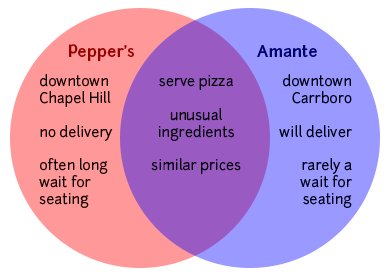
To make a chart, figure out what criteria you want to focus on in comparing the items. Along the left side of the page, list each of the criteria. Across the top, list the names of the items. You should then have a box per item for each criterion; you can fill the boxes in and then survey what you’ve discovered.
Here’s an example, this time using three pizza places:
| Pepper’s | Amante | Papa John’s | |
|---|---|---|---|
| Location | |||
| Price | |||
| Delivery | |||
| Ingredients | |||
| Service | |||
| Seating/eating in | |||
| Coupons |
As you generate points of comparison, consider the purpose and content of the assignment and the focus of the class. What do you think the professor wants you to learn by doing this comparison/contrast? How does it fit with what you have been studying so far and with the other assignments in the course? Are there any clues about what to focus on in the assignment itself?
Here are some general questions about different types of things you might have to compare. These are by no means complete or definitive lists; they’re just here to give you some ideas—you can generate your own questions for these and other types of comparison. You may want to begin by using the questions reporters traditionally ask: Who? What? Where? When? Why? How? If you’re talking about objects, you might also consider general properties like size, shape, color, sound, weight, taste, texture, smell, number, duration, and location.
Two historical periods or events
- When did they occur—do you know the date(s) and duration? What happened or changed during each? Why are they significant?
- What kinds of work did people do? What kinds of relationships did they have? What did they value?
- What kinds of governments were there? Who were important people involved?
- What caused events in these periods, and what consequences did they have later on?
Two ideas or theories
- What are they about?
- Did they originate at some particular time?
- Who created them? Who uses or defends them?
- What is the central focus, claim, or goal of each? What conclusions do they offer?
- How are they applied to situations/people/things/etc.?
- Which seems more plausible to you, and why? How broad is their scope?
- What kind of evidence is usually offered for them?
Two pieces of writing or art
- What are their titles? What do they describe or depict?
- What is their tone or mood? What is their form?
- Who created them? When were they created? Why do you think they were created as they were? What themes do they address?
- Do you think one is of higher quality or greater merit than the other(s)—and if so, why?
- For writing: what plot, characterization, setting, theme, tone, and type of narration are used?
- Where are they from? How old are they? What is the gender, race, class, etc. of each?
- What, if anything, are they known for? Do they have any relationship to each other?
- What are they like? What did/do they do? What do they believe? Why are they interesting?
- What stands out most about each of them?
Deciding what to focus on
By now you have probably generated a huge list of similarities and differences—congratulations! Next you must decide which of them are interesting, important, and relevant enough to be included in your paper. Ask yourself these questions:
- What’s relevant to the assignment?
- What’s relevant to the course?
- What’s interesting and informative?
- What matters to the argument you are going to make?
- What’s basic or central (and needs to be mentioned even if obvious)?
- Overall, what’s more important—the similarities or the differences?
Suppose that you are writing a paper comparing two novels. For most literature classes, the fact that they both use Caslon type (a kind of typeface, like the fonts you may use in your writing) is not going to be relevant, nor is the fact that one of them has a few illustrations and the other has none; literature classes are more likely to focus on subjects like characterization, plot, setting, the writer’s style and intentions, language, central themes, and so forth. However, if you were writing a paper for a class on typesetting or on how illustrations are used to enhance novels, the typeface and presence or absence of illustrations might be absolutely critical to include in your final paper.
Sometimes a particular point of comparison or contrast might be relevant but not terribly revealing or interesting. For example, if you are writing a paper about Wordsworth’s “Tintern Abbey” and Coleridge’s “Frost at Midnight,” pointing out that they both have nature as a central theme is relevant (comparisons of poetry often talk about themes) but not terribly interesting; your class has probably already had many discussions about the Romantic poets’ fondness for nature. Talking about the different ways nature is depicted or the different aspects of nature that are emphasized might be more interesting and show a more sophisticated understanding of the poems.
Your thesis
The thesis of your comparison/contrast paper is very important: it can help you create a focused argument and give your reader a road map so they don’t get lost in the sea of points you are about to make. As in any paper, you will want to replace vague reports of your general topic (for example, “This paper will compare and contrast two pizza places,” or “Pepper’s and Amante are similar in some ways and different in others,” or “Pepper’s and Amante are similar in many ways, but they have one major difference”) with something more detailed and specific. For example, you might say, “Pepper’s and Amante have similar prices and ingredients, but their atmospheres and willingness to deliver set them apart.”
Be careful, though—although this thesis is fairly specific and does propose a simple argument (that atmosphere and delivery make the two pizza places different), your instructor will often be looking for a bit more analysis. In this case, the obvious question is “So what? Why should anyone care that Pepper’s and Amante are different in this way?” One might also wonder why the writer chose those two particular pizza places to compare—why not Papa John’s, Dominos, or Pizza Hut? Again, thinking about the context the class provides may help you answer such questions and make a stronger argument. Here’s a revision of the thesis mentioned earlier:
Pepper’s and Amante both offer a greater variety of ingredients than other Chapel Hill/Carrboro pizza places (and than any of the national chains), but the funky, lively atmosphere at Pepper’s makes it a better place to give visiting friends and family a taste of local culture.
You may find our handout on constructing thesis statements useful at this stage.
Organizing your paper
There are many different ways to organize a comparison/contrast essay. Here are two:
Subject-by-subject
Begin by saying everything you have to say about the first subject you are discussing, then move on and make all the points you want to make about the second subject (and after that, the third, and so on, if you’re comparing/contrasting more than two things). If the paper is short, you might be able to fit all of your points about each item into a single paragraph, but it’s more likely that you’d have several paragraphs per item. Using our pizza place comparison/contrast as an example, after the introduction, you might have a paragraph about the ingredients available at Pepper’s, a paragraph about its location, and a paragraph about its ambience. Then you’d have three similar paragraphs about Amante, followed by your conclusion.
The danger of this subject-by-subject organization is that your paper will simply be a list of points: a certain number of points (in my example, three) about one subject, then a certain number of points about another. This is usually not what college instructors are looking for in a paper—generally they want you to compare or contrast two or more things very directly, rather than just listing the traits the things have and leaving it up to the reader to reflect on how those traits are similar or different and why those similarities or differences matter. Thus, if you use the subject-by-subject form, you will probably want to have a very strong, analytical thesis and at least one body paragraph that ties all of your different points together.
A subject-by-subject structure can be a logical choice if you are writing what is sometimes called a “lens” comparison, in which you use one subject or item (which isn’t really your main topic) to better understand another item (which is). For example, you might be asked to compare a poem you’ve already covered thoroughly in class with one you are reading on your own. It might make sense to give a brief summary of your main ideas about the first poem (this would be your first subject, the “lens”), and then spend most of your paper discussing how those points are similar to or different from your ideas about the second.
Point-by-point
Rather than addressing things one subject at a time, you may wish to talk about one point of comparison at a time. There are two main ways this might play out, depending on how much you have to say about each of the things you are comparing. If you have just a little, you might, in a single paragraph, discuss how a certain point of comparison/contrast relates to all the items you are discussing. For example, I might describe, in one paragraph, what the prices are like at both Pepper’s and Amante; in the next paragraph, I might compare the ingredients available; in a third, I might contrast the atmospheres of the two restaurants.
If I had a bit more to say about the items I was comparing/contrasting, I might devote a whole paragraph to how each point relates to each item. For example, I might have a whole paragraph about the clientele at Pepper’s, followed by a whole paragraph about the clientele at Amante; then I would move on and do two more paragraphs discussing my next point of comparison/contrast—like the ingredients available at each restaurant.
There are no hard and fast rules about organizing a comparison/contrast paper, of course. Just be sure that your reader can easily tell what’s going on! Be aware, too, of the placement of your different points. If you are writing a comparison/contrast in service of an argument, keep in mind that the last point you make is the one you are leaving your reader with. For example, if I am trying to argue that Amante is better than Pepper’s, I should end with a contrast that leaves Amante sounding good, rather than with a point of comparison that I have to admit makes Pepper’s look better. If you’ve decided that the differences between the items you’re comparing/contrasting are most important, you’ll want to end with the differences—and vice versa, if the similarities seem most important to you.
Our handout on organization can help you write good topic sentences and transitions and make sure that you have a good overall structure in place for your paper.
Cue words and other tips
To help your reader keep track of where you are in the comparison/contrast, you’ll want to be sure that your transitions and topic sentences are especially strong. Your thesis should already have given the reader an idea of the points you’ll be making and the organization you’ll be using, but you can help them out with some extra cues. The following words may be helpful to you in signaling your intentions:
- like, similar to, also, unlike, similarly, in the same way, likewise, again, compared to, in contrast, in like manner, contrasted with, on the contrary, however, although, yet, even though, still, but, nevertheless, conversely, at the same time, regardless, despite, while, on the one hand … on the other hand.
For example, you might have a topic sentence like one of these:
- Compared to Pepper’s, Amante is quiet.
- Like Amante, Pepper’s offers fresh garlic as a topping.
- Despite their different locations (downtown Chapel Hill and downtown Carrboro), Pepper’s and Amante are both fairly easy to get to.
You may reproduce it for non-commercial use if you use the entire handout and attribute the source: The Writing Center, University of North Carolina at Chapel Hill
Make a Gift
Instructor Resources
Comparative essay.
Compare two or more literary works that we have studied in this class. Your comparative essay should not only compare but also contrast the literary texts, addressing the similarities and differences found within the texts.
Step 1: Identify the Basis for Comparison
Identify the basis of comparison. In other words, what aspect of the literature will you compare? (Theme, tone, point of view, setting, language, etc.)
Step 2: Create a List of Similarities and Differences
Carefully examine the literary texts for similarities and difference using the criteria you identified in step 1.
Step 3: Write a Thesis Statement
A thesis statement is the author’s educated opinion that can be defended. For a comparative essay, your thesis statement should assert why the similarities and differences between the literary works matter.
Step 4: Create a Structure
Before drafting, create an outline. Your introduction should draw the reader in and provide the thesis statement. The supporting paragraphs should begin with a topic sentence that supports your thesis statement; each topic sentence should then be supported with textual evidence. The conclusion should summarize the essay and prompt the reader to continue thinking about the topic.
Word Count: approximately 1500 words
Outside Sources needed: none (but use plenty of textual evidence)
- Comparative Essay. License : CC0: No Rights Reserved
- Utility Menu
GA4 Tracking Code
Gen ed writes, writing across the disciplines at harvard college.
- Comparative Analysis
What It Is and Why It's Useful
Comparative analysis asks writers to make an argument about the relationship between two or more texts. Beyond that, there's a lot of variation, but three overarching kinds of comparative analysis stand out:
- Coordinate (A ↔ B): In this kind of analysis, two (or more) texts are being read against each other in terms of a shared element, e.g., a memoir and a novel, both by Jesmyn Ward; two sets of data for the same experiment; a few op-ed responses to the same event; two YA books written in Chicago in the 2000s; a film adaption of a play; etc.
- Subordinate (A → B) or (B → A ): Using a theoretical text (as a "lens") to explain a case study or work of art (e.g., how Anthony Jack's The Privileged Poor can help explain divergent experiences among students at elite four-year private colleges who are coming from similar socio-economic backgrounds) or using a work of art or case study (i.e., as a "test" of) a theory's usefulness or limitations (e.g., using coverage of recent incidents of gun violence or legislation un the U.S. to confirm or question the currency of Carol Anderson's The Second ).
- Hybrid [A → (B ↔ C)] or [(B ↔ C) → A] , i.e., using coordinate and subordinate analysis together. For example, using Jack to compare or contrast the experiences of students at elite four-year institutions with students at state universities and/or community colleges; or looking at gun culture in other countries and/or other timeframes to contextualize or generalize Anderson's main points about the role of the Second Amendment in U.S. history.
"In the wild," these three kinds of comparative analysis represent increasingly complex—and scholarly—modes of comparison. Students can of course compare two poems in terms of imagery or two data sets in terms of methods, but in each case the analysis will eventually be richer if the students have had a chance to encounter other people's ideas about how imagery or methods work. At that point, we're getting into a hybrid kind of reading (or even into research essays), especially if we start introducing different approaches to imagery or methods that are themselves being compared along with a couple (or few) poems or data sets.
Why It's Useful
In the context of a particular course, each kind of comparative analysis has its place and can be a useful step up from single-source analysis. Intellectually, comparative analysis helps overcome the "n of 1" problem that can face single-source analysis. That is, a writer drawing broad conclusions about the influence of the Iranian New Wave based on one film is relying entirely—and almost certainly too much—on that film to support those findings. In the context of even just one more film, though, the analysis is suddenly more likely to arrive at one of the best features of any comparative approach: both films will be more richly experienced than they would have been in isolation, and the themes or questions in terms of which they're being explored (here the general question of the influence of the Iranian New Wave) will arrive at conclusions that are less at-risk of oversimplification.
For scholars working in comparative fields or through comparative approaches, these features of comparative analysis animate their work. To borrow from a stock example in Western epistemology, our concept of "green" isn't based on a single encounter with something we intuit or are told is "green." Not at all. Our concept of "green" is derived from a complex set of experiences of what others say is green or what's labeled green or what seems to be something that's neither blue nor yellow but kind of both, etc. Comparative analysis essays offer us the chance to engage with that process—even if only enough to help us see where a more in-depth exploration with a higher and/or more diverse "n" might lead—and in that sense, from the standpoint of the subject matter students are exploring through writing as well the complexity of the genre of writing they're using to explore it—comparative analysis forms a bridge of sorts between single-source analysis and research essays.
Typical learning objectives for single-sources essays: formulate analytical questions and an arguable thesis, establish stakes of an argument, summarize sources accurately, choose evidence effectively, analyze evidence effectively, define key terms, organize argument logically, acknowledge and respond to counterargument, cite sources properly, and present ideas in clear prose.
Common types of comparative analysis essays and related types: two works in the same genre, two works from the same period (but in different places or in different cultures), a work adapted into a different genre or medium, two theories treating the same topic; a theory and a case study or other object, etc.
How to Teach It: Framing + Practice
Framing multi-source writing assignments (comparative analysis, research essays, multi-modal projects) is likely to overlap a great deal with "Why It's Useful" (see above), because the range of reasons why we might use these kinds of writing in academic or non-academic settings is itself the reason why they so often appear later in courses. In many courses, they're the best vehicles for exploring the complex questions that arise once we've been introduced to the course's main themes, core content, leading protagonists, and central debates.
For comparative analysis in particular, it's helpful to frame assignment's process and how it will help students successfully navigate the challenges and pitfalls presented by the genre. Ideally, this will mean students have time to identify what each text seems to be doing, take note of apparent points of connection between different texts, and start to imagine how those points of connection (or the absence thereof)
- complicates or upends their own expectations or assumptions about the texts
- complicates or refutes the expectations or assumptions about the texts presented by a scholar
- confirms and/or nuances expectations and assumptions they themselves hold or scholars have presented
- presents entirely unforeseen ways of understanding the texts
—and all with implications for the texts themselves or for the axes along which the comparative analysis took place. If students know that this is where their ideas will be heading, they'll be ready to develop those ideas and engage with the challenges that comparative analysis presents in terms of structure (See "Tips" and "Common Pitfalls" below for more on these elements of framing).
Like single-source analyses, comparative essays have several moving parts, and giving students practice here means adapting the sample sequence laid out at the " Formative Writing Assignments " page. Three areas that have already been mentioned above are worth noting:
- Gathering evidence : Depending on what your assignment is asking students to compare (or in terms of what), students will benefit greatly from structured opportunities to create inventories or data sets of the motifs, examples, trajectories, etc., shared (or not shared) by the texts they'll be comparing. See the sample exercises below for a basic example of what this might look like.
- Why it Matters: Moving beyond "x is like y but also different" or even "x is more like y than we might think at first" is what moves an essay from being "compare/contrast" to being a comparative analysis . It's also a move that can be hard to make and that will often evolve over the course of an assignment. A great way to get feedback from students about where they're at on this front? Ask them to start considering early on why their argument "matters" to different kinds of imagined audiences (while they're just gathering evidence) and again as they develop their thesis and again as they're drafting their essays. ( Cover letters , for example, are a great place to ask writers to imagine how a reader might be affected by reading an their argument.)
- Structure: Having two texts on stage at the same time can suddenly feel a lot more complicated for any writer who's used to having just one at a time. Giving students a sense of what the most common patterns (AAA / BBB, ABABAB, etc.) are likely to be can help them imagine, even if provisionally, how their argument might unfold over a series of pages. See "Tips" and "Common Pitfalls" below for more information on this front.
Sample Exercises and Links to Other Resources
- Common Pitfalls
- Advice on Timing
- Try to keep students from thinking of a proposed thesis as a commitment. Instead, help them see it as more of a hypothesis that has emerged out of readings and discussion and analytical questions and that they'll now test through an experiment, namely, writing their essay. When students see writing as part of the process of inquiry—rather than just the result—and when that process is committed to acknowledging and adapting itself to evidence, it makes writing assignments more scientific, more ethical, and more authentic.
- Have students create an inventory of touch points between the two texts early in the process.
- Ask students to make the case—early on and at points throughout the process—for the significance of the claim they're making about the relationship between the texts they're comparing.
- For coordinate kinds of comparative analysis, a common pitfall is tied to thesis and evidence. Basically, it's a thesis that tells the reader that there are "similarities and differences" between two texts, without telling the reader why it matters that these two texts have or don't have these particular features in common. This kind of thesis is stuck at the level of description or positivism, and it's not uncommon when a writer is grappling with the complexity that can in fact accompany the "taking inventory" stage of comparative analysis. The solution is to make the "taking inventory" stage part of the process of the assignment. When this stage comes before students have formulated a thesis, that formulation is then able to emerge out of a comparative data set, rather than the data set emerging in terms of their thesis (which can lead to confirmation bias, or frequency illusion, or—just for the sake of streamlining the process of gathering evidence—cherry picking).
- For subordinate kinds of comparative analysis , a common pitfall is tied to how much weight is given to each source. Having students apply a theory (in a "lens" essay) or weigh the pros and cons of a theory against case studies (in a "test a theory") essay can be a great way to help them explore the assumptions, implications, and real-world usefulness of theoretical approaches. The pitfall of these approaches is that they can quickly lead to the same biases we saw here above. Making sure that students know they should engage with counterevidence and counterargument, and that "lens" / "test a theory" approaches often balance each other out in any real-world application of theory is a good way to get out in front of this pitfall.
- For any kind of comparative analysis, a common pitfall is structure. Every comparative analysis asks writers to move back and forth between texts, and that can pose a number of challenges, including: what pattern the back and forth should follow and how to use transitions and other signposting to make sure readers can follow the overarching argument as the back and forth is taking place. Here's some advice from an experienced writing instructor to students about how to think about these considerations:
a quick note on STRUCTURE
Most of us have encountered the question of whether to adopt what we might term the “A→A→A→B→B→B” structure or the “A→B→A→B→A→B” structure. Do we make all of our points about text A before moving on to text B? Or do we go back and forth between A and B as the essay proceeds? As always, the answers to our questions about structure depend on our goals in the essay as a whole. In a “similarities in spite of differences” essay, for instance, readers will need to encounter the differences between A and B before we offer them the similarities (A d →B d →A s →B s ). If, rather than subordinating differences to similarities you are subordinating text A to text B (using A as a point of comparison that reveals B’s originality, say), you may be well served by the “A→A→A→B→B→B” structure.
Ultimately, you need to ask yourself how many “A→B” moves you have in you. Is each one identical? If so, you may wish to make the transition from A to B only once (“A→A→A→B→B→B”), because if each “A→B” move is identical, the “A→B→A→B→A→B” structure will appear to involve nothing more than directionless oscillation and repetition. If each is increasingly complex, however—if each AB pair yields a new and progressively more complex idea about your subject—you may be well served by the “A→B→A→B→A→B” structure, because in this case it will be visible to readers as a progressively developing argument.
As we discussed in "Advice on Timing" at the page on single-source analysis, that timeline itself roughly follows the "Sample Sequence of Formative Assignments for a 'Typical' Essay" outlined under " Formative Writing Assignments, " and it spans about 5–6 steps or 2–4 weeks.
Comparative analysis assignments have a lot of the same DNA as single-source essays, but they potentially bring more reading into play and ask students to engage in more complicated acts of analysis and synthesis during the drafting stages. With that in mind, closer to 4 weeks is probably a good baseline for many single-source analysis assignments. For sections that meet once per week, the timeline will either probably need to expand—ideally—a little past the 4-week side of things, or some of the steps will need to be combined or done asynchronously.
What It Can Build Up To
Comparative analyses can build up to other kinds of writing in a number of ways. For example:
- They can build toward other kinds of comparative analysis, e.g., student can be asked to choose an additional source to complicate their conclusions from a previous analysis, or they can be asked to revisit an analysis using a different axis of comparison, such as race instead of class. (These approaches are akin to moving from a coordinate or subordinate analysis to more of a hybrid approach.)
- They can scaffold up to research essays, which in many instances are an extension of a "hybrid comparative analysis."
- Like single-source analysis, in a course where students will take a "deep dive" into a source or topic for their capstone, they can allow students to "try on" a theoretical approach or genre or time period to see if it's indeed something they want to research more fully.
- DIY Guides for Analytical Writing Assignments

- Types of Assignments
- Unpacking the Elements of Writing Prompts
- Formative Writing Assignments
- Single-Source Analysis
- Research Essays
- Multi-Modal or Creative Projects
- Giving Feedback to Students
Assignment Decoder
- Resources ›
- For Educators ›
- Teaching Resources ›
101 Compare and Contrast Essay Topics
Great Ideas for Essays
- Teaching Resources
- An Introduction to Teaching
- Tips & Strategies
- Policies & Discipline
- Community Involvement
- School Administration
- Technology in the Classroom
- Teaching Adult Learners
- Issues In Education
- Becoming A Teacher
- Assessments & Tests
- Elementary Education
- Secondary Education
- Special Education
- Homeschooling
- M.Ed., Curriculum and Instruction, University of Florida
- B.A., History, University of Florida
Compare and contrast essays are taught in school for many reasons. For one thing, they are relatively easy to teach, understand, and format. Students can typically understand the structure with just a short amount of instruction. In addition, these essays allow students develop critical thinking skills to approach a variety of topics.
Brainstorming Tip
One fun way to get students started brainstorming their compare and contrast essays is to create a Venn diagram , where the overlapping sections of the circle contain similarities and the non-overlapping areas contain the differing traits.
The following is a list of 101 topics for compare and contrast essays that you are welcome to use in your classroom. As you look through the list, you will see that some items are academic in nature while others are included for interest-building and fun writing activities.
- Apple vs. Microsoft
- Coke vs. Pepsi
- Renaissance Art vs. Baroque Art
- Antebellum Era vs. Reconstruction Era in American History
- Childhood vs. Adulthood
- Star Wars vs. Star Trek
- Biology vs. Chemistry
- Astrology vs. Astronomy
- American Government vs. British Government (or any world government)
- Fruits vs. Vegetables
- Dogs vs. Cats
- Ego vs. Superego
- Christianity vs. Judaism (or any world religion )
- Republican vs. Democrat
- Monarchy vs. Presidency
- US President vs. UK Prime Minister
- Jazz vs. Classical Music
- Red vs. White (or any two colors)
- Soccer vs. Football
- North vs. South Before the Civil War
- New England Colonies vs. Middle Colonies OR vs. Southern Colonies
- Cash vs. Credit Cards
- Sam vs. Frodo Baggins
- Gandalf vs. Dumbledore
- Fred vs. Shaggy
- Rap vs. Pop
- Articles of Confederation vs. U.S. Constitution
- Henry VIII vs. King Louis XIV
- Stocks vs. Bonds
- Monopolies vs. Oligopolies
- Communism vs. Capitalism
- Socialism vs. Capitalism
- Diesel vs. Petroleum
- Nuclear Power vs. Solar Power
- Saltwater Fish vs. Freshwater Fish
- Squids vs. Octopus
- Mammals vs. Reptiles
- Baleen vs. Toothed Whales
- Seals vs. Sea Lions
- Crocodiles vs. Alligators
- Bats vs. Birds
- Oven vs. Microwave
- Greek vs. Roman Mythology
- Chinese vs. Japanese
- Comedy vs. Drama
- Renting vs. Owning
- Mozart vs. Beethoven
- Online vs. Traditional Education
- North vs. South Pole
- Watercolor vs. Oil
- 1984 vs. Fahrenheit 451
- Emily Dickinson vs. Samuel Taylor Coleridge
- W.E.B. DuBois vs. Booker T. Washington
- Strawberries vs. Apples
- Airplanes vs. Helicopters
- Hitler vs. Napoleon
- Roman Empire vs. British Empire
- Paper vs. Plastic
- Italy vs. Spain
- Baseball vs. Cricket
- Jefferson vs. Adams
- Thoroughbreds vs. Clydesdales
- Spiders vs. Scorpions
- Northern Hemisphere vs. Southern Hemisphere
- Hobbes vs. Locke
- Friends vs. Family
- Dried Fruit vs. Fresh
- Porcelain vs. Glass
- Modern Dance vs. Ballroom Dancing
- American Idol vs. The Voice
- Reality TV vs. Sitcoms
- Picard vs. Kirk
- Books vs. Movies
- Magazines vs. Comic Books
- Antique vs. New
- Public vs. Private Transportation
- Email vs. Letters
- Facebook vs. Twitter
- Coffee vs. an Energy Drink
- Toads vs. Frogs
- Profit vs. Non-Profit
- Boys vs. Girls
- Birds vs. Dinosaurs
- High School vs. College
- Chamberlain vs. Churchill
- Offense vs. Defense
- Jordan vs. Bryant
- Harry vs. Draco
- Roses vs. Carnations
- Poetry vs. Prose
- Fiction vs. Nonfiction
- Lions vs. Tigers
- Vampires vs. Werewolves
- Lollipops vs. popsicles
- Summer vs. Winter
- Recycling vs. Landfill
- Motorcycle vs. Bicycle
- Halogen vs. Incandescent
- Newton vs. Einstein
- .. Go on vacation vs. Staycation
- . Rock vs. Scissors
- Questions for Each Level of Bloom's Taxonomy
- 61 General Expository Essay Topic to Practice Academic Writing
- Use Popular Songs to Teach Similes
- Beef Up Critical Thinking and Writing Skills: Comparison Essays
- How to Teach the Compare and Contrast Essay
- 25 Essay Topics for American Government Classes
- Compare-Contrast Prewriting Chart
- Organizing Compare-Contrast Paragraphs
- How to Teach Topic Sentences Using Models
- Higher Level Thinking: Synthesis in Bloom's Taxonomy
- What to Include in a Student Portfolio
- Bloom's Taxonomy: Analysis Category
- 6 Skills Students Need to Succeed in Social Studies Classes
- Mini-Lessons to Upgrade Downtime
- Expository Essay Genre With Suggested Prompts
- Social Studies Warmups: Exercises to Get Students Thinking
IELTS One Skill Retake is now accepted in all Australian states!
- IELTS Academic
IELTS Academic assesses how well you can use English in an academic environment.
IELTS General training
Students applying to high schools or vocational training programs in English-speaking countries might need to take this test.
IELTS for UKVI
If you would like to study at undergraduate or postgraduate level in the UK, you can take IELTS for UKVI.
IELTS One Skill Retake
Didn't get the band score you require? Check to see if you're eligible for a One Skill Retake.
Get your results
Check your provisional IELTS results online and do more.
IELTS Community
Join the IELTS community and meet with other IELTS test takers from all over the world!
I'm glad that IELTS is recognised by many organisations globally. It allowed me to confidently apply to many universities with my IELTS One Skill Retake results.
IELTS Reading test: how to manage your time?
Grammar 101: affect vs. effect, grammar 101: understanding verb tenses.

Grammar 101: Comparative Language Explained
Discover how to describe similarities and differences in English with our guide to comparative language.
Comparative language is used to compare two or more things or show change.
It is especially important for effectively comparing and contrasting data or features in IELTS Academic Writing Task 1.
You might also use comparative language if you are discussing two viewpoints in an IELTS Task 2 essay, or when responding to questions in the IELTS Speaking test. Comparative language can also appear in your Reading and Listening tests to describe how things are similar or different.
Let's look at some different types of comparative language.
Book your IELTS test now
Comparative Adjectives
Comparative adjectives are used to compare differences between two nouns. They often end in -er for short adjectives or use more before longer adjectives.
|
|
|
|
|---|---|---|---|
Adjectives with one syllable | Add ‘er’ or ‘r’ + |
|
|
Adjectives with two or more syllables | Add or + adjective + |
|
|
Adjectives with two syllables that end in ‘y’ | Change ‘y’ to ‘ier’ + |
|
|
Adjectives that end with a single vowel and consonant | Double the final letter + ‘er’ + |
|
|
Irregular comparative adjectives | Do not follow a rule: learn the irregular form. |
|
|
Modifying Comparative Adjectives
If you want to give more information about how big a difference is, you can use a modifier before a comparative adjective.
|
|
|
|---|---|---|
| To show big differences |
|
| To show small differences |
|
+ adjective + | To show something is the same |
|
+ adjective + | To show one thing is less than another thing |
|
Subordinating Conjunctions
Conjunctions are words that join two ideas into one sentence. We often use subordinating conjunctions such as whereas, although and while to show a contrast.
Engineering enrolments increased whereas biology enrolments decreased.
Although there was a gradual decrease in paperback sales, there was an increase in e-book purchases.
The 1960 map shows farmland to the left of the river while the present-day map shows housing in the same location.
Tip : Put the comma at the end of the first clause if you’re using a subordinating conjunction at the beginning of a sentence. If you’re using a subordinating conjunction in the middle of a sentence, you don’t need to include a comma before the conjunction.
Signpost words join two ideas in two sentences. Some common examples are on the other hand, in contrast and similarly.
You can use them at the beginning of the second sentence to show a comparison or contrast with your first sentence.
Over 200 countries participated in the 2024 Olympic Games in Paris. In contrast , only 44 countries attended Paris’ last Summer Olympics in 1924.
The pie chart shows that households spent the largest portion of their income on food and housing at 20% and 35%, respectively. On the other hand , the lowest expenditure was on discretionary items, accounting for 4%.
The number of international tourists fell sharply in 2020. Similarly, there was a significant drop in domestic tourists.
Tip: Signposts can help guide a reader through your writing but be careful not to use one at the beginning of every sentence. Overusing signpost words can disrupt the flow of your writing and make it sound unnatural.
Other Expressions for Comparing and Contrasting
Below are some other comparative forms you might encounter:
|
|
|---|---|
|
|
|
|
|
|
|
|
Comparative Forms in English: Grammar Quiz
Check what you can remember with our short comparatives quiz. Complete each sentence with the missing word(s) or punctuation mark.
Q1. The Amazon is ____________ the Ganges.
a. wider than
b. wider then
d. more wide
Q2. Australia is ________ than New Zealand
b. more dry
Q3: My brother is __________than me.
d. more fit
Q4: Ana’s new apartment is ________than her old one.
a. more better
d. more good
Q5. Denmark is a great deal ______ than Sweden
c. more small
d. as small
Q6: Our local pool is as ________as an Olympic pool.
d. more big
Q7. Although solar panels can reduce energy bills ____ they can be expensive to install.
Q8. Online classes offer flexibility. On _____other hand, they may not provide the same level of interaction as traditional classes.
Q9. It tastes similar_______ chicken.
Q10. They held the concert outdoors, as opposed ______ the usual indoor venue.
Answers to the Comparative Forms Quiz
Looking for more language tips? You can find the rest of our Grammar 101 series in our IELTS Preparation Hub .
Ready to book your IELTS test?
Achieve your visa, work, and study goals with IELTS. Find your closest test centre and book your test now.
About this Article
Published on October 08, 2024
About this Author
Idp ielts australasia, share this article, you may also like.
Grammar 101: Phrasal verbs
Introducing IELTS Prepare
IELTS Writing Task 2: Using Keywords and Phrases to Improve Your Scores
Types of essays in IELTS Writing Task 2
IELTS Writing: What is Task Achievement and Task Response?
IELTS Academic Writing Task 1: Why is an Overview important?
Federal Budget 2024-25: What it means for skilled migrants and international students
Student Visa: Subclass 500
8 easy steps to get your Australian Student Visa
8 Things to Avoid Saying in Your IELTS Speaking Test
- Useful links
- Who accepts IELTS?
- News and articles
- IELTS Events
- IELTS Masterclass
- Your IELTS results
- IELTS General Training
- IELTS by IDP app
- Find a test centre
- Middle East
- Netherlands
- New Caledonia
- New Zealand
- Papua New Guinea
- Philippines
- Saudi Arabia
- Solomon Islands
- South Korea
- Switzerland
- Legal notices
- Privacy policy
- Cookie policy
- Copyright 2024 IDP IELTS

IMAGES
VIDEO
COMMENTS
Learn how to choose a topic, find the right pairing, structure your essay, and engage the reader in a comparison essay. See examples of different methods of comparison and effective evidence to support your arguments.
A comparative essay is a form of academic writing that examines and analyzes two or more subjects, identifying their similarities and differences. This type of essay allows students to develop critical thinking skills by evaluating and contrasting various topic elements. For example, a comparative analysis of the Roman Empire and the Aztec ...
Here they are explained below: 1. Essay Planning. First, I recommend using my compare and contrast worksheet, which acts like a Venn Diagram, walking you through the steps of comparing the similarities and differences of the concepts or items you're comparing. I recommend selecting 3-5 features that can be compared, as shown in the worksheet:
Moreover, a comparative analysis essay discusses the similarities and differences of themes, items, events, views, places, concepts, etc. For example, you can compare two different novels (e.g., The Adventures of Huckleberry Finn and The Red Badge of Courage). However, a comparative essay is not limited to specific topics.
Updated on June 2, 2022 Writing Tips. A compare-and-contrast essay is a style of essay that points out the similarities and differences between two or more subjects. It's ideal for showing what separates and unites related things or concepts, particularly if the subjects are often confused for each other or unjustly lumped together.
Brainstorm your ideas and gather evidence: Before crafting your thesis, spend time brainstorming and gathering evidence for your points of comparison. This will help you formulate a strong, well-supported argument. 2. Make a claim: Your thesis statement should make a claim or take a position on the topic of your essay.
Learn how to compare and contrast two or more subjects in academic writing. Find out when to use this skill, how to make effective comparisons, and how to structure your comparisons using two methods.
Learn how to write a comparative essay that compares and contrasts at least two items on the basis of similarities and differences. Find out how to develop a thesis, a structure, and a list of points for your essay.
Here are some tips, with student examples to illustrate each. 1. Make sure you're focusing on a manageable theme or idea. One of the first ways to get on the wrong track in writing a comparative ...
When it comes to writing comparative essays, there are a few key techniques and insights that can help you effectively analyze and compare texts. Understanding these strategies will not only improve your essay structure but also enhance your ability to draw meaningful comparisons. In this guide, we will explore the essential elements of writing a comparative essay and provide valuable insights ...
Compare and Contrast Paragraph—Dogs and Cats. Sample lines: "Researchers have found that dogs have about twice the number of neurons in their cerebral cortexes than what cats have. Specifically, dogs had around 530 million neurons, whereas the domestic cat only had 250 million neurons.
4.1 Comparison Essay Outline Example. 5 Tips to Write a Compare and Contrast Essay. 5.1 Comparison Essay Format. 6 Bringing It All Together. As we navigate our lives, we can't help but notice the elements in our environment, whether it's the latest car, a fashion trend, or even some experiences. Think about your favorite Mexican restaurant ...
Writing a great comparative essay means highlighting the similarities and differences between two things in a systematic manner. Start by choosing the parameters (items) to compare, write an outline, and fill in the details for each section. Make sure to have an introduction and conclusion. The comparative essay is one form of document that you ...
Contact Sales Learn More. Compare and contrast essays examine topics from multiple viewpoints. This kind of essay, often assigned in middle school and high school, teaches students about the analytical writing process and prepares them for more advanced forms of academic writing. Compare and contrast essays are relatively easy to write if you ...
A comparative essay, also known as comparison essay or compare and contrast essay, is the type of essay that specifically analyzes two subject matters. There are a lot of academic fields where writing a comparative essay can be beneficial to students and their educational undertaking. Download Comparative Essay Bundle.
The thesis statement should provide a clear direction for the reader, guiding them through the comparative analysis that will follow. Key Points: - The thesis statement is a roadmap for the essay. - Analyze the similarities and differences between the two subjects. - Consider the purpose and scope of the essay.
2. Use a mixed paragraphs method. Address both halves of the comparison in each paragraph. This means that the first paragraph will compare the first aspect of each subject, the second will compare the second, and so on, making sure to always address the subjects in the same order.
Comparative Essays. Writing a comparison usually requires that you assess the similarities and differences between two or more theories, procedures, or processes. You explain to your reader what insights can be gained from the comparison, or judge whether one thing is better than another according to established criteria.
Making a Venn diagram or a chart can help you quickly and efficiently compare and contrast two or more things or ideas. To make a Venn diagram, simply draw some overlapping circles, one circle for each item you're considering. In the central area where they overlap, list the traits the two items have in common.
A thesis statement is the author's educated opinion that can be defended. For a comparative essay, your thesis statement should assert why the similarities and differences between the literary works matter. Step 4: Create a Structure. Before drafting, create an outline. Your introduction should draw the reader in and provide the thesis statement.
Comparative analyses can build up to other kinds of writing in a number of ways. For example: They can build toward other kinds of comparative analysis, e.g., student can be asked to choose an additional source to complicate their conclusions from a previous analysis, or they can be asked to revisit an analysis using a different axis of comparison, such as race instead of class.
The following is a list of 101 topics for compare and contrast essays that you are welcome to use in your classroom. As you look through the list, you will see that some items are academic in nature while others are included for interest-building and fun writing activities. Apple vs. Microsoft. Coke vs. Pepsi. Renaissance Art vs. Baroque Art.
Comparative language is used to compare two or more things or show change.. It is especially important for effectively comparing and contrasting data or features in IELTS Academic Writing Task 1. You might also use comparative language if you are discussing two viewpoints in an IELTS Task 2 essay, or when responding to questions in the IELTS Speaking test.